Condensed-cyclic Compound And Organic Light Emitting Device Including The Same
JEONG; Eunjae ; et al.
U.S. patent application number 16/854170 was filed with the patent office on 2021-04-01 for condensed-cyclic compound and organic light emitting device including the same. The applicant listed for this patent is Samsung Display Co., Ltd.. Invention is credited to Sanghyun HAN, Eunjae JEONG, Sohee JO, Dongjun KIM, Minji KIM.
| Application Number | 20210098700 16/854170 |
| Document ID | / |
| Family ID | 1000004780589 |
| Filed Date | 2021-04-01 |
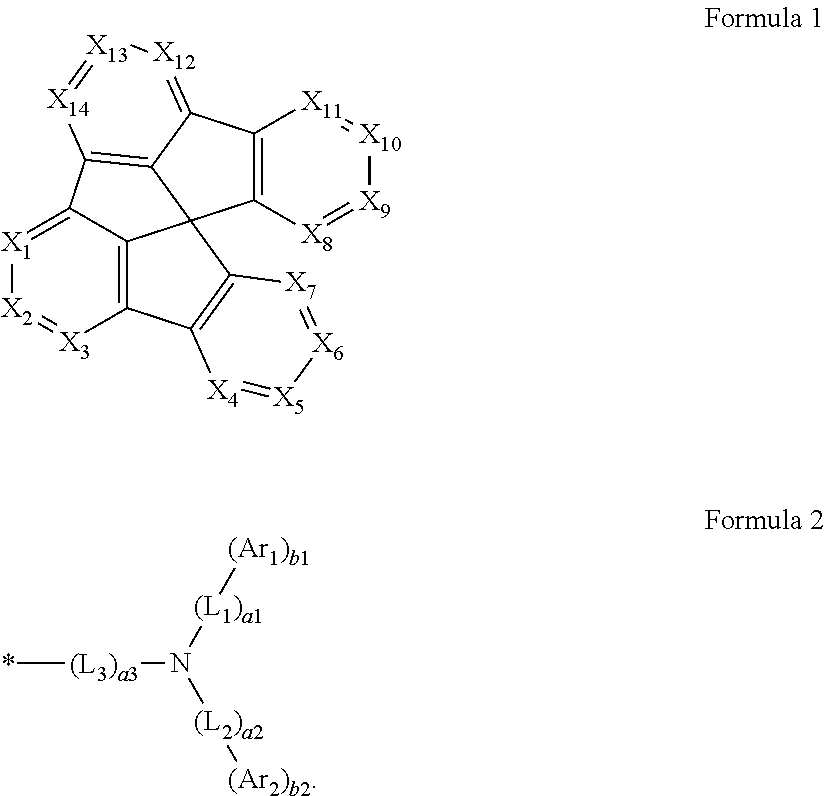











View All Diagrams
| United States Patent Application | 20210098700 |
| Kind Code | A1 |
| JEONG; Eunjae ; et al. | April 1, 2021 |
CONDENSED-CYCLIC COMPOUND AND ORGANIC LIGHT EMITTING DEVICE INCLUDING THE SAME
Abstract
An organic light-emitting device includes a condensed cyclic compound represented by Formula 1, where at least one of X.sub.4 to X.sub.11 is C(R.sub.x), and R.sub.x is a group represented by Formula 2: ##STR00001## The condensed cyclic compound represented by Formula 1 has a planar conformation because of the single bond linking the 8 and 8' positions of the spirobifluorene moiety. Accordingly, the condensed cyclic compound may provide the organic light-emitting device with suitable hole mobility and thermal stability.
| Inventors: | JEONG; Eunjae; (Yongin-si, KR) ; KIM; Dongjun; (Yongin-si, KR) ; KIM; Minji; (Yongin-si, KR) ; JO; Sohee; (Yongin-si, KR) ; HAN; Sanghyun; (Yongin-si, KR) | ||||||||||
| Applicant: |
|
||||||||||
|---|---|---|---|---|---|---|---|---|---|---|---|
| Family ID: | 1000004780589 | ||||||||||
| Appl. No.: | 16/854170 | ||||||||||
| Filed: | April 21, 2020 |
| Current U.S. Class: | 1/1 |
| Current CPC Class: | H01L 51/0056 20130101; H01L 51/5096 20130101; H01L 51/5072 20130101; H01L 51/0058 20130101; H01L 51/0073 20130101; C07C 211/61 20130101; H01L 51/5056 20130101; H01L 51/5092 20130101; C07D 307/91 20130101; H01L 51/0072 20130101; H01L 51/5088 20130101; C07D 333/76 20130101; C07D 209/88 20130101; H01L 51/0074 20130101; H01L 51/006 20130101; H01L 51/0061 20130101; H01L 51/5012 20130101 |
| International Class: | H01L 51/00 20060101 H01L051/00; C07C 211/61 20060101 C07C211/61; C07D 209/88 20060101 C07D209/88; C07D 307/91 20060101 C07D307/91; C07D 333/76 20060101 C07D333/76 |
Foreign Application Data
| Date | Code | Application Number |
|---|---|---|
| Sep 27, 2019 | KR | 10-2019-0119827 |
Claims
1. An organic light-emitting device comprising: a first electrode; a second electrode facing the first electrode; an organic layer between the first electrode and the second electrode and comprising an emission layer; and at least one condensed cyclic compound represented by Formula 1: ##STR00198## wherein, in Formulae 1 and 2, X.sub.1 is N or C(R.sub.1), X.sub.2 is N or C(R.sub.2), X.sub.3 is N or C(R.sub.3), X.sub.4 is N, C(R.sub.4), or C(R.sub.x), X.sub.5 is N, C(R.sub.5), or C(R.sub.x), X.sub.6 is N, C(R.sub.6), or C(R.sub.x), X.sub.7 is N, C(R.sub.7), or C(R.sub.x), X.sub.8 is N, C(R.sub.8), or C(R.sub.x), X.sub.9 is N, C(R.sub.9), or C(R.sub.x), X.sub.10 is N, C(R.sub.10), or C(R.sub.x), X.sub.11 is N, C(R.sub.11), or C(R.sub.x), X.sub.12 is N or C(R.sub.12), X.sub.13 is N or C(R.sub.13), and X.sub.14 is N or C(R.sub.14), at least one selected from X.sub.4 to X.sub.11 is C(R.sub.x), and R.sub.x is a group represented by Formula 2, L.sub.1 to L.sub.3 are each independently selected from a substituted or unsubstituted C.sub.5-C.sub.60 carbocyclic group and a substituted or unsubstituted C.sub.1-C.sub.60 heterocyclic group, a1 to a3 are each independently an integer from 0 to 3, when a1 is 0, -(L.sub.1).sub.a1- is a single bond, when a2 is 0, -(L.sub.2).sub.a2- is a single bond, and when a3 is 0, -(L.sub.3).sub.a3- is a single bond, Ar.sub.1 and Ar.sub.2 are each independently selected from a substituted or unsubstituted C.sub.6-C.sub.60 aryl group, a substituted or unsubstituted C.sub.1-C.sub.60 heteroaryl group, a substituted or unsubstituted monovalent non-aromatic condensed polycyclic group, and a substituted or unsubstituted monovalent non-aromatic condensed heteropolycyclic group, b1 and b2 are each independently an integer from 1 to 5, R.sub.1 to R.sub.14 are each independently selected from hydrogen, deuterium, --F --Cl, --Br, --I, a hydroxyl group, a cyano group, a nitro group, an amidino group, a hydrazino group, a hydrazono group, a substituted or unsubstituted C.sub.1-C.sub.60 alkyl group, a substituted or unsubstituted C.sub.2-C.sub.60 alkenyl group, a substituted or unsubstituted C.sub.2-C.sub.60 alkynyl group, a substituted or unsubstituted C.sub.1-C.sub.60 alkoxy group, a substituted or unsubstituted C.sub.3-C.sub.10 cycloalkyl group, a substituted or unsubstituted C.sub.1-C.sub.10 heterocycloalkyl group, a substituted or unsubstituted C.sub.3-C.sub.10 cycloalkenyl group, a substituted or unsubstituted C.sub.1-C.sub.10 heterocycloalkenyl group, a substituted or unsubstituted C.sub.6-C.sub.60 aryl group, a substituted or unsubstituted C.sub.6-C.sub.60 aryloxy group, a substituted or unsubstituted C.sub.6-C.sub.60 arylthio group, a substituted or unsubstituted C.sub.1-C.sub.60 heteroaryl group, a substituted or unsubstituted monovalent non-aromatic condensed polycyclic group, a substituted or unsubstituted monovalent non-aromatic condensed heteropolycyclic group, --Si(Q.sub.1)(Q.sub.2)(Q.sub.3), --N(Q.sub.1)(Q.sub.2), --B(Q.sub.1)(Q.sub.2), --C(.dbd.O)(Q.sub.1), --S(.dbd.O).sub.2(Q.sub.1), and --P(.dbd.O)(Q.sub.1)(Q.sub.2), and at least one substituent of the substituted C.sub.5-C.sub.60 carbocyclic group, the substituted C.sub.1-C.sub.60 heterocyclic group, the substituted C.sub.1-C.sub.60 alkyl group, the substituted C.sub.2-C.sub.60 alkenyl group, the substituted C.sub.2-C.sub.60 alkynyl group, the substituted C.sub.1-C.sub.60 alkoxy group, the substituted C.sub.3-C.sub.10 cycloalkyl group, the substituted C.sub.1-C.sub.10 heterocycloalkyl group, the substituted C.sub.3-C.sub.10 cycloalkenyl group, the substituted C.sub.1-C.sub.10 heterocycloalkenyl group, the substituted C.sub.6-C.sub.60 aryl group, the substituted C.sub.6-C.sub.60 aryloxy group, the substituted C.sub.6-C.sub.60 arylthio group, the substituted C.sub.1-C.sub.60 heteroaryl group, the substituted monovalent non-aromatic condensed polycyclic group, and the substituted monovalent non-aromatic condensed heteropolycyclic group is selected from: deuterium, --F, --Cl, --Br, --I, a hydroxyl group, a cyano group, a nitro group, an amidino group, a hydrazino group, a hydrazono group, a C.sub.1-C.sub.60 alkyl group, a C.sub.2-C.sub.60 alkenyl group, a C.sub.2-C.sub.60 alkynyl group, and a C.sub.1-C.sub.60 alkoxy group; a C.sub.1-C.sub.60 alkyl group, a C.sub.2-C.sub.60 alkenyl group, a C.sub.2-C.sub.60 alkynyl group, and a C.sub.1-C.sub.60 alkoxy group, each independently substituted with at least one selected from deuterium, --F, --Cl, --Br, --I, a hydroxyl group, a cyano group, a nitro group, an amidino group, a hydrazino group, a hydrazono group, a C.sub.3-C.sub.10 cycloalkyl group, a C.sub.1-C.sub.10 heterocycloalkyl group, a C.sub.3-C.sub.10 cycloalkenyl group, a C.sub.1-C.sub.10 heterocycloalkenyl group, a C.sub.6-C.sub.60 aryl group, a C.sub.6-C.sub.60 aryloxy group, a C.sub.6-C.sub.60 arylthio group, a C.sub.1-C.sub.60 heteroaryl group, a monovalent non-aromatic condensed polycyclic group, a monovalent non-aromatic condensed heteropolycyclic group, --Si(Q.sub.11)(Q.sub.12)(Q.sub.13), --N(Q.sub.11)(Q.sub.12), --B(Q.sub.11)(Q.sub.12), --C(.dbd.O)(Q.sub.11), --S(.dbd.O).sub.2(Q.sub.11), and --P(.dbd.O)(Q.sub.11)(Q.sub.12); a C.sub.3-C.sub.10 cycloalkyl group, a C.sub.1-C.sub.10 heterocycloalkyl group, a C.sub.3-C.sub.10 cycloalkenyl group, a C.sub.1-C.sub.10 heterocycloalkenyl group, a C.sub.6-C.sub.60 aryl group, a C.sub.6-C.sub.60 aryloxy group, a C.sub.6-C.sub.60 arylthio group, a C.sub.1-C.sub.60 heteroaryl group, a monovalent non-aromatic condensed polycyclic group, and a monovalent non-aromatic condensed heteropolycyclic group; a C.sub.3-C.sub.10 cycloalkyl group, a C.sub.1-C.sub.10 heterocycloalkyl group, a C.sub.3-C.sub.10 cycloalkenyl group, a C.sub.1-C.sub.10 heterocycloalkenyl group, a C.sub.6-C.sub.60 aryl group, a C.sub.6-C.sub.60 aryloxy group, a C.sub.6-C.sub.60 arylthio group, a C.sub.1-C.sub.60 heteroaryl group, a monovalent non-aromatic condensed polycyclic group, and a monovalent non-aromatic condensed heteropolycyclic group, each independently substituted with at least one selected from deuterium, --F, --Cl, --Br, --I, a hydroxyl group, a cyano group, a nitro group, an amidino group, a hydrazino group, a hydrazono group, a C.sub.1-C.sub.60 alkyl group, a C.sub.2-C.sub.60 alkenyl group, a C.sub.2-C.sub.60 alkynyl group, a C.sub.1-C.sub.60 alkoxy group, a C.sub.3-C.sub.10 cycloalkyl group, a C.sub.10 heterocycloalkyl group, a C.sub.3-C.sub.10 cycloalkenyl group, a C.sub.1-C.sub.10 heterocycloalkenyl group, a C.sub.6-C.sub.60 aryl group, a C.sub.6-C.sub.60 aryloxy group, a C.sub.6-C.sub.60 arylthio group, a C.sub.1-C.sub.60 heteroaryl group, a monovalent non-aromatic condensed polycyclic group, a monovalent non-aromatic condensed heteropolycyclic group, --Si(Q.sub.21)(Q.sub.22)(Q.sub.23), --N(Q.sub.21)(Q.sub.22), --B(Q.sub.21)(Q.sub.22), --C(.dbd.O)(Q.sub.21), --S(.dbd.O).sub.2(Q.sub.21), and --P(.dbd.O)(Q.sub.21)(Q.sub.22), and --Si(Q.sub.31)(Q.sub.32)(Q.sub.33), --N(Q.sub.31)(Q.sub.32), --B(Q.sub.31)(Q.sub.32), --C(.dbd.O)(Q.sub.31), --S(.dbd.O).sub.2(Q.sub.31), and --P(.dbd.O)(Q.sub.31)(Q.sub.32), wherein Q.sub.1 to Q.sub.3, Q.sub.11 to Q.sub.13, Q.sub.21 to Q.sub.23, and Q.sub.31 to Q.sub.33 are each independently selected from hydrogen, deuterium, --F, --Cl, --Br, --I, a hydroxyl group, a cyano group, a nitro group, an amino group, an amidino group, a hydrazino group, a hydrazono group, a C.sub.1-C.sub.60 alkyl group, a C.sub.2-C.sub.60 alkenyl group, a C.sub.2-C.sub.60 alkynyl group, a C.sub.1-C.sub.60 alkoxy group, a C.sub.3-C.sub.10 cycloalkyl group, a C.sub.1-C.sub.10 heterocycloalkyl group, a C.sub.3-C.sub.10 cycloalkenyl group, a C.sub.1-C.sub.10 heterocycloalkenyl group, a C.sub.6-C.sub.60 aryl group, a C.sub.1-C.sub.60 heteroaryl group, a monovalent non-aromatic condensed polycyclic group, a monovalent non-aromatic condensed heteropolycyclic group, a biphenyl group, and a terphenyl group; and * indicates a binding site to a neighboring atom.
2. The organic light-emitting device of claim 1, wherein: the first electrode is an anode, the second electrode is a cathode, the organic layer further comprises a hole transport region between the first electrode and the emission layer and an electron transport region between the emission layer and the second electrode, the hole transport region comprises a hole injection layer, a hole transport layer, an emission auxiliary layer, an electron blocking layer, or any combination thereof, and the electron transport region comprises a buffer layer, a hole blocking layer, an electron transport layer, an electron injection layer, or any combination thereof.
3. The organic light-emitting device of claim 2, wherein the hole transport region comprises the at least one condensed cyclic compound represented by Formula 1.
4. The organic light-emitting device of claim 2, wherein: the hole transport region comprises at least one selected from a hole injection layer and a hole transport layer, the at least one selected from the hole injection layer and the hole transport layer comprising the at least one condensed cyclic compound represented by Formula 1.
5. The organic light-emitting device of claim 1, further comprising: at least one selected from a first capping layer located under the first electrode and facing the second electrode and a second capping layer located above the second electrode and facing the first electrode, the at least one selected from the first capping layer and the second capping layer comprising the at least one condensed cyclic compound represented by Formula 1.
6. The organic light-emitting device of claim 1, wherein the emission layer comprises the at least one condensed cyclic compound represented by Formula 1.
7. The organic light-emitting device of claim 6, wherein: the emission layer further comprises a dopant, and the at least one condensed cyclic compound is a host, and the at least one condensed cyclic compound is greater in amount than the dopant.
8. A condensed cyclic compound represented by Formula 1: ##STR00199## wherein, in Formulae 1 and 2, X.sub.1 is N or C(R.sub.1), X.sub.2 is N or C(R.sub.2), X.sub.3 is N or C(R.sub.3), X.sub.4 is N, C(R.sub.4), or C(R.sub.x), X.sub.5 is N, C(R.sub.5), or C(R.sub.x), X.sub.6 is N, C(R.sub.6), or C(R.sub.x), X.sub.7 is N, C(R.sub.7), or C(R.sub.x), X.sub.8 is N, C(R.sub.8), or C(R.sub.x), X.sub.9 is N, C(R.sub.9), or C(R.sub.x), X.sub.10 is N, C(R.sub.10), or C(R.sub.x), X.sub.11 is N, C(R.sub.11), or C(R.sub.x), X.sub.12 is N or C(R.sub.12), X.sub.13 is N or C(R.sub.13), and X.sub.14 is N or C(R.sub.14), at least one selected from X.sub.4 to X.sub.11 is C(R.sub.x), and R.sub.x is a group represented by Formula 2, L.sub.1 to L.sub.3 are each independently selected from a substituted or unsubstituted C.sub.5-C.sub.60 carbocyclic group and a substituted or unsubstituted C.sub.1-C.sub.60 heterocyclic group, a1 to a3 are each independently an integer from 0 to 3, when a1 is 0, -(L.sub.1).sub.a1- is a single bond, when a2 is 0, -(L.sub.2).sub.a2- is a single bond, and when a3 is 0, -(L.sub.3).sub.a3- is a single bond, Ar.sub.1 and Ar.sub.2 are each independently selected from a substituted or unsubstituted C.sub.6-C.sub.60 aryl group, a substituted or unsubstituted C.sub.1-C.sub.60 heteroaryl group, a substituted or unsubstituted monovalent non-aromatic condensed polycyclic group, and a substituted or unsubstituted monovalent non-aromatic condensed heteropolycyclic group, b1 and b2 are each independently an integer from 1 to 5, R.sub.1 to R.sub.14 are each independently selected from hydrogen, deuterium, --F --Cl, --Br, --I, a hydroxyl group, a cyano group, a nitro group, an amidino group, a hydrazino group, a hydrazono group, a substituted or unsubstituted C.sub.1-C.sub.60 alkyl group, a substituted or unsubstituted C.sub.2-C.sub.60 alkenyl group, a substituted or unsubstituted C.sub.2-C.sub.60 alkynyl group, a substituted or unsubstituted C.sub.1-C.sub.60 alkoxy group, a substituted or unsubstituted C.sub.3-C.sub.10 cycloalkyl group, a substituted or unsubstituted C.sub.1-C.sub.10 heterocycloalkyl group, a substituted or unsubstituted C.sub.3-C.sub.10 cycloalkenyl group, a substituted or unsubstituted C.sub.1-C.sub.10 heterocycloalkenyl group, a substituted or unsubstituted C.sub.6-C.sub.60 aryl group, a substituted or unsubstituted C.sub.6-C.sub.60 aryloxy group, a substituted or unsubstituted C.sub.6-C.sub.60 arylthio group, a substituted or unsubstituted C.sub.1-C.sub.60 heteroaryl group, a substituted or unsubstituted monovalent non-aromatic condensed polycyclic group, a substituted or unsubstituted monovalent non-aromatic condensed heteropolycyclic group, --Si(Q.sub.1)(Q.sub.2)(Q.sub.3), --N(Q.sub.1)(Q.sub.2), --B(Q.sub.1)(Q.sub.2), --C(.dbd.O)(Q.sub.1), --S(.dbd.O).sub.2(Q.sub.1), and --P(.dbd.O)(Q.sub.1)(Q.sub.2), at least one substituent of the substituted C.sub.5-C.sub.60 carbocyclic group, the substituted C.sub.1-C.sub.60 heterocyclic group, the substituted C.sub.1-C.sub.60 alkyl group, the substituted C.sub.2-C.sub.60 alkenyl group, the substituted C.sub.2-C.sub.60 alkynyl group, the substituted C.sub.1-C.sub.60 alkoxy group, the substituted C.sub.3-C.sub.10 cycloalkyl group, the substituted C.sub.1-C.sub.10 heterocycloalkyl group, the substituted C.sub.3-C.sub.10 cycloalkenyl group, the substituted C.sub.1-C.sub.10 heterocycloalkenyl group, the substituted C.sub.6-C.sub.60 aryl group, the substituted C.sub.6-C.sub.60 aryloxy group, the substituted C.sub.6-C.sub.60 arylthio group, the substituted C.sub.1-C.sub.60 heteroaryl group, the substituted monovalent non-aromatic condensed polycyclic group, and the substituted monovalent non-aromatic condensed heteropolycyclic group is selected from: deuterium, --F, --Cl, --Br, --I, a hydroxyl group, a cyano group, a nitro group, an amidino group, a hydrazino group, a hydrazono group, a C.sub.1-C.sub.60 alkyl group, a C.sub.2-C.sub.60 alkenyl group, a C.sub.2-C.sub.60 alkynyl group, and a C.sub.1-C.sub.60 alkoxy group; a C.sub.1-C.sub.60 alkyl group, a C.sub.2-C.sub.60 alkenyl group, a C.sub.2-C.sub.60 alkynyl group, and a C.sub.1-C.sub.60 alkoxy group, each independently substituted with at least one selected from deuterium, --F, --Cl, --Br, --I, a hydroxyl group, a cyano group, a nitro group, an amidino group, a hydrazino group, a hydrazono group, a C.sub.3-C.sub.10 cycloalkyl group, a C.sub.1-C.sub.10 heterocycloalkyl group, a C.sub.3-C.sub.10 cycloalkenyl group, a C.sub.1-C.sub.10 heterocycloalkenyl group, a C.sub.6-C.sub.60 aryl group, a C.sub.6-C.sub.60 aryloxy group, a C.sub.6-C.sub.60 arylthio group, a C.sub.1-C.sub.60 heteroaryl group, a monovalent non-aromatic condensed polycyclic group, a monovalent non-aromatic condensed heteropolycyclic group, --Si(Q.sub.11)(Q.sub.12)(Q.sub.13), --N(Q.sub.11)(Q.sub.12), --B(Q.sub.11)(Q.sub.12), --C(.dbd.O)(Q.sub.11), --S(.dbd.O).sub.2(Q.sub.11), and --P(.dbd.O)(Q.sub.11)(Q.sub.12); a C.sub.3-C.sub.10 cycloalkyl group, a C.sub.1-C.sub.10 heterocycloalkyl group, a C.sub.3-C.sub.10 cycloalkenyl group, a C.sub.1-C.sub.10 heterocycloalkenyl group, a C.sub.6-C.sub.60 aryl group, a C.sub.6-C.sub.60 aryloxy group, a C.sub.6-C.sub.60 arylthio group, a C.sub.1-C.sub.60 heteroaryl group, a monovalent non-aromatic condensed polycyclic group, and a monovalent non-aromatic condensed heteropolycyclic group; a C.sub.3-C.sub.10 cycloalkyl group, a C.sub.1-C.sub.10 heterocycloalkyl group, a C.sub.3-C.sub.10 cycloalkenyl group, a C.sub.1-C.sub.10 heterocycloalkenyl group, a C.sub.6-C.sub.60 aryl group, a C.sub.6-C.sub.60 aryloxy group, a C.sub.6-C.sub.60 arylthio group, a C.sub.1-C.sub.60 heteroaryl group, a monovalent non-aromatic condensed polycyclic group, and a monovalent non-aromatic condensed heteropolycyclic group, each independently substituted with at least one selected from deuterium, --F, --Cl, --Br, --I, a hydroxyl group, a cyano group, a nitro group, an amidino group, a hydrazino group, a hydrazono group, a C.sub.1-C.sub.60 alkyl group, a C.sub.2-C.sub.60 alkenyl group, a C.sub.2-C.sub.60 alkynyl group, a C.sub.1-C.sub.60 alkoxy group, a C.sub.3-C.sub.10 cycloalkyl group, a C.sub.10 heterocycloalkyl group, a C.sub.3-C.sub.10 cycloalkenyl group, a C.sub.1-C.sub.10 heterocycloalkenyl group, a C.sub.6-C.sub.60 aryl group, a C.sub.6-C.sub.60 aryloxy group, a C.sub.6-C.sub.60 arylthio group, a C.sub.1-C.sub.60 heteroaryl group, a monovalent non-aromatic condensed polycyclic group, a monovalent non-aromatic condensed heteropolycyclic group, --Si(Q.sub.21)(Q.sub.22)(Q.sub.23), --N(Q.sub.21)(Q.sub.22), --B(Q.sub.21)(Q.sub.22), --C(.dbd.O)(Q.sub.21), --S(.dbd.O).sub.2(Q.sub.21), and --P(.dbd.O)(Q.sub.21)(Q.sub.22); and --Si(Q.sub.31)(Q.sub.32)(Q.sub.33), --N(Q.sub.31)(Q.sub.32), --B(Q.sub.31)(Q.sub.32), --C(.dbd.O)(Q.sub.31), --S(.dbd.O).sub.2(Q.sub.31), and --P(.dbd.O)(Q.sub.31)(Q.sub.32), wherein Q.sub.1 to Q.sub.3, Q.sub.11 to Q.sub.13, Q.sub.21 to Q.sub.23, and Q.sub.31 to Q.sub.33 are each independently selected from hydrogen, deuterium, --F, --Cl, --Br, --I, a hydroxyl group, a cyano group, a nitro group, an amino group, an amidino group, a hydrazino group, a hydrazono group, a C.sub.1-C.sub.60 alkyl group, a C.sub.2-C.sub.60 alkenyl group, a C.sub.2-C.sub.60 alkynyl group, a C.sub.1-C.sub.60 alkoxy group, a C.sub.3-C.sub.10 cycloalkyl group, a C.sub.1-C.sub.10 heterocycloalkyl group, a C.sub.3-C.sub.10 cycloalkenyl group, a C.sub.1-C.sub.10 heterocycloalkenyl group, a C.sub.6-C.sub.60 aryl group, a C.sub.1-C.sub.60 heteroaryl group, a monovalent non-aromatic condensed polycyclic group, a monovalent non-aromatic condensed heteropolycyclic group, a biphenyl group, and a terphenyl group; and * indicates a binding site to a neighboring atom.
9. The condensed cyclic compound of claim 8, wherein: L.sub.1 to L.sub.3 are each independently selected from a benzene group, a pentalene group, an indene group, a naphthalene group, an azulene group, a heptalene group, an indacene group, an acenaphthene group, a fluorene group, a spiro-bifluorene group, a benzofluorene group, a phenalene group, a phenanthrene group, an anthracene group, a fluoranthene group, a triphenylene group, a pyrene group, a chrysene group, a naphthacene group, a picene group, a perylene group, a pentaphene group, a hexacene group, a pyrrole group, an imidazole group, a pyrazole group, a pyridine group, a pyrazine group, a pyrimidine group, a pyridazine group, an isoindole group, an indole group, an indazole group, a purine group, a quinoline group, an isoquinoline group, a benzoquinoline group, a phthalazine group, a naphthyridine group, a quinoxaline group, a quinazoline group, a cinnoline group, a carbazole group, a dibenzosilole group, a phenanthridine group, an acridine group, a phenanthroline group, a phenazine group, a benzoxazole group, a benzimidazole group, a furan group, a benzofuran group, a thiophene group, a benzothiophene group, a thiazole group, an isothiazole group, a benzothiazole group, an isooxazole group, an oxazole group, a triazole group, a tetrazole group, an oxadiazole group, a triazine group, a benzoxazole group, a dibenzofuran group, a dibenzothiophene group, a benzocarbazole group, a dibenzocarbazole group, and a dibenzosilole group; and a benzene group, a pentalene group, an indene group, a naphthalene group, an azulene group, a heptalene group, an indacene group, an acenaphthene group, a fluorene group, a spiro-bifluorene group, a benzofluorene group, a phenalene group, a phenanthrene group, an anthracene group, a fluoranthene group, a triphenylene group, a pyrene group, a chrysene group, a naphthacene group, a picene group, a perylene group, a pentaphene group, a hexacene group, a pyrrole group, an imidazole group, a pyrazole group, a pyridine group, a pyrazine group, a pyrimidine group, a pyridazine group, an isoindole group, an indole group, an indazole group, a purine group, a quinoline group, an isoquinoline group, a benzoquinoline group, a phthalazine group, a naphthyridine group, a quinoxaline group, a quinazoline group, a cinnoline group, a carbazole group, a dibenzosilole group, a phenanthridine group, an acridine group, a phenanthroline group, a phenazine group, a benzoxazole group, a benzimidazole group, a furan group, a benzofuran group, a thiophene group, a benzothiophene group, a thiazole group, an isothiazole group, a benzothiazole group, an isooxazole group, an oxazole group, a triazole group, a tetrazole group, an oxadiazole group, a triazine group, a benzoxazole group, a dibenzofuran group, a dibenzothiophene group, a benzocarbazole group, a dibenzocarbazole group, and a dibenzosilole group, each independently substituted with at least one selected from deuterium, --F, --Cl, --Br, --I, a hydroxyl group, a cyano group, a nitro group, an amidino group, a hydrazino group, a hydrazono group, a C.sub.1-C.sub.20 alkyl group, a C.sub.1-C.sub.20 alkoxy group, a phenyl group, a pentalenyl group, an indenyl group, a naphthyl group, an azulenyl group, a heptalenyl group, an indacenyl group, an acenaphthenyl group, a fluorenyl group, a spiro-bifluorenyl group, a benzofluorenyl group, a phenalenyl group, a phenanthrenyl group, an anthracenyl group, a fluoranthenyl group, a triphenylenyl group, a pyrenyl group, a chrysenyl group, a naphthacenyl group, a picenyl group, a perylenyl group, a pentaphenylenyl group, a hexacenyl group, a pyrrolyl group, an imidazolyl group, a pyrazolyl group, a pyridinyl group, a pyrazinyl group, a pyrimidinyl group, a pyridazinyl group, an isoindolyl group, an indolyl group, an indazolyl group, a purinyl group, a quinolinyl group, an isoquinolinyl group, a benzoquinolinyl group, a phthalazinyl group, a naphthyridinyl group, a quinoxalinyl group, a quinazolinyl group, a cinnolinyl group, a carbazolyl group, a dibenzosilolyl group, a phenanthridinyl group, an acridinyl group, a phenanthrolinyl group, a phenazinyl group, a benzoxazolyl group, a benzimidazolyl group, a furanyl group, a benzofuranyl group, a thiophenyl group, a benzothiophenyl group, a thiazolyl group, an isothiazolyl group, a benzothiazolyl group, an isoxazolyl group, an oxazolyl group, a triazolyl group, a tetrazolyl group, an oxadiazolyl group, a triazinyl group, a benzoxazolyl group, a dibenzofuranyl group, a dibenzothiophenyl group, a benzocarbazolyl group, a dibenzocarbazolyl group, a dibenzosilolyl group, --Si(Q.sub.31)(Q.sub.32)(Q.sub.33), --N(Q.sub.31)(Q.sub.32), and --B(Q.sub.31)(Q.sub.32), and Q.sub.31 to Q.sub.33 are each independently selected from hydrogen, deuterium, --F, --Cl, --Br, --I, a hydroxyl group, a cyano group, a nitro group, an amino group, an amidino group, a hydrazino group, a hydrazono group, a C.sub.1-C.sub.60 alkyl group, a C.sub.2-C.sub.60 alkenyl group, a C.sub.2-C.sub.60 alkynyl group, a C.sub.1-C.sub.60 alkoxy group, a C.sub.3-C.sub.10 cycloalkyl group, a C.sub.1-C.sub.10 heterocycloalkyl group, a C.sub.3-C.sub.10 cycloalkenyl group, a C.sub.1-C.sub.10 heterocycloalkenyl group, a C.sub.6-C.sub.60 aryl group, a C.sub.1-C.sub.60 heteroaryl group, a monovalent non-aromatic condensed polycyclic group, a monovalent non-aromatic condensed heteropolycyclic group, a biphenyl group, and a terphenyl group.
10. The condensed cyclic compound of claim 8, wherein: L.sub.1 to L.sub.3 are each independently a group represented by one selected from Formulae 3-1 to 3-43: ##STR00200## ##STR00201## ##STR00202## ##STR00203## ##STR00204## ##STR00205## ##STR00206## wherein, in Formulae 3-1 to 3-43, Y.sub.1 is O, S, C(Z.sub.3)(Z.sub.4), N(Z.sub.5), or Si(Z.sub.6)(Z.sub.7), Z.sub.1 to Z.sub.7 are each independently selected from hydrogen, deuterium, --F, --Cl, --Br, --I, a hydroxyl group, a cyano group, a nitro group, an amidino group, a hydrazino group, a hydrazono group, a carboxylic acid or a salt thereof, a sulfonic acid or a salt thereof, a phosphoric acid or a salt thereof, a C.sub.1-C.sub.20 alkyl group, a C.sub.1-C.sub.20 alkoxy group, a phenyl group, a biphenyl group, a terphenyl group, a naphthyl group, a fluorenyl group, a spiro-bifluorenyl group, a benzofluorenyl group, a dibenzofluorenyl group, a phenanthrenyl group, an anthracenyl group, a pyrenyl group, a chrysenyl group, a pyridinyl group, a pyrazinyl group, a pyrimidinyl group, a pyridazinyl group, a quinolinyl group, an isoquinolinyl group, a quinoxalinyl group, a quinazolinyl group, a carbazolyl group, a dibenzofuranyl group, a dibenzothiophenyl group, a triazinyl group, a benzimidazolyl group, a phenanthrolinyl group, --Si(Q.sub.31)(Q.sub.32)(Q.sub.33), --N(Q.sub.31)(Q.sub.32), and --B(Q.sub.31)(Q.sub.32), Q.sub.31 to Q.sub.33 are each independently selected from a C.sub.1-C.sub.20 alkyl group, a C.sub.1-C.sub.20 alkoxy group, a phenyl group, a biphenyl group, a terphenyl group, a naphthyl group, and a pyridinyl group, d2 is an integer from 0 to 2, d3 is an integer from 0 to 3, d4 is an integer from 0 to 4, d5 is an integer from 0 to 5, d6 is an integer from 0 to 6, d8 is an integer from 0 to 8, and * and *' each indicate a binding site to a neighboring atom.
11. The condensed cyclic compound of claim 8, wherein a1 to a3 are each independently 0 or 1.
12. The condensed cyclic compound of claim 8, wherein: Ar.sub.1 and Ar.sub.2 are each independently selected from a cyclopentyl group, a cyclohexyl group, a cycloheptyl group, a cyclopentenyl group, a cyclohexenyl group, a phenyl group, a pentalenyl group, an indenyl group, a naphthyl group, an azulenyl group, a heptalenyl group, an indacenyl group, an acenaphthyl group, a fluorenyl group, a spiro-bifluorenyl group, a spiro-cyclopentane-fluorenyl group, a spiro-cyclohexane-fluorenyl group, a spiro-fluorene-benzofluorenyl group, a benzofluorenyl group, a dibenzofluorenyl group, a phenalenyl group, a phenanthrenyl group, an anthracenyl group, a fluoranthenyl group, a triphenylenyl group, a pyrenyl group, a chrysenyl group, a naphthacenyl group, a picenyl group, a perylenyl group, a pentaphenyl group, a hexacenyl group, a pyrrolyl group, an imidazolyl group, a pyrazolyl group, a pyridinyl group, a pyrazinyl group, a pyrimidinyl group, a pyridazinyl group, an isoindolyl group, an indolyl group, an indazolyl group, a purinyl group, a quinolinyl group, an isoquinolinyl group, a benzoquinolinyl group. a phthalazinyl group, a naphthyridinyl group, a quinoxalinyl group, a quinazolinyl group, a cinnolinyl group, a carbazolyl group, a phenanthridinyl group, an acridinyl group, a phenanthrolinyl group, a phenazinyl group, a benzoxazolyl group, a benzimidazolyl group, a furanyl group, a benzofuranyl group, a thiophenyl group, a benzothiophenyl group, a thiazolyl group, an isothiazolyl group, a benzothiazolyl group, an isoxazolyl group, an oxazolyl group, a triazolyl group, a tetrazolyl group, an oxadiazolyl group, a triazinyl group, a benzoxazolyl group, a dibenzofuranyl group, a dibenzothiophenyl group, a benzocarbazolyl group, a dibenzocarbazolyl group, and a dibenzosilolyl group; a cyclopentyl group, a cyclohexyl group, a cycloheptyl group, a cyclopentenyl group, a cyclohexenyl group, a phenyl group, a pentalenyl group, an indenyl group, a naphthyl group, an azulenyl group, a heptalenyl group, an indacenyl group, an acenaphthyl group, a fluorenyl group, a spiro-bifluorenyl group, a spiro-cyclopentane-fluorenyl group, a spiro-cyclohexane-fluorenyl group, a spiro-fluorene-benzofluorenyl group, a benzofluorenyl group, a dibenzofluorenyl group, a phenalenyl group, a phenanthrenyl group, an anthracenyl group, a fluoranthenyl group, a triphenylenyl group, a pyrenyl group, a chrysenyl group, a naphthacenyl group, a picenyl group, a perylenyl group, a pentaphenyl group, a hexacenyl group, a pyrrolyl group, an imidazolyl group, a pyrazolyl group, a pyridinyl group, a pyrazinyl group, a pyrimidinyl group, a pyridazinyl group, an isoindolyl group, an indolyl group, an indazolyl group, a purinyl group, a quinolinyl group, an isoquinolinyl group, a benzoquinolinyl group, a phthalazinyl group, a naphthyridinyl group, a quinoxalinyl group, a quinazolinyl group, a cinnolinyl group, a carbazolyl group, a phenanthridinyl group, an acridinyl group, a phenanthrolinyl group, a phenazinyl group, a benzoxazolyl group, a benzimidazolyl group, a furanyl group, a benzofuranyl group, a thiophenyl group, a benzothiophenyl group, a thiazolyl group, an isothiazolyl group, a benzothiazolyl group, an isoxazolyl group, an oxazolyl group, a triazolyl group, a tetrazolyl group, an oxadiazolyl group, a triazinyl group, a benzoxazolyl group, a dibenzofuranyl group, a dibenzothiophenyl group, a benzocarbazolyl group, a dibenzocarbazolyl group, and a dibenzosilolyl group, each independently substituted with at least one selected from deuterium, --F, --Cl, --Br, --I, a hydroxyl group, a cyano group, a nitro group, an amidino group, a hydrazino group, a hydrazono group, a C.sub.1-C.sub.20 alkyl group, a C.sub.1-C.sub.20 alkoxy group, a cyclopentyl group, a cyclohexyl group, a cycloheptyl group, a cyclopentenyl group, a cyclohexenyl group, a phenyl group, a pentalenyl group, an indenyl group, a naphthyl group, an azulenyl group, a heptalenyl group, an indacenyl group, an acenaphthyl group, a fluorenyl group, a spiro-bifluorenyl group, a spiro-cyclopentane-fluorenyl group, a spiro-cyclohexane-fluorenyl group, a spiro-fluorene-benzofluorenyl group, a benzofluorenyl group, a dibenzofluorenyl group, a phenalenyl group, a phenanthrenyl group, an anthracenyl group, a fluoranthenyl group, a triphenylenyl group, a pyrenyl group, a chrysenyl group, a naphthacenyl group, a picenyl group, a perylenyl group, a pentaphenyl group, a hexacenyl group, a pyrrolyl group, an imidazolyl group, a pyrazolyl group, a pyridinyl group, a pyrazinyl group, a pyrimidinyl group, a pyridazinyl group, an isoindolyl group, an indolyl group, an indazolyl group, a purinyl group, a quinolinyl group, an isoquinolinyl group, a benzoquinolinyl group. a phthalazinyl group, a naphthyridinyl group, a quinoxalinyl group, a quinazolinyl group, a cinnolinyl group, a carbazolyl group, a phenanthridinyl group, an acridinyl group, a phenanthrolinyl group, a phenazinyl group, a benzoxazolyl group, a benzimidazolyl group, a furanyl group, a benzofuranyl group, a thiophenyl group, a benzothiophenyl group, a thiazolyl group, an isothiazolyl group, a benzothiazolyl group, an isoxazolyl group, an oxazolyl group, a triazolyl group, a tetrazolyl group, an oxadiazolyl group, a triazinyl group, a benzoxazolyl group, a dibenzofuranyl group, a dibenzothiophenyl group, a benzocarbazolyl group, a dibenzocarbazolyl group, a dibenzosilolyl group, --Si(Q.sub.31)(Q.sub.32)(Q.sub.33), --N(Q.sub.31)(Q.sub.32), and --B(Q.sub.31)(Q.sub.32), and Q.sub.31 to Q.sub.33 are each independently selected from hydrogen, deuterium, --F, --Cl, --Br, --I, a hydroxyl group, a cyano group, a nitro group, an amino group, an amidino group, a hydrazino group, a hydrazono group, a C.sub.1-C.sub.60 alkyl group, a C.sub.2-C.sub.60 alkenyl group, a C.sub.2-C.sub.60 alkynyl group, a C.sub.1-C.sub.60 alkoxy group, a C.sub.3-C.sub.10 cycloalkyl group, a C.sub.1-C.sub.10 heterocycloalkyl group, a C.sub.3-C.sub.10 cycloalkenyl group, a C.sub.1-C.sub.10 heterocycloalkenyl group, a C.sub.6-C.sub.60 aryl group, a C.sub.1-C.sub.60 heteroaryl group, a monovalent non-aromatic condensed polycyclic group, a monovalent non-aromatic condensed heteropolycyclic group, a biphenyl group, and a terphenyl group.
13. The condensed cyclic compound of claim 8, wherein: Ar.sub.1 and Ar.sub.2 are each independently selected from groups represented by Formulae 5-1 to 5-80: ##STR00207## ##STR00208## ##STR00209## ##STR00210## ##STR00211## ##STR00212## ##STR00213## ##STR00214## ##STR00215## wherein, in Formulae 5-1 to 5-80, Y.sub.31 is O, S, C(Z.sub.33)(Z.sub.34), N(Z.sub.35), or Si(Z.sub.36)(Z.sub.37), Z.sub.31 to Z.sub.37 are each independently selected from hydrogen, deuterium, --F, --Cl, --Br, --I, a hydroxyl group, a cyano group, a nitro group, an amidino group, a hydrazino group, a hydrazono group, a C.sub.1-C.sub.20 alkyl group, a C.sub.1-C.sub.20 alkoxy group, a cyclopentyl group, a cyclohexyl group, a cycloheptyl group, a cyclopentenyl group, a cyclohexenyl group, a phenyl group, a biphenyl group, a naphthyl group, a fluorenyl group, a spiro-bifluorenyl group, a spiro-fluorene-benzofluorenyl group, a benzofluorenyl group, a dibenzofluorenyl group, a phenalenyl group, a phenanthrenyl group, an anthracenyl group, a fluoranthenyl group, a triphenylenyl group, a pyridinyl group, a pyrazinyl group, a pyrimidinyl group, a quinolinyl group, an isoquinolinyl group, a benzoquinolinyl group, a naphthyridinyl group, a quinoxalinyl group, a quinazolinyl group, a carbazolyl group, a phenanthridinyl group, an acridinyl group, a phenanthrolinyl group, a phenazinyl group, a triazinyl group, a dibenzofuranyl group, a dibenzothiophenyl group, a dibenzosilolyl group, --Si(Q.sub.31)(Q.sub.32)(Q.sub.33), --N(Q.sub.31)(Q.sub.32), and --B(Q.sub.31)(Q.sub.32), e2 is selected from 1 and 2, e3 is an integer from 1 to 3, e4 is an integer from 1 to 4, e5 is an integer from 1 to 5, e6 is an integer from 1 to 6, e7 is an integer from 1 to 7, e9 is an integer from 1 to 9, Q.sub.31 to Q.sub.33 are each independently selected from a C.sub.1-C.sub.20 alkyl group, a C.sub.1-C.sub.20 alkoxy group, a phenyl group, a biphenyl group, a terphenyl group, a naphthyl group, and a pyridinyl group, and * indicates a binding site to a neighboring atom.
14. The condensed cyclic compound of claim 8, wherein: Ar.sub.1 and Ar.sub.2 are each independently selected from groups represented by Formulae 6-1 to 6-40: ##STR00216## ##STR00217## ##STR00218## ##STR00219## ##STR00220## ##STR00221## wherein, in Formulae 6-1 to 6-40, "Ph" indicates a phenyl group, and * indicates a binding site to a neighboring atom.
15. The condensed cyclic compound of claim 8, wherein: in Formula 2, a group represented by *-(L.sub.1).sub.a1-(Ar.sub.1).sub.b1 and a group represented by *-(L.sub.2).sub.a2-(Ar.sub.2).sub.b2 are each independently selected from groups represented by Formulae 7-1 to 7-37: ##STR00222## ##STR00223## ##STR00224## ##STR00225## ##STR00226## wherein, in Formulae 7-1 to 7-37, "Ph" indicates a phenyl group, and * indicates a binding site to a neighboring atom.
16. The condensed cyclic compound of claim 8, wherein: X.sub.1 is C(R.sub.1), X.sub.2 is C(R.sub.2), X.sub.3 is C(R.sub.3), X.sub.4 is C(R.sub.4) or C(R.sub.x), X.sub.5 is C(R.sub.5) or C(R.sub.x), X.sub.6 is C(R.sub.6) or C(R.sub.x), X.sub.7 is C(R.sub.7) or C(R.sub.x), X.sub.8 is C(R.sub.8) or C(R.sub.x), X.sub.9 is C(R.sub.9) or C(R.sub.x), X.sub.10 is C(R.sub.10) or C(R.sub.x), X.sub.11 is C(R.sub.11) or C(R.sub.x), X.sub.12 is C(R.sub.12), X.sub.13 is C(R.sub.13), and X.sub.14 is C(R.sub.14), and at least one selected from X.sub.4 to X.sub.11 is C(R.sub.x).
17. The condensed cyclic compound of claim 8, wherein: X.sub.1 is C(R.sub.1), X.sub.2 is C(R.sub.2), X.sub.3 is C(R.sub.3), X.sub.4 is C(R.sub.4) or C(R.sub.x), X.sub.5 is C(R.sub.5) or C(R.sub.x), X.sub.6 is C(R.sub.6) or C(R.sub.x), X.sub.7 is C(R.sub.7) or C(R.sub.x), X.sub.8 is C(R.sub.8) or C(R.sub.x), X.sub.9 is C(R.sub.9) or C(R.sub.x), X.sub.10 is C(R.sub.10) or C(R.sub.x), X.sub.11 is C(R.sub.11) or C(R.sub.x), X.sub.12 is C(R.sub.12), X.sub.13 is C(R.sub.13), and X.sub.14 is C(R.sub.14), and one selected from X.sub.4 to X.sub.11 is C(R.sub.x), and the others of X.sub.4 to X.sub.11 are not C(R.sub.x).
18. The condensed cyclic compound of claim 8, wherein the condensed cyclic compound is represented by one selected from Formulae 1-1 to 1-4: ##STR00227## wherein, in Formulae 1-1 to 1-4, X.sub.1 is N or C(R.sub.1), X.sub.2 is N or C(R.sub.2), X.sub.3 is N or C(R.sub.3), X.sub.4 is N or C(R.sub.4), X.sub.5 is N or C(R.sub.5), X.sub.6 is N or C(R.sub.6), X.sub.7 is N or C(R.sub.7), X.sub.8 is N or C(R.sub.8), X.sub.9 is N or C(R.sub.9), X.sub.10 is N or C(R.sub.10), X.sub.11 is N or C(R.sub.11), X.sub.12 is N or C(R.sub.12), X.sub.13 is N or C(R.sub.13), and X.sub.14 is N or C(R.sub.14), and L.sub.1 to L.sub.3, a1 to a3, Ar.sub.1, Ar.sub.2, b1, b2, and R.sub.1 to R.sub.14 are each independently the same as described in connection with Formulae 1 and 2.
19. The condensed cyclic compound of claim 8, wherein: the condensed cyclic compound is represented by one selected from Formulae 1-1A to 1-4A: ##STR00228## wherein, in Formulae 1-1A to 1-4A, L.sub.1 to L.sub.3, a1 to a3, Ar.sub.1, Ar.sub.2, b1, b2, and R.sub.1 to R.sub.14 are each independently the same as described in connection with Formulae 1 and 2.
20. The condensed cyclic compound of claim 8, wherein the condensed cyclic compound is selected from Compounds 1 to 225: ##STR00229## ##STR00230## ##STR00231## ##STR00232## ##STR00233## ##STR00234## ##STR00235## ##STR00236## ##STR00237## ##STR00238## ##STR00239## ##STR00240## ##STR00241## ##STR00242## ##STR00243## ##STR00244## ##STR00245## ##STR00246## ##STR00247## ##STR00248## ##STR00249## ##STR00250## ##STR00251## ##STR00252## ##STR00253## ##STR00254## ##STR00255## ##STR00256## ##STR00257## ##STR00258## ##STR00259## ##STR00260## ##STR00261## ##STR00262## ##STR00263## ##STR00264## ##STR00265## ##STR00266## ##STR00267## ##STR00268## ##STR00269## ##STR00270## ##STR00271## ##STR00272## ##STR00273## ##STR00274## ##STR00275## ##STR00276## ##STR00277## ##STR00278## ##STR00279## ##STR00280## ##STR00281## ##STR00282## ##STR00283##
Description
CROSS-REFERENCE TO RELATED APPLICATION
[0001] This application claims priority to and the benefit of Korean Patent Application No. 10-2019-0119827, filed on Sep. 27, 2019, in the Korean Intellectual Property Office, the entire content of which is incorporated herein by reference.
BACKGROUND
1. Field
[0002] One or more aspects of embodiments of the present disclosure relate to a condensed cyclic compound and an organic light-emitting device including the same.
2. Description of Related Art
[0003] Organic light-emitting devices are self-emission devices that produce full-color images, and may also have wide viewing angles, high contrast ratios, short response times, and/or excellent characteristics in terms of brightness, driving voltage, and/or response speed, compared to devices in the related art.
[0004] An example organic light-emitting device includes a first electrode disposed on a substrate, and a hole transport region, an emission layer, an electron transport region, and a second electrode sequentially disposed on the first electrode. Holes provided from the first electrode may move toward the emission layer through the hole transport region, and electrons provided from the second electrode may move toward the emission layer through the electron transport region. These carriers (holes and electrons) may recombine in the emission layer to produce excitons. These excitons may transition from an excited state to the ground state to thereby generate light.
SUMMARY
[0005] One or more aspects of embodiments of the present disclosure are directed toward a condensed cyclic compound and an organic light-emitting device including the same.
[0006] Additional aspects will be set forth in part in the description which follows and, in part, will be apparent from the description, or may be learned by practice of the presented embodiments of the disclosure.
[0007] One or more example embodiments of the present disclosure provide a condensed cyclic compound represented by Formula 1:
##STR00002##
[0008] In Formulae 1 and 2,
[0009] X.sub.1 may be N or C(R.sub.1), X.sub.2 may be N or C(R.sub.2), X.sub.3 may be N or C(R.sub.3), X.sub.4 may be N, C(R.sub.4) or C(R.sub.x), X.sub.5 may be N, C(R.sub.5) or C(R.sub.x), X.sub.6 may be N, C(R.sub.6) or C(R.sub.x), X.sub.7 may be N, C(R.sub.7) or C(R.sub.x), X.sub.8 may be N, C(R.sub.8) or C(R.sub.x), X.sub.9 may be N, C(R.sub.9) or C(R.sub.x), X.sub.10 may be N, C(R.sub.10) or C(R.sub.x), X.sub.11 may be N, C(R.sub.11) or C(R.sub.x), X.sub.12 may be N or C(R.sub.12), X.sub.13 may be N or C(R.sub.13), and X.sub.14 may be N or C(R.sub.14),
[0010] at least one of X.sub.4 to X.sub.11 may be C(R.sub.x), and R.sub.x may be a group represented by Formula 2,
[0011] L.sub.1 to L.sub.3 may each independently be selected from a substituted or unsubstituted C.sub.5-C.sub.60 carbocyclic group and a substituted or unsubstituted C.sub.1-C.sub.60 heterocyclic group,
[0012] a1 to a3 may each independently be an integer from 0 to 3,
[0013] when a1 is 0, -(L.sub.1).sub.a1- may be a single bond, when a2 is 0, -(L.sub.2).sub.a2- may be a single bond, and when a3 is 0, -(L.sub.3).sub.a3- may be a single bond,
[0014] Ar.sub.1 and Ar.sub.2 may each independently be selected from a substituted or unsubstituted C.sub.6-C.sub.60 aryl group, a substituted or unsubstituted C.sub.1-C.sub.60 heteroaryl group, a substituted or unsubstituted monovalent non-aromatic condensed polycyclic group, and a substituted or unsubstituted monovalent non-aromatic condensed heteropolycyclic group,
[0015] b1 and b2 may each independently be an integer from 1 to 5,
[0016] R.sub.1 to R.sub.14 may each independently be selected from hydrogen, deuterium, --F --Cl, --Br, --I, a hydroxyl group, a cyano group, a nitro group, an amidino group, a hydrazino group, a hydrazono group, a substituted or unsubstituted C.sub.1-C.sub.60 alkyl group, a substituted or unsubstituted C.sub.2-C.sub.60 alkenyl group, a substituted or unsubstituted C.sub.2-C.sub.60 alkynyl group, a substituted or unsubstituted C.sub.1-C.sub.60 alkoxy group, a substituted or unsubstituted C.sub.3-C.sub.10 cycloalkyl group, a substituted or unsubstituted C.sub.1-C.sub.10 heterocycloalkyl group, a substituted or unsubstituted C.sub.3-C.sub.10 cycloalkenyl group, a substituted or unsubstituted C.sub.1-C.sub.10 heterocycloalkenyl group, a substituted or unsubstituted C.sub.6-C.sub.60 aryl group, a substituted or unsubstituted C.sub.6-C.sub.60 aryloxy group, a substituted or unsubstituted C.sub.6-C.sub.60 arylthio group, a substituted or unsubstituted C.sub.1-C.sub.60 heteroaryl group, a substituted or unsubstituted monovalent non-aromatic condensed polycyclic group, a substituted or unsubstituted monovalent non-aromatic condensed heteropolycyclic group, --Si(Q.sub.1)(Q.sub.2)(Q.sub.3), --N(Q.sub.1)(Q.sub.2), --B(Q.sub.1)(Q.sub.2), --C(.dbd.O)(Q.sub.1), --S(.dbd.O).sub.2(Q.sub.1), and --P(.dbd.O)(Q.sub.1)(Q.sub.2),
[0017] at least one substituent of the substituted C.sub.5-C.sub.60 carbocyclic group, the substituted C.sub.1-C.sub.60 heterocyclic group, the substituted C.sub.1-C.sub.60 alkyl group, the substituted C.sub.2-C.sub.60 alkenyl group, the substituted C.sub.2-C.sub.60 alkynyl group, the substituted alkoxy group, the substituted C.sub.3-C.sub.10 cycloalkyl group, the substituted C.sub.1-C.sub.10 heterocycloalkyl group, the substituted C.sub.3-C.sub.10 cycloalkenyl group, the substituted C.sub.1-C.sub.10 heterocycloalkenyl group, the substituted C.sub.6-C.sub.60 aryl group, the substituted C.sub.6-C.sub.60 aryloxy group, the substituted C.sub.6-C.sub.60 arylthio group, the substituted C.sub.1-C.sub.60 heteroaryl group, the substituted monovalent non-aromatic condensed polycyclic group, and the substituted monovalent non-aromatic condensed heteropolycyclic group, when present, may be selected from:
[0018] deuterium, --F, --Cl, --Br, --I, a hydroxyl group, a cyano group, a nitro group, an amidino group, a hydrazino group, a hydrazono group, a C.sub.1-C.sub.60 alkyl group, a C.sub.2-C.sub.60 alkenyl group, a C.sub.2-C.sub.60 alkynyl group, and a C.sub.1-C.sub.60 alkoxy group;
[0019] a C.sub.1-C.sub.60 alkyl group, a C.sub.2-C.sub.60 alkenyl group, a C.sub.2-C.sub.60 alkynyl group, and a C.sub.1-C.sub.60 alkoxy group, each independently substituted with at least one selected from deuterium, --F, --Cl, --Br, --I, a hydroxyl group, a cyano group, a nitro group, an amidino group, a hydrazino group, a hydrazono group, a C.sub.3-C.sub.10 cycloalkyl group, a C.sub.1-C.sub.10 heterocycloalkyl group, a C.sub.3-C.sub.10 cycloalkenyl group, a C.sub.1-C.sub.10 heterocycloalkenyl group, a C.sub.6-C.sub.60 aryl group, a C.sub.6-C.sub.60 aryloxy group, a C.sub.6-C.sub.60 arylthio group, a C.sub.1-C.sub.60 heteroaryl group, a monovalent non-aromatic condensed polycyclic group, a monovalent non-aromatic condensed heteropolycyclic group, --Si(Q.sub.11)(Q.sub.12)(Q.sub.13), --N(Q.sub.11)(Q.sub.12), --B(Q.sub.11)(Q.sub.12), --C(.dbd.O)(Q.sub.11), --S(.dbd.O).sub.2(Q.sub.11), and --P(.dbd.O)(Q.sub.11)(Q.sub.12);
[0020] a C.sub.3-C.sub.10 cycloalkyl group, a C.sub.1-C.sub.10 heterocycloalkyl group, a C.sub.3-C.sub.10 cycloalkenyl group, a C.sub.1-C.sub.10 heterocycloalkenyl group, a C.sub.6-C.sub.60 aryl group, a C.sub.6-C.sub.60 aryloxy group, a C.sub.6-C.sub.60 arylthio group, a C.sub.1-C.sub.60 heteroaryl group, a monovalent non-aromatic condensed polycyclic group, and a monovalent non-aromatic condensed heteropolycyclic group;
[0021] a C.sub.3-C.sub.10 cycloalkyl group, a C.sub.1-C.sub.10 heterocycloalkyl group, a C.sub.3-C.sub.10 cycloalkenyl group, a C.sub.1-C.sub.10 heterocycloalkenyl group, a C.sub.6-C.sub.60 aryl group, a C.sub.6-C.sub.60 aryloxy group, a C.sub.6-C.sub.60 arylthio group, a C.sub.1-C.sub.60 heteroaryl group, a monovalent non-aromatic condensed polycyclic group, and a monovalent non-aromatic condensed heteropolycyclic group, each independently substituted with at least one selected from deuterium, --F, --Cl, --Br, --I, a hydroxyl group, a cyano group, a nitro group, an amidino group, a hydrazino group, a hydrazono group, a C.sub.1-C.sub.60 alkyl group, a C.sub.2-C.sub.60 alkenyl group, a C.sub.2-C.sub.60 alkynyl group, a C.sub.1-C.sub.60 alkoxy group, a C.sub.3-C.sub.10 cycloalkyl group, a C.sub.10 heterocycloalkyl group, a C.sub.3-C.sub.10 cycloalkenyl group, a C.sub.1-C.sub.10 heterocycloalkenyl group, a C.sub.6-C.sub.60 aryl group, a C.sub.6-C.sub.60 aryloxy group, a C.sub.6-C.sub.60 arylthio group, a C.sub.1-C.sub.60 heteroaryl group, a monovalent non-aromatic condensed polycyclic group, a monovalent non-aromatic condensed heteropolycyclic group, --Si(Q.sub.21)(Q.sub.22)(Q.sub.23), --N(Q.sub.21)(Q.sub.22), --B(Q.sub.21)(Q.sub.22), --C(.dbd.O)(Q.sub.21), --S(.dbd.O).sub.2(Q.sub.21), and --P(.dbd.O)(Q.sub.21)(Q.sub.22); and
[0022] --Si(Q.sub.31)(Q.sub.32)(Q.sub.33), --N(Q.sub.31)(Q.sub.32), --B(Q.sub.31)(Q.sub.32), --C(.dbd.O)(Q.sub.31), --S(.dbd.O).sub.2(Q.sub.31), and --P(.dbd.O)(Q.sub.31)(Q.sub.32),
[0023] Q.sub.1 to Q.sub.3, Q.sub.11 to Q.sub.13, Q.sub.21 to Q.sub.23 and Q.sub.31 to Q.sub.33 may each independently be selected from hydrogen, deuterium, --F, --Cl, --Br, --I, a hydroxyl group, a cyano group, a nitro group, an amino group, an amidino group, a hydrazino group, a hydrazono group, a C.sub.1-C.sub.60 alkyl group, a C.sub.2-C.sub.60 alkenyl group, a C.sub.2-C.sub.60 alkynyl group, a C.sub.1-C.sub.60 alkoxy group, a C.sub.3-C.sub.10 cycloalkyl group, a C.sub.1-C.sub.10 heterocycloalkyl group, a C.sub.3-C.sub.10 cycloalkenyl group, a C.sub.1-C.sub.10 heterocycloalkenyl group, a C.sub.6-C.sub.60 aryl group, a C.sub.1-C.sub.60 heteroaryl group, a monovalent non-aromatic condensed polycyclic group, a monovalent non-aromatic condensed heteropolycyclic group, a biphenyl group, and a terphenyl group; and
[0024] * indicates a binding site to a neighboring atom.
[0025] One or more example embodiments of the present disclosure provide an organic light-emitting device including: a first electrode; a second electrode facing the first electrode; and an organic layer located between the first electrode and the second electrode and including an emission layer, and at least one condensed cyclic compound represented by Formula 1.
BRIEF DESCRIPTION OF THE DRAWINGS
[0026] The above and other aspects, features, and advantages of certain embodiments of the disclosure will be more apparent from the following description taken in conjunction with the accompanying drawings, in which:
[0027] FIGS. 1 to 4 are each a schematic view of a structure of an organic light-emitting device according to an embodiment.
DETAILED DESCRIPTION
[0028] Reference will now be made in more detail to embodiments, examples of which are illustrated in the accompanying drawings, wherein like reference numerals refer to like elements throughout and duplicative descriptions thereof may not be provided. In this regard, the present embodiments may have different forms and should not be construed as being limited to the descriptions set forth herein. Accordingly, the embodiments are merely described below, by referring to the drawings, to explain aspects of the present description. As used herein, the term "and/or" includes any and all combinations of one or more of the associated listed items. Throughout the disclosure, the expression "at least one of a, b, or c" may indicate only a, only b, only c, both (e.g., simultaneously) a and b, both a and c, both b and c, all of a, b, and c, or variations thereof.
[0029] As used herein, the singular forms "a," "an" and "the" are intended to include the plural forms as well, unless the context clearly indicates otherwise.
[0030] It will be further understood that the terms "includes," "including," "comprises" and/or "comprising" used herein specify the presence of stated features or components, but do not preclude the presence or addition of one or more other features or components.
[0031] As used herein, expressions such as "at least one of", "one of", and "selected from", when preceding a list of elements, modify the entire list of elements and do not modify the individual elements of the list. Further, the use of "may" when describing embodiments of the present disclosure refers to "one or more embodiments of the present disclosure".
[0032] It will be understood that when a layer, region, or component is referred to as being "on" or "onto" another layer, region, or component, it may be directly or indirectly formed on the other layer, region, or component. In some embodiments, for example, intervening layers, regions, or components may be present.
[0033] The sizes of elements in the drawings may be exaggerated for convenience of explanation. In other words, because sizes and thicknesses of components in the drawings are arbitrarily illustrated for convenience of explanation, the following embodiments of the present disclosure are not limited thereto.
[0034] One or more example embodiments of the present disclosure provide a condensed cyclic compound represented by Formula 1:
##STR00003##
[0035] In regard to Formula 1, X.sub.1 may be N or C(R.sub.1), X.sub.2 may be N or (R.sub.2), X.sub.3 may be N or C(R.sub.3), X.sub.4 may be N, C(R.sub.4) or C(R.sub.x), X.sub.5 may be N, C(R.sub.5) or C(R.sub.x), X.sub.6 may be N, C(R.sub.6) or C(R.sub.x), X.sub.7 may be N, C(R.sub.7) or C(R.sub.x), X.sub.8 may be N, C(R.sub.8) or C(R.sub.x), X.sub.9 may be N, C(R.sub.9) or C(R.sub.x), X.sub.10 may be N, C(R.sub.10) or C(R.sub.x), X.sub.11 may be N, C(R.sub.11) or C(R.sub.x), X.sub.12 may be N or C(R.sub.12), X.sub.13 may be N or C(R.sub.13), and X.sub.14 may be N or C(R.sub.14), where at least one of X.sub.4 to X.sub.11 may be C(R.sub.x), and R.sub.x may be a group represented by Formula 2.
[0036] L.sub.1 to L.sub.3 in Formula 2 may each independently be selected from a substituted or unsubstituted C.sub.5-C.sub.60 carbocyclic group and a substituted or unsubstituted C.sub.1-C.sub.60 heterocyclic group.
[0037] L.sub.1 may be a linker that links the nitrogen atom to the Ar.sub.1 group, L.sub.2 may be a linker that links the nitrogen atom to the Ar.sub.2 group, and L.sub.3 may be a linker that links at least one carbon in Formula 1 to the nitrogen atom. L.sub.1 and L.sub.2 may each independently be a divalent linker (for example, see Formula 3-1), a trivalent linker, a tetravalent linker, a pentavalent linker, or a hexavalent linker, depending on the number of Ar.sub.1 groups and Ar.sub.2 groups linked thereto.
[0038] In one embodiment, L.sub.1 to L.sub.3 in Formula 2 may each independently be selected from:
[0039] a benzene group, a pentalene group, an indene group, a naphthalene group, an azulene group, a heptalene group, an indacene group, an acenaphthene group, a fluorene group, a spiro-bifluorene group, a benzofluorene group, a phenalene group, a phenanthrene group, an anthracene group, a fluoranthene group, a triphenylene group, a pyrene group, a chrysene group, a naphthacene group, a picene group, a perylene group, a pentaphene group, a hexacene group, a pyrrole group, an imidazole group, a pyrazole group, a pyridine group, a pyrazine group, a pyrimidine group, a pyridazine group, an isoindole group, an indole group, an indazole group, a purine group, a quinoline group, an isoquinoline group, a benzoquinoline group, a phthalazine group, a naphthyridine group, a quinoxaline group, a quinazoline group, a cinnoline group, a carbazole group, a dibenzosilole group, a phenanthridine group, an acridine group, a phenanthroline group, a phenazine group, a benzoxazole group, a benzimidazole group, a furan group, a benzofuran group, a thiophene group, a benzothiophene group, a thiazole group, an isothiazole group, a benzothiazole group, an isooxazole group, an oxazole group, a triazole group, a tetrazole group, an oxadiazole group, a triazine group, a benzoxazole group, a dibenzofuran group, a dibenzothiophene group, a benzocarbazole group, a dibenzocarbazole group, and a dibenzosilole group; and
[0040] a benzene group, a pentalene group, an indene group, a naphthalene group, an azulene group, a heptalene group, an indacene group, an acenaphthene group, a fluorene group, a spiro-bifluorene group, a benzofluorene group, a phenalene group, a phenanthrene group, an anthracene group, a fluoranthene group, a triphenylene group, a pyrene group, a chrysene group, a naphthacene group, a picene group, a perylene group, a pentaphene group, a hexacene group, a pyrrole group, an imidazole group, a pyrazole group, a pyridine group, a pyrazine group, a pyrimidine group, a pyridazine group, an isoindole group, an indole group, an indazole group, a purine group, a quinoline group, an isoquinoline group, a benzoquinoline group, a phthalazine group, a naphthyridine group, a quinoxaline group, a quinazoline group, a cinnoline group, a carbazole group, a dibenzosilole group, a phenanthridine group, an acridine group, a phenanthroline group, a phenazine group, a benzoxazole group, a benzimidazole group, a furan group, a benzofuran group, a thiophene group, a benzothiophene group, a thiazole group, an isothiazole group, a benzothiazole group, an isooxazole group, an oxazole group, a triazole group, a tetrazole group, an oxadiazole group, a triazine group, a benzoxazole group, a dibenzofuran group, a dibenzothiophene group, a benzocarbazole group, a dibenzocarbazole group, and a dibenzosilole group, each independently substituted with at least one selected from deuterium, --F, --Cl, --Br, --I, a hydroxyl group, a cyano group, a nitro group, an amidino group, a hydrazino group, a hydrazono group, a C.sub.1-C.sub.20 alkyl group, a C.sub.1-C.sub.20 alkoxy group, a phenyl group, a pentalenyl group, an indenyl group, a naphthyl group, an azulenyl group, a heptalenyl group, an indacenyl group, an acenaphthenyl group, a fluorenyl group, a spiro-bifluorenyl group, a benzofluorenyl group, a phenalenyl group, a phenanthrenyl group, an anthracenyl group, a fluoranthenyl group, a triphenylenyl group, a pyrenyl group, a chrysenyl group, a naphthacenyl group, a picenyl group, a perylenyl group, a pentaphenylenyl group, a hexacenyl group, a pyrrolyl group, an imidazolyl group, a pyrazolyl group, a pyridinyl group, a pyrazinyl group, a pyrimidinyl group, a pyridazinyl group, an isoindolyl group, an indolyl group, an indazolyl group, a purinyl group, a quinolinyl group, an isoquinolinyl group, a benzoquinolinyl group, a phthalazinyl group, a naphthyridinyl group, a quinoxalinyl group, a quinazolinyl group, a cinnolinyl group, a carbazolyl group, a dibenzosilolyl group, a phenanthridinyl group, an acridinyl group, a phenanthrolinyl group, a phenazinyl group, a benzoxazolyl group, a benzimidazolyl group, a furanyl group, a benzofuranyl group, a thiophenyl group, a benzothiophenyl group, a thiazolyl group, an isothiazolyl group, a benzothiazolyl group, an isoxazolyl group, an oxazolyl group, a triazolyl group, a tetrazolyl group, an oxadiazolyl group, a triazinyl group, a benzoxazolyl group, a dibenzofuranyl group, a dibenzothiophenyl group, a benzocarbazolyl group, a dibenzocarbazolyl group, a dibenzosilolyl group, --Si(Q.sub.31)(Q.sub.32)(Q.sub.33), --N(Q.sub.31)(Q.sub.32), and --B(Q.sub.31)(Q.sub.32), and
[0041] Q.sub.31 to Q.sub.33 may each independently be selected from hydrogen, deuterium, --F, --Cl, --Br, --I, a hydroxyl group, a cyano group, a nitro group, an amino group, an amidino group, a hydrazino group, a hydrazono group, a C.sub.1-C.sub.60 alkyl group, a C.sub.2-C.sub.60 alkenyl group, a C.sub.2-C.sub.60 alkynyl group, a C.sub.1-C.sub.60 alkoxy group, a C.sub.3-C.sub.10 cycloalkyl group, a C.sub.1-C.sub.10 heterocycloalkyl group, a C.sub.3-C.sub.10 cycloalkenyl group, a C.sub.1-C.sub.10 heterocycloalkenyl group, a C.sub.6-C.sub.60 aryl group, a C.sub.1-C.sub.60 heteroaryl group, a monovalent non-aromatic condensed polycyclic group, a monovalent non-aromatic condensed heteropolycyclic group, a biphenyl group, and a terphenyl group.
[0042] In one or more embodiments, L.sub.1 to L.sub.3 in Formula 2 may each independently be selected from groups represented by Formulae 3-1 to 3-43:
##STR00004##
[0043] In Formulae 3-1 to 3-4,
[0044] Y.sub.1 may be O, S, C(Z.sub.3)(Z.sub.4), N(Z.sub.5), or Si(Z.sub.6)(Z.sub.7),
[0045] Z.sub.1 to Z.sub.7 may each independently be selected from hydrogen, deuterium, --F, --Cl, --Br, --I, a hydroxyl group, a cyano group, a nitro group, an amidino group, a hydrazino group, a hydrazono group, a carboxylic acid or a salt thereof, a sulfonic acid or a salt thereof, a phosphoric acid or a salt thereof, a C.sub.1-C.sub.20 alkyl group, a C.sub.1-C.sub.20 alkoxy group, a phenyl group, a biphenyl group, a terphenyl group, a naphthyl group, a fluorenyl group, a spiro-bifluorenyl group, a benzofluorenyl group, a dibenzofluorenyl group, a phenanthrenyl group, an anthracenyl group, a pyrenyl group, a chrysenyl group, a pyridinyl group, a pyrazinyl group, a pyrimidinyl group, a pyridazinyl group, a quinolinyl group, an isoquinolinyl group, a quinoxalinyl group, a quinazolinyl group, a carbazolyl group, a dibenzofuranyl group, a dibenzothiophenyl group, a triazinyl group, a benzimidazolyl group, a phenanthrolinyl group, --Si(Q.sub.31)(Q.sub.32)(Q.sub.33), --N(Q.sub.31)(Q.sub.32), and --B(Q.sub.31)(Q.sub.32),
[0046] Q.sub.31 to Q.sub.33 may each independently be selected from a C.sub.1-C.sub.20 alkyl group, a C.sub.1-C.sub.20 alkoxy group, a phenyl group, a biphenyl group, a terphenyl group, a naphthyl group, and a pyridinyl group,
[0047] d2 may be an integer from 0 to 2,
[0048] d3 may be an integer from 0 to 3,
[0049] d4 may be an integer from 0 to 4,
[0050] d5 may be an integer from 0 to 5,
[0051] d6 may be an integer from 0 to 6,
[0052] d8 may be an integer from 0 to 8, and
[0053] * and *' each indicate a binding site to a neighboring atom.
[0054] In one embodiment, -(L.sub.1).sub.a1-, -(L.sub.2).sub.a2-, and -(L.sub.3).sub.a3- in Formula 2 may each independently be selected from a single bond and groups represented by Formulae 4-1 to 4-3:
##STR00005##
[0055] In Formulae 4-1 to 4-3, * and *' each indicate a binding site to a neighboring atom.
[0056] In regard to Formula 2, a1 indicates the number of L.sub.1, a2 indicates the number of L.sub.2, a3 indicates the number of L.sub.3, and a1 to a3 may each independently be an integer from 0 to 3.
[0057] When a1 is 0, -(L.sub.1).sub.a1- is a single bond, when a2 is 0, -(L.sub.2).sub.a2- is a single bond, and when a3 is 0, -(L.sub.3).sub.a3- is a single bond, when a1 is 2 or more, a plurality of L.sub.1(s) may be identical to or different from each other, when a2 is 2 or more, a plurality of L.sub.2(s) may be identical to or different from each other, and when a3 is 2 or more, a plurality of L.sub.3(s) may be identical to or different from each other.
[0058] In one embodiment, a1 to a3 in Formula 2 may each independently be 0 or 1.
[0059] Ar.sub.1 and Ar.sub.2 in Formula 2 may each independently be selected from a substituted or unsubstituted C.sub.6-C.sub.60 aryl group, a substituted or unsubstituted C.sub.1-C.sub.60 heteroaryl group, a substituted or unsubstituted monovalent non-aromatic condensed polycyclic group, and a substituted or unsubstituted monovalent non-aromatic condensed heteropolycyclic group.
[0060] In one embodiment, Ar.sub.1 and Ar.sub.2 in Formula 2 may each independently be selected from:
[0061] a cyclopentyl group, a cyclohexyl group, a cycloheptyl group, a cyclopentenyl group, a cyclohexenyl group, a phenyl group, a pentalenyl group, an indenyl group, a naphthyl group, an azulenyl group, a heptalenyl group, an indacenyl group, an acenaphthyl group, a fluorenyl group, a spiro-bifluorenyl group, a spiro-cyclopentane-fluorenyl group, a spiro-cyclohexane-fluorenyl group, a spiro-fluorene-benzofluorenyl group, a benzofluorenyl group, a dibenzofluorenyl group, a phenalenyl group, a phenanthrenyl group, an anthracenyl group, a fluoranthenyl group, a triphenylenyl group, a pyrenyl group, a chrysenyl group, a naphthacenyl group, a picenyl group, a perylenyl group, a pentaphenyl group, a hexacenyl group, a pyrrolyl group, an imidazolyl group, a pyrazolyl group, a pyridinyl group, a pyrazinyl group, a pyrimidinyl group, a pyridazinyl group, an isoindolyl group, an indolyl group, an indazolyl group, a purinyl group, a quinolinyl group, an isoquinolinyl group, a benzoquinolinyl group, a phthalazinyl group, a naphthyridinyl group, a quinoxalinyl group, a quinazolinyl group, a cinnolinyl group, a carbazolyl group, a phenanthridinyl group, an acridinyl group, a phenanthrolinyl group, a phenazinyl group, a benzoxazolyl group, a benzimidazolyl group, a furanyl group, a benzofuranyl group, a thiophenyl group, a benzothiophenyl group, a thiazolyl group, an isothiazolyl group, a benzothiazolyl group, an isoxazolyl group, an oxazolyl group, a triazolyl group, a tetrazolyl group, an oxadiazolyl group, a triazinyl group, a benzoxazolyl group, a dibenzofuranyl group, a dibenzothiophenyl group, a benzocarbazolyl group, a dibenzocarbazolyl group, and a dibenzosilolyl group;
[0062] a cyclopentyl group, a cyclohexyl group, a cycloheptyl group, a cyclopentenyl group, a cyclohexenyl group, a phenyl group, a pentalenyl group, an indenyl group, a naphthyl group, an azulenyl group, a heptalenyl group, an indacenyl group, an acenaphthyl group, a fluorenyl group, a sciro-bifluorenyl group, a spiro-cyclopentane-fluorenyl group, a spiro-cyclohexane-fluorenyl group, a spiro-fluorene-benzofluorenyl group, a benzofluorenyl group, a dibenzofluorenyl group, a phenalenyl group, a phenanthrenyl group, an anthracenyl group, a fluoranthenyl group, a triphenylenyl group, a pyrenyl group, a chrysenyl group, a naphthacenyl group, a picenyl group, a perylenyl group, a pentaphenyl group, a hexacenyl group, a pyrrolyl group, an imidazolyl group, a pyrazolyl group, a pyridinyl group, a pyrazinyl group, a pyrimidinyl group, a pyridazinyl group, an isoindolyl group, an indolyl group, an indazolyl group, a purinyl group, a quinolinyl group, an isoquinolinyl group, a benzoquinolinyl group, a phthalazinyl group, a naphthyridinyl group, a quinoxalinyl group, a quinazolinyl group, a cinnolinyl group, a carbazolyl group, a phenanthridinyl group, an acridinyl group, a phenanthrolinyl group, a phenazinyl group, a benzoxazolyl group, a benzimidazolyl group, a furanyl group, a benzofuranyl group, a thiophenyl group, a benzothiophenyl group, a thiazolyl group, an isothiazolyl group, a benzothiazolyl group, an isoxazolyl group, an oxazolyl group, a triazolyl group, a tetrazolyl group, an oxadiazolyl group, a triazinyl group, a benzoxazolyl group, a dibenzofuranyl group, a dibenzothiophenyl group, a benzocarbazolyl group, a dibenzocarbazolyl group, and a dibenzosilolyl group, each independently substituted with at least one selected from deuterium, --F, --Cl, --Br, --I, a hydroxyl group, a cyano group, a nitro group, an amidino group, a hydrazino group, a hydrazono group, a C.sub.1-C.sub.20 alkyl group, a C.sub.1-C.sub.20 alkoxy group, a cyclopentyl group, a cyclohexyl group, a cycloheptyl group, a cyclopentenyl group, a cyclohexenyl group, a phenyl group, a pentalenyl group, an indenyl group, a naphthyl group, an azulenyl group, a heptalenyl group, an indacenyl group, an acenaphthyl group, a fluorenyl group, a spiro-bifluorenyl group, a spiro-cyclopentane-fluorenyl group, a spiro-cyclohexane-fluorenyl group, a spiro-fluorene-benzofluorenyl group, a benzofluorenyl group, a dibenzofluorenyl group, a phenalenyl group, a phenanthrenyl group, an anthracenyl group, a fluoranthenyl group, a triphenylenyl group, a pyrenyl group, a chrysenyl group, a naphthacenyl group, a picenyl group, a perylenyl group, a pentaphenyl group, a hexacenyl group, a pyrrolyl group, an imidazolyl group, a pyrazolyl group, a pyridinyl group, a pyrazinyl group, a pyrimidinyl group, a pyridazinyl group, an isoindolyl group, an indolyl group, an indazolyl group, a purinyl group, a quinolinyl group, an isoquinolinyl group, a benzoquinolinyl group, a phthalazinyl group, a naphthyridinyl group, a quinoxalinyl group, a quinazolinyl group, a cinnolinyl group, a carbazolyl group, a phenanthridinyl group, an acridinyl group, a phenanthrolinyl group, a phenazinyl group, a benzoxazolyl group, a benzimidazolyl group, a furanyl group, a benzofuranyl group, a thiophenyl group, a benzothiophenyl group, a thiazolyl group, an isothiazolyl group, a benzothiazolyl group, an isoxazolyl group, an oxazolyl group, a triazolyl group, a tetrazolyl group, an oxadiazolyl group, a triazinyl group, a benzoxazolyl group, a dibenzofuranyl group, a dibenzothiophenyl group, a benzocarbazolyl group, a dibenzocarbazolyl group, a dibenzosilolyl group, --Si(Q.sub.31)(Q.sub.32)(Q.sub.33), --N(Q.sub.31)(Q.sub.32), and --B(Q.sub.31)(Q.sub.32), and
[0063] Q.sub.31 to Q.sub.33 may each independently be selected from hydrogen, deuterium, --F, --Cl, --Br, --I, a hydroxyl group, a cyano group, a nitro group, an amino group, an amidino group, a hydrazino group, a hydrazono group, a C.sub.1-C.sub.60 alkyl group, a C.sub.2-C.sub.60 alkenyl group, a C.sub.2-C.sub.60 alkynyl group, a C.sub.1-C.sub.60 alkoxy group, a C.sub.3-C.sub.10 cycloalkyl group, a C.sub.1-C.sub.10 heterocycloalkyl group, a C.sub.3-C.sub.10 cycloalkenyl group, a C.sub.1-C.sub.10 heterocycloalkenyl group, a C.sub.6-C.sub.60 aryl group, a C.sub.1-C.sub.60 heteroaryl group, a monovalent non-aromatic condensed polycyclic group, a monovalent non-aromatic condensed heteropolycyclic group, a biphenyl group, and a terphenyl group.
[0064] In one or more embodiments, Ar.sub.1 and Ar.sub.2 in Formula 2 may each independently be selected from groups represented by Formulae 5-1 to 5-80:
##STR00006## ##STR00007## ##STR00008## ##STR00009## ##STR00010## ##STR00011## ##STR00012## ##STR00013##
[0065] In Formulae 5-1 to 5-80,
[0066] Y.sub.31 may be O, S, C(Z.sub.33)(Z.sub.34), N(Z.sub.35), or Si(Z.sub.36)(Z.sub.37),
[0067] Z.sub.31 to Z.sub.37 may each independently be selected from hydrogen, deuterium, --F, --Cl, --Br, --I, a hydroxyl group, a cyano group, a nitro group, an amidino group, a hydrazino group, a hydrazono group, a C.sub.1-C.sub.20 alkyl group, a C.sub.1-C.sub.20 alkoxy group, a cyclopentyl group, a cyclohexyl group, a cycloheptyl group, a cyclopentenyl group, a cyclohexenyl group, a phenyl group, a biphenyl group, a naphthyl group, a fluorenyl group, a spiro-bifluorenyl group, a spiro-fluorene-benzofluorenyl group, a benzofluorenyl group, a dibenzofluorenyl group, a phenalenyl group, a phenanthrenyl group, an anthracenyl group, a fluoranthenyl group, a triphenylenyl group, a pyridinyl group, a pyrazinyl group, a pyrimidinyl group, a quinolinyl group, an isoquinolinyl group, a benzoquinolinyl group, a naphthyridinyl group, a quinoxalinyl group, a quinazolinyl group, a carbazolyl group, a phenanthridinyl group, an acridinyl group, a phenanthrolinyl group, a phenazinyl group, a triazinyl group, a dibenzofuranyl group, a dibenzothiophenyl group, a dibenzosilolyl group, --Si(Q.sub.31)(Q.sub.32)(Q.sub.33), --N(Q.sub.31)(Q.sub.32), and --B(Q.sub.31)(Q.sub.32),
[0068] e2 may be selected from 1 and 2,
[0069] e3 may be an integer from 1 to 3,
[0070] e4 may be an integer from 1 to 4,
[0071] e5 may be an integer from 1 to 5,
[0072] e6 may be an integer from 1 to 6,
[0073] e7 may be an integer from 1 to 7,
[0074] e9 may be an integer from 1 to 9,
[0075] Q.sub.31 to Q.sub.33 may each independently be selected from a C.sub.1-C.sub.20 alkyl group, a C.sub.1-C.sub.20 alkoxy group, a phenyl group, a biphenyl group, a terphenyl group, a naphthyl group, and a pyridinyl group, and
[0076] * indicates a binding site to a neighboring atom.
[0077] In one or more embodiments, Ar.sub.1 and Ar.sub.2 in Formula 2 may each independently be selected from groups represented by Formulae 6-1 to 6-40:
##STR00014## ##STR00015## ##STR00016## ##STR00017## ##STR00018## ##STR00019##
[0078] In Formulae 6-1 to 6-40,
[0079] "Ph" indicates a phenyl group, and
[0080] * indicates a binding site to a neighboring atom.
[0081] In one embodiment, in Formula 2, the group represented by *-(L.sub.1).sub.a1-(Ar.sub.1).sub.b1 and the group represented by *-(L.sub.2).sub.a2-(Ar.sub.2).sub.b2 may each independently be selected from groups represented by Formulae 7-1 to 7-37, but embodiments of the present disclosure are not limited thereto:
##STR00020## ##STR00021## ##STR00022## ##STR00023## ##STR00024##
[0082] In Formulae 7-1 to 7-37,
[0083] "Ph" indicates a phenyl group, and
[0084] * indicates a binding site to a neighboring atom.
[0085] In regard to Formula 2, b1 indicates the number of Ar.sub.1 groups substituted to L.sub.1, b2 indicates the number of Are groups substituted to L2, and b1 and b2 may each independently be an integer from 1 to 5.
[0086] When b1 is 2 or more, a plurality of Ar.sub.1(s) may be identical to or different from each other, and when b2 is 2 or more, a plurality of Ar.sub.2(s) may be identical to or different from each other.
[0087] In one embodiment, b1 and b2 in Formula 2 may each be 1.
[0088] R.sub.1 to R.sub.14 in Formula 1 may each independently be selected from hydrogen, deuterium, --F --Cl, --Br, --I, a hydroxyl group, a cyano group, a nitro group, an amidino group, a hydrazino group, a hydrazono group, a substituted or unsubstituted C.sub.1-C.sub.60 alkyl group, a substituted or unsubstituted C.sub.2-C.sub.60 alkenyl group, a substituted or unsubstituted C.sub.2-C.sub.60 alkynyl group, a substituted or unsubstituted C.sub.1-C.sub.60 alkoxy group, a substituted or unsubstituted C.sub.3-C.sub.10 cycloalkyl group, a substituted or unsubstituted C.sub.1-C.sub.10 heterocycloalkyl group, a substituted or unsubstituted C.sub.3-C.sub.10 cycloalkenyl group, a substituted or unsubstituted C.sub.1-C.sub.10 heterocycloalkenyl group, a substituted or unsubstituted C.sub.6-C.sub.60 aryl group, a substituted or unsubstituted C.sub.6-C.sub.60 aryloxy group, a substituted or unsubstituted C.sub.6-C.sub.60 arylthio group, a substituted or unsubstituted C.sub.1-C.sub.60 heteroaryl group, a substituted or unsubstituted monovalent non-aromatic condensed polycyclic group, a substituted or unsubstituted monovalent non-aromatic condensed heteropolycyclic group, --Si(Q.sub.1)(Q.sub.2)(Q.sub.3), --N(Q.sub.1)(Q.sub.2), --B(Q.sub.1)(Q.sub.2), --C(.dbd.O)(Q.sub.1), --S(.dbd.O).sub.2(Q.sub.1), and --P(.dbd.O)(Q.sub.1)(Q.sub.2).
[0089] In one embodiment, R.sub.1 to R.sub.14 in Formula 1 may each independently be selected from:
[0090] hydrogen, deuterium, --F, --Cl, --Br, --I, a cyano group, a C.sub.1-C.sub.20 alkyl group, and a C.sub.1-C.sub.20 alkoxy group;
[0091] a C.sub.1-C.sub.20 alkyl group and a C.sub.1-C.sub.20 alkoxy group, each independently substituted with at least one selected from deuterium, --F, --Cl, --Br, --I, a cyano group, a phenyl group, and a biphenyl group;
[0092] a cyclopentyl group, a cyclohexyl group, a cycloheptyl group, a cyclopentenyl group, a cyclohexenyl group, a phenyl group, a pentalenyl group, an indenyl group, a naphthyl group, an azulenyl group, a heptalenyl group, an indacenyl group, an acenaphthyl group, a fluorenyl group, a spiro-bifluorenyl group, a spiro-cyclopentane-fluorenyl group, a spiro-cyclohexane-fluorenyl group, a spiro-fluorene-benzofluorenyl group, a benzofluorenyl group, a dibenzofluorenyl group, a phenalenyl group, a phenanthrenyl group, an anthracenyl group, a fluoranthenyl group, a triphenylenyl group, a pyrenyl group, a chrysenyl group, a naphthacenyl group, a picenyl group, a perylenyl group, a pentaphenyl group, a hexacenyl group, a pyrrolyl group, an imidazolyl group, a pyrazolyl group, a pyridinyl group, a pyrazinyl group, a pyrimidinyl group, a pyridazinyl group, an isoindolyl group, an indolyl group, an indazolyl group, a purinyl group, a quinolinyl group, an isoquinolinyl group, a benzoquinolinyl group, a phthalazinyl group, a naphthyridinyl group, a quinoxalinyl group, a quinazolinyl group, a cinnolinyl group, a carbazolyl group, a phenanthridinyl group, an acridinyl group, a phenanthrolinyl group, a phenazinyl group, a benzoxazolyl group, a benzimidazolyl group, a furanyl group, a benzofuranyl group, a thiophenyl group, a benzothiophenyl group, a thiazolyl group, an isothiazolyl group, a benzothiazolyl group, an isoxazolyl group, an oxazolyl group, a triazolyl group, a tetrazolyl group, an oxadiazolyl group, a triazinyl group, a benzoxazolyl group, a dibenzofuranyl group, a dibenzothiophenyl group, a benzocarbazolyl group, a dibenzocarbazolyl group, and a dibenzosilolyl group;
[0093] a cyclopentyl group, a cyclohexyl group, a cycloheptyl group, a cyclopentenyl group, a cyclohexenyl group, a phenyl group, a pentalenyl group, an indenyl group, a naphthyl group, an azulenyl group, a heptalenyl group, an indacenyl group, an acenaphthyl group, a fluorenyl group, a spiro-bifluorenyl group, a spiro-cyclopentane-fluorenyl group, a spiro-cyclohexane-fluorenyl group, a spiro-fluorene-benzofluorenyl group, a benzofluorenyl group, a dibenzofluorenyl group, a phenalenyl group, a phenanthrenyl group, an anthracenyl group, a fluoranthenyl group, a triphenylenyl group, a pyrenyl group, a chrysenyl group, a naphthacenyl group, a picenyl group, a perylenyl group, a pentaphenyl group, a hexacenyl group, a pyrrolyl group, an imidazolyl group, a pyrazolyl group, a pyridinyl group, a pyrazinyl group, a pyrimidinyl group, a pyridazinyl group, an isoindolyl group, an indolyl group, an indazolyl group, a purinyl group, a quinolinyl group, an isoquinolinyl group, a benzoquinolinyl group, a phthalazinyl group, a naphthyridinyl group, a quinoxalinyl group, a quinazolinyl group, a cinnolinyl group, a carbazolyl group, a phenanthridinyl group, an acridinyl group, a phenanthrolinyl group, a phenazinyl group, a benzoxazolyl group, a benzimidazolyl group, a furanyl group, a benzofuranyl group, a thiophenyl group, a benzothiophenyl group, a thiazolyl group, an isothiazolyl group, a benzothiazolyl group, an isoxazolyl group, an oxazolyl group, a triazolyl group, a tetrazolyl group, an oxadiazolyl group, a triazinyl group, a benzoxazolyl group, a dibenzofuranyl group, a dibenzothiophenyl group, a benzocarbazolyl group, a dibenzocarbazolyl group, and a dibenzosilolyl group, each independently substituted with at least one selected from deuterium, --F, --Cl, --Br, --I, a hydroxyl group, a cyano group, a nitro group, an amidino group, a hydrazino group, a hydrazono group, a C.sub.1-C.sub.20 alkyl group, a C.sub.1-C.sub.20 alkoxy group, a cyclopentyl group, a cyclohexyl group, a cycloheptyl group, a cyclopentenyl group, a cyclohexenyl group, a phenyl group, a pentalenyl group, an indenyl group, a naphthyl group, an azulenyl group, a heptalenyl group, an indacenyl group, an acenaphthyl group, a fluorenyl group, a spiro-bifluorenyl group, a spiro-cyclopentane-fluorenyl group, a spiro-cyclohexane-fluorenyl group, a spiro-fluorene-benzofluorenyl group, a benzofluorenyl group, a dibenzofluorenyl group, a phenalenyl group, a phenanthrenyl group, an anthracenyl group, a fluoranthenyl group, a triphenylenyl group, a pyrenyl group, a chrysenyl group, a naphthacenyl group, a picenyl group, a perylenyl group, a pentaphenyl group, a hexacenyl group, a pyrrolyl group, an imidazolyl group, a pyrazolyl group, a pyridinyl group, a pyrazinyl group, a pyrimidinyl group, a pyridazinyl group, an isoindolyl group, an indolyl group, an indazolyl group, a purinyl group, a quinolinyl group, an isoquinolinyl group, a benzoquinolinyl group, a phthalazinyl group, a naphthyridinyl group, a quinoxalinyl group, a quinazolinyl group, a cinnolinyl group, a carbazolyl group, a phenanthridinyl group, an acridinyl group, a phenanthrolinyl group, a phenazinyl group, a benzoxazolyl group, a benzimidazolyl group, a furanyl group, a benzofuranyl group, a thiophenyl group, a benzothiophenyl group, a thiazolyl group, an isothiazolyl group, a benzothiazolyl group, an isoxazolyl group, an oxazolyl group, a triazolyl group, a tetrazolyl group, an oxadiazolyl group, a triazinyl group, a benzoxazolyl group, a dibenzofuranyl group, a dibenzothiophenyl group, a benzocarbazolyl group, a dibenzocarbazolyl group, a dibenzosilolyl group, --Si(Q.sub.31)(Q.sub.32)(Q.sub.33), --N(Q.sub.31)(Q.sub.32), and --B(Q.sub.31)(Q.sub.32); and
[0094] --Si(Q.sub.1)(Q.sub.2)(Q.sub.3), --N(Q.sub.1)(Q.sub.2), --B(Q.sub.1)(Q.sub.2), --C(.dbd.O)(Q.sub.1), --S(.dbd.O).sub.2(Q.sub.1), and --P(.dbd.O)(Q.sub.1)(Q.sub.2), and
[0095] Q.sub.1 to Q.sub.3 and Q.sub.31 to Q.sub.33 may each independently be selected from hydrogen, deuterium, --F, --Cl, --Br, --I, a hydroxyl group, a cyano group, a nitro group, an amidino group, a hydrazino group, a hydrazono group, a C.sub.1-C.sub.60 alkyl group, a C.sub.2-C.sub.60 alkenyl group, a C.sub.2-C.sub.60 alkynyl group, a C.sub.1-C.sub.60 alkoxy group, a C.sub.3-C.sub.10 cycloalkyl group, a C.sub.1-C.sub.10 heterocycloalkyl group, a C.sub.3-C.sub.10 cycloalkenyl group, a C.sub.1-C.sub.10 heterocycloalkenyl group, a C.sub.6-C.sub.60 aryl group, a C.sub.1-C.sub.60 heteroaryl group, a monovalent non-aromatic condensed polycyclic group, a monovalent non-aromatic condensed heteropolycyclic group, a biphenyl group, and a terphenyl group.
[0096] In one or more embodiments, R.sub.1 to R.sub.14 in Formula 1 may each independently be selected from:
[0097] hydrogen, deuterium, --F, --Cl, --Br, --I, a cyano group, and a C.sub.1-C.sub.20 alkyl group;
[0098] a C.sub.1-C.sub.20 alkyl group substituted with at least one selected from deuterium, --F, --Cl, --Br, --I, and a cyano group;
[0099] groups represented by Formulae 5-1 to 5-80 groups; and
[0100] --Si(Q.sub.1)(Q.sub.2)(Q.sub.3), --N(Q.sub.1)(Q.sub.2), --B(Q.sub.1)(Q.sub.2), --C(.dbd.O)(Q.sub.1), --S(.dbd.O).sub.2(Q.sub.1), and --P(.dbd.O)(Q.sub.1)(Q.sub.2):
##STR00025## ##STR00026## ##STR00027## ##STR00028## ##STR00029## ##STR00030## ##STR00031## ##STR00032## ##STR00033## ##STR00034##
[0101] In Formulae 5-1 to 5-80,
[0102] Y.sub.31 may be O, S, C(Z.sub.33)(Z.sub.34), N(Z.sub.35), or Si(Z.sub.36)(Z.sub.37),
[0103] Z.sub.31 to Z.sub.37 may each independently be selected from hydrogen, deuterium, --F, --Cl, --Br, --I, a hydroxyl group, a cyano group, a nitro group, an amidino group, a hydrazino group, a hydrazono group, a C.sub.1-C.sub.20 alkyl group, a C.sub.1-C.sub.20 alkoxy group, a cyclopentyl group, a cyclohexyl group, a cycloheptyl group, a cyclopentenyl group, a cyclohexenyl group, a phenyl group, a biphenyl group, a naphthyl group, a fluorenyl group, a spiro-bifluorenyl group, a spiro-fluorene-benzofluorenyl group, a benzofluorenyl group, a dibenzofluorenyl group, a phenalenyl group, a phenanthrenyl group, an anthracenyl group, a fluoranthenyl group, a triphenylenyl group, a pyridinyl group, a pyrazinyl group, a pyrimidinyl group, a quinolinyl group, an isoquinolinyl group, a benzoquinolinyl group, a naphthyridinyl group, a quinoxalinyl group, a quinazolinyl group, a carbazolyl group, a phenanthridinyl group, an acridinyl group, a phenanthrolinyl group, a phenazinyl group, a triazinyl group, a dibenzofuranyl group, a dibenzothiophenyl group, a dibenzosilolyl group, --Si(Q.sub.31)(Q.sub.32)(Q.sub.33), --N(Q.sub.31)(Q.sub.32), and --B(Q.sub.31)(Q.sub.32),
[0104] e2 may be selected from 1 and 2,
[0105] e3 may be an integer from 1 to 3,
[0106] e4 may be an integer from 1 to 4,
[0107] e5 may be an integer from 1 to 5,
[0108] e6 may be an integer from 1 to 6,
[0109] e7 may be an integer from 1 to 7,
[0110] e9 may be an integer from 1 to 9,
[0111] Q.sub.31 to Q.sub.33 may each independently be selected from a C.sub.1-C.sub.20 alkyl group, a C.sub.1-C.sub.20 alkoxy group, a phenyl group, a biphenyl group, a terphenyl group, a naphthyl group, and a pyridinyl group, and
[0112] * indicates a binding site to a neighboring atom.
[0113] In one or more embodiments, R.sub.1 to R.sub.14 in Formula 1 may each independently be selected from:
[0114] hydrogen, deuterium, --F, --Cl, --Br, --I, a cyano group, a methyl group, an ethyl group, an n-propyl group, an isopropyl group, an n-butyl group, an isobutyl group, a sec-butyl group, a tert-butyl group, a pentyl group, an isoamyl group, a hexyl group, a phenyl group, a biphenyl group, a terphenyl group, a naphthyl group, and a pyridinyl group; and
[0115] a phenyl group, a biphenyl group, a terphenyl group, a naphthyl group, and a pyridinyl group, each independently substituted with at least one selected from deuterium, --F, --Cl, --Br, --I, a methyl group, an ethyl group, an n-propyl group, an isopropyl group, an n-butyl group, an isobutyl group, a sec-butyl group, a tert-butyl group, a phenyl group, a biphenyl group, a terphenyl group, a naphthyl group, and a pyridinyl group.
[0116] In one embodiment, in regard to Formula 1, one of X.sub.4 to X.sub.11 may be C(R.sub.x) and the others may not be C(R.sub.x).
[0117] In one or more embodiments, in regard to Formula 1, X.sub.1 may be C(R.sub.1), X.sub.2 may be C(R.sub.2), X.sub.3 may be C(R.sub.3), X.sub.4 may be C(R.sub.4) or C(R.sub.x), X.sub.5 may be C(R.sub.5) or C(R.sub.x), X.sub.6 may be C(R.sub.6) or C(R.sub.x), X.sub.7 may be C(R.sub.7) or C(R.sub.x), X.sub.8 may be C(R.sub.8) or C(R.sub.x), X.sub.9 may be C(R.sub.9) or C(R.sub.x), X.sub.10 may be C(R.sub.10) or C(R.sub.x), X.sub.11 may be C(R.sub.11) or C(R.sub.x), X.sub.12 may be C(R.sub.12), X.sub.13 may be C(R.sub.13), X.sub.14 may be C(R.sub.14), and at least one of X.sub.4 to X.sub.11 may be C(R.sub.x).
[0118] In one or more embodiments, in regard to Formula 1, X.sub.1 may be C(R.sub.1), X.sub.2 may be C(R.sub.2), X.sub.3 may be C(R.sub.3), X.sub.4 may be C(R.sub.4) or C(R.sub.x), X.sub.5 may be C(R.sub.5) or C(R.sub.x), X.sub.6 may be C(R.sub.6) or C(R.sub.x), X.sub.7 may be C(R.sub.7) or C(R.sub.x), X.sub.8 may be C(R.sub.8) or C(R.sub.x), X.sub.9 may be C(R.sub.9) or C(R.sub.x), X.sub.10 may be C(R.sub.10) or C(R.sub.x), X.sub.11 may be C(R.sub.11) or C(R.sub.x), X.sub.12 may be C(R.sub.12), X.sub.13 may be C(R.sub.13), X.sub.14 may be C(R.sub.14), and one (e.g., only one) of X.sub.4 to X.sub.11 may be C(R.sub.x) and the others of X.sub.4 to X.sub.11 may be C(R.sub.x).
[0119] In one embodiment, the condensed cyclic compound may be represented by one of Formulae 1-1 to 1-4:
##STR00035##
[0120] In Formulae 1-1 to 1-4,
[0121] X.sub.1 may be N or C(R.sub.1), X.sub.2 may be N or C(R.sub.2), X.sub.3 may be N or C(R.sub.3), X.sub.4 may be N or C(R.sub.4), X.sub.5 may be N or C(R.sub.5), X.sub.6 may be N or C(R.sub.6), X.sub.7 may be N or C(R.sub.7), X.sub.8 may be N or C(R.sub.8), X.sub.9 may be N or C(R.sub.9), X.sub.10 may be N or C(R.sub.10), X.sub.11 may be N or C(R.sub.11), X.sub.12 may be N or C(R.sub.12), X.sub.13 may be N or C(R.sub.13), X.sub.14 may be N or C(R.sub.14), and
[0122] L.sub.1 to L.sub.3, a1 to a3, Ar.sub.1, Ar.sub.2, b1, b2, and R.sub.1 to R.sub.14 may each independently be the same as described above.
[0123] In one or more embodiments, the condensed cyclic compound may be represented by one of Formulae 1-1A to 1-4A:
##STR00036##
[0124] In Formulae 1-1A to 1-4A,
[0125] L.sub.1 to L.sub.3, a1 to a3, Ar.sub.1, Ar.sub.2, b1, b2, and R.sub.1 to R.sub.14 may each independently be the same as described above.
[0126] For example, L.sub.1 to L.sub.3 in Formulae 1-1 to 1-4 and 1-1A to 1-4A may each independently be selected from groups represented by 3-1 to 3-43, but embodiments of the present disclosure are not limited thereto.
[0127] In one embodiment, -(L.sub.1).sub.a1-, -(L.sub.2).sub.a2- and -(L.sub.3).sub.a3- in Formulae 1-1 to 1-4 and 1-1A to 1-4A may each independently be selected from a single bond and groups represented by Formulae 4-1 to 4-3, but embodiments of the present disclosure are not limited thereto.
[0128] For example, Ar.sub.1 and Ar.sub.2 in Formulae 1-1 to 1-4 and 1-1A to 1-4A may each independently be selected from groups represented by Formulae 5-1 to 5-80, but embodiments of the present disclosure are not limited thereto.
[0129] In one embodiment, Ar.sub.1 and Ar.sub.2 in Formulae 1-1 to 1-4 and 1-1A to 1-4A may each independently be selected from groups represented by Formulae 6-1 to 6-40, but embodiments of the present disclosure are not limited thereto.
[0130] For example, a group represented by *-(L.sub.1).sub.a1-(Ar.sub.1).sub.b1 and a group represented by *-(L.sub.2).sub.a2-(Ar.sub.2).sub.b2 in Formulae 1-1 to 1-4 and 1-1A to 1-4A may each independently be selected from groups represented by Formulae 7-1 to 7-37, but embodiments of the present disclosure are not limited thereto.
[0131] For example, R.sub.1 to R.sub.14 in Formulae 1-1 to 1-4 and 1-1A to 1-4A may each independently be selected from:
[0132] hydrogen, deuterium, --F, --Cl, --Br, --I, a cyano group, a methyl group, an ethyl group, an n-propyl group, an isopropyl group, an n-butyl group, an isobutyl group, a sec-butyl group, a tert-butyl group, a pentyl group, an isoamyl group, a hexyl group, a phenyl group, a biphenyl group, a terphenyl group, a naphthyl group, and a pyridinyl group; and
[0133] a phenyl group, a biphenyl group, a terphenyl group, a naphthyl group, and a pyridinyl group, each independently substituted with at least one selected from deuterium, --F, --Cl, --Br, --I, a methyl group, an ethyl group, an n-propyl group, an isopropyl group, an n-butyl group, an isobutyl group, a sec-butyl group, a tert-butyl group, a phenyl group, a biphenyl group, a terphenyl group, a naphthyl group, and a pyridinyl group, but embodiments of the present disclosure are not limited thereto.
[0134] In one embodiment, the condensed cyclic compound represented by Formula 1 may be selected from Compounds 1 to 225, but embodiments of the present disclosure are not limited thereto:
##STR00037## ##STR00038## ##STR00039## ##STR00040## ##STR00041## ##STR00042## ##STR00043## ##STR00044## ##STR00045## ##STR00046## ##STR00047## ##STR00048## ##STR00049## ##STR00050## ##STR00051## ##STR00052## ##STR00053## ##STR00054## ##STR00055## ##STR00056## ##STR00057## ##STR00058## ##STR00059## ##STR00060## ##STR00061## ##STR00062## ##STR00063## ##STR00064## ##STR00065## ##STR00066## ##STR00067## ##STR00068## ##STR00069## ##STR00070## ##STR00071## ##STR00072## ##STR00073## ##STR00074## ##STR00075## ##STR00076## ##STR00077## ##STR00078## ##STR00079## ##STR00080## ##STR00081## ##STR00082## ##STR00083## ##STR00084## ##STR00085## ##STR00086## ##STR00087## ##STR00088## ##STR00089## ##STR00090## ##STR00091## ##STR00092## ##STR00093## ##STR00094## ##STR00095## ##STR00096## ##STR00097## ##STR00098## ##STR00099## ##STR00100##
[0135] The condensed cyclic compound represented by Formula 1 has a planar structure (conformation) due to the inclusion of a structure in which the carbons at the 8 and 8' positions of a spirobifluorene moiety are connected by a single bond. Accordingly, the condensed cyclic compound may have properties suitable for transferring of holes, thereby increasing hole mobility and improving thermal stability. Therefore, an organic light-emitting device including the condensed cyclic compound may have increased heat resistance and a longer lifespan.
[0136] In addition, because the condensed cyclic compound represented by Formula 1 includes at least one group represented by Formula 2, the non-covalent electron pair present at the nitrogen atom of the amine may provide excellent hole transport and injection properties. For example, when the condensed cyclic compound represented by Formula 1 includes a single group represented by Formula 2, an organic light-emitting device containing the condensed cyclic compound in a hole transport region may have a highest occupied molecular orbital (HOMO) energy level that is suitable for the transport and injection of holes, and thus, the driving voltage of the device may be lowered and the current efficiency thereof may be improved.
[0137] Accordingly, an electronic device (for example, an organic light-emitting device) including the condensed cyclic compound may have a low driving voltage, high efficiency, and/or a long lifespan.
[0138] A synthesis method for the condensed cyclic compound represented by Formula 1 will be apparent to those of ordinary skill in the art by referring to the following examples.
[0139] At least one of the condensed cyclic compound represented by Formula 1 may be used between a pair of electrodes of an organic light-emitting device. For example, the condensed cyclic compound may be included in at least one layer selected from a hole transport region, an electron transport region, and an emission layer.
[0140] In one or more embodiments, the condensed cyclic compound of Formula 1 may be used as a material for a capping layer located outside a pair of electrodes of an organic light-emitting device.
[0141] One or more example embodiments of the present disclosure provide an organic light-emitting device including: a first electrode; a second electrode facing the first electrode; an organic layer between the first electrode and the second electrode and including an emission layer; and at least one condensed cyclic compound represented by Formula 1.
[0142] In one embodiment, the organic layer of the organic light-emitting device may include the at least one condensed cyclic compound represented by Formula 1.
[0143] The expression "(an organic layer) includes at least one condensed cyclic compound" as used herein may include a case in which "(an organic layer) includes identical compounds represented by Formula 1" as well as a case in which "(an organic layer) includes two or more different condensed cyclic compounds represented by Formula 1".
[0144] In some embodiments, for example, the organic layer may include, as the condensed cyclic compound, only Compound 1 (e.g., a single compound). In this regard, Compound 1 may exist (e.g., be included) only in the emission layer of the organic light-emitting device. In one or more embodiments, the organic layer may include, as the condensed cyclic compound, Compound 1 and Compound 2 (e.g., two different compounds). In this regard, Compound 1 and Compound 2 may exist in an identical (the same) layer (for example, Compound 1 and Compound 2 may both exist in the emission layer), or in different layers (for example, Compound 1 may exist in the emission layer and Compound 2 may exist in a hole transport layer).
[0145] In one embodiment, the first electrode may be an anode, the second electrode may be a cathode, and the organic layer may further include a hole transport region between the first electrode and the emission layer and an electron transport region between the emission layer and the second electrode, and the hole transport region may include a hole injection layer, a hole transport layer, an emission auxiliary layer, an electron blocking layer, or any combination thereof, and the electron transport region may include a buffer layer, a hole blocking layer, an electron control layer, an electron transport layer, an electron injection layer, or any combination thereof.
[0146] In one embodiment, the organic layer may include the hole transport region, which may include the condensed cyclic compound.
[0147] In one or more embodiments, the hole transport region of the organic light-emitting device may include at least one of a hole injection layer and a hole transport layer, wherein the at least one of the hole injection layer and the hole transport layer may include the condensed cyclic compound represented by Formula 1.
[0148] In one or more embodiments, the hole transport region of the organic light-emitting device may include a hole transport layer, which may include the condensed cyclic compound.
[0149] In one embodiment, the hole transport region of the organic light-emitting device may further include a p-dopant having a lowest unoccupied molecular orbital (LUMO) energy level of -3.5 eV or less.
[0150] For example, the p-dopant may include at least one selected from a quinone derivative, a metal oxide, and a cyano group-containing compound.
[0151] For example, the hole transport region may include a hole transport layer, which includes the p-dopant, or the hole transport region may include a hole injection layer, which includes the p-dopant.
[0152] In one embodiment, the emission layer may include a host and a dopant. In this case, the host may be greater in amount than the dopant. For example, the dopant may be or include an arylamine compound or a styryl amine compound, but embodiments of the present disclosure are not limited thereto.
[0153] In one or more embodiments, the emission layer may include the condensed cyclic compound.
[0154] In some embodiments, for example, the emission layer may further include a dopant, and the condensed cyclic compound may act as (e.g., be) a host. In this case, the condensed cyclic compound may be greater in amount than the dopant.
[0155] In one or more embodiments, the organic light-emitting device may further include at least one of a first capping layer under the first electrode and facing the second electrode, and a second capping layer on the second electrode and facing the first electrode, wherein at least one selected from the first capping layer and the second capping layer may include the condensed cyclic compound.
[0156] In some embodiments, for example, the organic light-emitting device may further include the first capping layer, which may include the condensed cyclic compound. In this case, light generated in the organic light-emitting device may be emitted in the direction of (e.g., through) the first capping layer. Here, the first electrode may be a transmissive electrode or a semi-transmissive electrode, and the second electrode may be a reflective electrode. However, embodiments of the present disclosure are not limited thereto.
[0157] In one embodiment, the organic light-emitting device may further include the second capping layer, which may include the condensed cyclic compound. In this case, light generated in the organic light-emitting device may be emitted in the direction of (e.g., through) the second capping layer. Here, the second electrode may be a transmissive electrode or a semi-transmissive electrode, and the first electrode may be a reflective electrode. However, embodiments of the present disclosure are not limited thereto.
[0158] In one embodiment, the organic light-emitting device may further include the first capping layer and the second capping layer, wherein at least one of the first capping layer and the second capping layer may include the condensed cyclic compound. In this case, light generated in the organic light-emitting device may be emitted in both directions of (e.g., through) the first capping layer and the second capping layer. Here, the first electrode and the second electrode may both (e.g., simultaneously) be transmissive electrodes or semi-transmissive electrodes, but embodiments of the present disclosure are not limited thereto.
[0159] The term "organic layer" as used herein may refer to a single layer and/or a plurality of layers disposed between the first electrode and the second electrode of the organic light-emitting device. Materials included in the "organic layer" are not limited to being organic materials.
Description of FIG. 1
[0160] FIG. 1 is a schematic cross-sectional view of an organic light-emitting device 10 according to an embodiment. The organic light-emitting device 10 includes a first electrode 110, an organic layer 150, and a second electrode 190.
[0161] Hereinafter, the structure of the organic light-emitting device 10 according to an embodiment and a method of manufacturing the organic light-emitting device 10 will be described in connection with FIG. 1.
First Electrode 110
[0162] In FIG. 1, a substrate may be additionally disposed under the first electrode 110 or above the second electrode 190. The substrate may be a glass substrate and/or a plastic substrate, each having excellent mechanical strength, thermal stability, transparency, surface smoothness, ease of handling, and/or water resistance.
[0163] The first electrode 110 may be formed by depositing and/or sputtering a material for forming the first electrode 110 on the substrate. When the first electrode 110 is an anode, the material for forming the first electrode 110 may be selected from materials with a high work function to facilitate hole injection.
[0164] The first electrode 110 may be a reflective electrode, a semi-transmissive electrode, or a transmissive electrode. When the first electrode 110 is a transmissive electrode, a material for forming the first electrode 110 may be selected from indium tin oxide (ITO), indium zinc oxide (IZO), tin oxide (SnO.sub.2), zinc oxide (ZnO), and combinations thereof, but embodiments of the present disclosure are not limited thereto. In one or more embodiments, when the first electrode 110 is a semi-transmissive electrode or a reflective electrode, a material for forming the first electrode 110 may be selected from magnesium (Mg), silver (Ag), aluminum (Al), aluminum-lithium (Al--Li), calcium (Ca), magnesium-indium (Mg--In), magnesium-silver (Mg--Ag), and combinations thereof, but embodiments of the present disclosure are not limited thereto.
[0165] The first electrode 110 may have a single-layered structure, or a multi-layered structure including two or more layers. For example, the first electrode 110 may have a three-layered structure of ITO/Ag/ITO, but the structure of the first electrode 110 is not limited thereto.
Organic Layer 150
[0166] The organic layer 150 is disposed on the first electrode 110. The organic layer 150 may include an emission layer.
[0167] The organic layer 150 may further include a hole transport region between the first electrode 110 and the emission layer, and an electron transport region between the emission layer and the second electrode 190.
Hole Transport Region in Organic Layer 150
[0168] The hole transport region may have i) a single-layered structure including a single layer including a single material, ii) a single-layered structure including a single layer including a plurality of different materials, or iii) a multi-layered structure having a plurality of layers including a plurality of different materials.
[0169] The hole transport region may include at least one layer selected from a hole injection layer, a hole transport layer, an emission auxiliary layer, and an electron blocking layer.
[0170] For example, the hole transport region may have a single-layered structure including a single layer including a plurality of different materials, or a multi-layered structure having a hole injection layer/hole transport layer structure, a hole injection layer/hole transport layer/emission auxiliary layer structure, a hole injection layer/emission auxiliary layer structure, a hole transport layer/emission auxiliary layer structure, or a hole injection layer/hole transport layer/electron blocking layer structure, wherein the constituting layers of each structure are sequentially stacked from the first electrode 110 in each stated order, but the structure of the hole transport region is not limited thereto.
[0171] The hole transport region may include the condensed cyclic compound represented by Formula 1.
[0172] In one embodiment, the hole transport region may include, in addition to the condensed cyclic compound represented by Formula 1, at least one selected from m-MTDATA, TDATA, 2-TNATA, NPB(NPD), .beta.-NPB, TPD, Spiro-TPD, Spiro-NPB, methylated-NPB, TAPC, HMTPD, 4,4',4''-tris(N-carbazolyl)triphenylamine (TCTA), polyaniline/dodecylbenzenesulfonic acid (PANI/DBSA), poly(3,4-ethylenedioxythiophene)/poly(4-styrenesulfonate) (PEDOT/PSS), polyaniline/camphor sulfonic acid (PANI/CSA), polyaniline/poly(4-styrenesulfonate) (PANI/PSS), a compound represented by Formula 201, and a compound represented by Formula 202:
##STR00101## ##STR00102## ##STR00103##
[0173] In Formulae 201 and 202,
[0174] L.sub.201 to L.sub.204 may each independently be selected from a substituted or unsubstituted C.sub.3-C.sub.10 cycloalkylene group, a substituted or unsubstituted C.sub.1-C.sub.10 heterocycloalkylene group, a substituted or unsubstituted C.sub.3-C.sub.10 cycloalkenylene group, a substituted or unsubstituted C.sub.1-C.sub.10 heterocycloalkenylene group, a substituted or unsubstituted C.sub.6-C.sub.60 arylene group, a substituted or unsubstituted C.sub.1-C.sub.60 heteroarylene group, a substituted or unsubstituted divalent non-aromatic condensed polycyclic group, and a substituted or unsubstituted divalent non-aromatic condensed heteropolycyclic group,
[0175] L.sub.205 may be selected from *--O--*', *--S--*', *--N(Q.sub.201)-*', a substituted or unsubstituted C.sub.1-C.sub.20 alkylene group, a substituted or unsubstituted C.sub.2-C.sub.20 alkenylene group, a substituted or unsubstituted C.sub.3-C.sub.10 cycloalkylene group, a substituted or unsubstituted C.sub.1-C.sub.10 heterocycloalkylene group, a substituted or unsubstituted C.sub.3-C.sub.10 cycloalkenylene group, a substituted or unsubstituted C.sub.1-C.sub.10 heterocycloalkenylene group, a substituted or unsubstituted C.sub.6-C.sub.60 arylene group, a substituted or unsubstituted C.sub.1-C.sub.60 heteroarylene group, a substituted or unsubstituted divalent non-aromatic condensed polycyclic group, and a substituted or unsubstituted divalent non-aromatic condensed heteropolycyclic group,
[0176] xa1 to xa4 may each independently be an integer from 0 to 3,
[0177] xa5 may be an integer from 1 to 10, and
[0178] R.sub.201 to R.sub.204 and Q.sub.201 may each independently be selected from a substituted or unsubstituted C.sub.3-C.sub.10 cycloalkyl group, a substituted or unsubstituted heterocycloalkyl group, a substituted or unsubstituted C.sub.3-C.sub.10 cycloalkenyl group, a substituted or unsubstituted heterocycloalkenyl group, a substituted or unsubstituted C.sub.6-C.sub.60 aryl group, a substituted or unsubstituted C.sub.6-C.sub.60 aryloxy group, a substituted or unsubstituted C.sub.6-C.sub.60 arylthio group, a substituted or unsubstituted C.sub.1-C.sub.60 heteroaryl group, a substituted or unsubstituted monovalent non-aromatic condensed polycyclic group, and a substituted or unsubstituted monovalent non-aromatic condensed heteropolycyclic group.
[0179] In one embodiment, R.sub.201 and R.sub.202 in Formula 202 may optionally be linked to each other via a single bond, a dimethyl-methylene group, or a diphenyl-methylene group, and R.sub.203 and R.sub.204 may optionally be linked to each other via a single bond, a dimethyl-methylene group, or a diphenyl-methylene group.
[0180] In one or more embodiments, in Formulae 201 and 202,
[0181] L.sub.201 to L.sub.205 may each independently be selected from:
[0182] a phenylene group, a pentalenylene group, an indenylene group, a naphthylene group, an azulenylene group, a heptalenylene group, an indacenylene group, an acenaphthylene group, a fluorenylene group, a spiro-bifluorenylene group, a benzofluorenylene group, a dibenzofluorenylene group, a phenalenylene group, a phenanthrenylene group, an anthracenylene group, a fluoranthenylene group, a triphenylenylene group, a pyrenylene group, a chrysenylene group, a naphthacenylene group, a picenylene group, a perylenylene group, a pentaphenylene group, a hexacenylene group, a pentacenylene group, a rubicenylene group, a coronenylene group, an ovalenylene group, a thiophenylene group, a furanylene group, a carbazolylene group, an indolylene group, an isoindolylene group, a benzofuranylene group, a benzothiophenylene group, a dibenzofuranylene group, a dibenzothiophenylene group, a benzocarbazolylene group, a dibenzocarbazolylene group, a dibenzosilolylene group, and a pyridinylene group; and
[0183] a phenylene group, a pentalenylene group, an indenylene group, a naphthylene group, an azulenylene group, a heptalenylene group, an indacenylene group, an acenaphthylene group, a fluorenylene group, a spiro-bifluorenylene group, a benzofluorenylene group, a dibenzofluorenylene group, a phenalenylene group, a phenanthrenylene group, an anthracenylene group, a fluoranthenylene group, a triphenylenylene group, a pyrenylene group, a chrysenylene group, a naphthacenylene group, a picenylene group, a perylenylene group, a pentaphenylene group, a hexacenylene group, a pentacenylene group, a rubicenylene group, a coronenylene group, an ovalenylene group, a thiophenylene group, a furanylene group, a carbazolylene group, an indolylene group, an isoindolylene group, a benzofuranylene group, a benzothiophenylene group, a dibenzofuranylene group, a dibenzothiophenylene group, a benzocarbazolylene group, a dibenzocarbazolylene group, a dibenzosilolylene group, and a pyridinylene group, each independently substituted with at least one selected from deuterium, --F, --Cl, --Br, --I, a hydroxyl group, a cyano group, a nitro group, an amidino group, a hydrazino group, a hydrazono group, a C.sub.1-C.sub.20 alkyl group, a C.sub.1-C.sub.20 alkoxy group, a cyclopentyl group, a cyclohexyl group, a cycloheptyl group, a cyclopentenyl group, a cyclohexenyl group, a phenyl group, a biphenyl group, a terphenyl group, a phenyl group substituted with a C.sub.1-C.sub.10 alkyl group, a phenyl group substituted with --F, a pentalenyl group, an indenyl group, a naphthyl group, an azulenyl group, a heptalenyl group, an indacenyl group, an acenaphthyl group, a fluorenyl group, a spiro-bifluorenyl group, a benzofluorenyl group, a dibenzofluorenyl group, a phenalenyl group, a phenanthrenyl group, an anthracenyl group, a fluoranthenyl group, a triphenylenyl group, a pyrenyl group, a chrysenyl group, a naphthacenyl group, a picenyl group, a perylenyl group, a pentaphenyl group, a hexacenyl group, a pentacenyl group, a rubicenyl group, a coronenyl group, an ovalenyl group, a thiophenyl group, a furanyl group, a carbazolyl group, an indolyl group, an isoindolyl group, a benzofuranyl group, a benzothiophenyl group, a dibenzofuranyl group, a dibenzothiophenyl group, a benzocarbazolyl group, a dibenzocarbazolyl group, a dibenzosilolyl group, a pyridinyl group, --Si(Q.sub.31)(Q.sub.32)(Q.sub.33), and --N(Q.sub.31)(Q.sub.32), and
[0184] Q.sub.31 to Q.sub.33 may each independently be selected from a C.sub.1-C.sub.10 alkyl group, a C.sub.1-C.sub.10 alkoxy group, a phenyl group, a biphenyl group, a terphenyl group, and a naphthyl group.
[0185] In one or more embodiments, xa1 to xa4 may each independently be 0, 1, or 2.
[0186] In one or more embodiments, xa5 may be 1, 2, 3, or 4.
[0187] In one or more embodiments, R.sub.201 to R.sub.204 and Q.sub.201 may each independently be selected from:
[0188] a phenyl group, a biphenyl group, a terphenyl group, a pentalenyl group, an indenyl group, a naphthyl group, an azulenyl group, a heptalenyl group, an indacenyl group, an acenaphthyl group, a fluorenyl group, a spiro-bifluorenyl group, a benzofluorenyl group, a dibenzofluorenyl group, a phenalenyl group, a phenanthrenyl group, an anthracenyl group, a fluoranthenyl group, a triphenylenyl group, a pyrenyl group, a chrysenyl group, a naphthacenyl group, a picenyl group, a perylenyl group, a pentaphenyl group, a hexacenyl group, a pentacenyl group, a rubicenyl group, a coronenyl group, an ovalenyl group, a thiophenyl group, a furanyl group, a carbazolyl group, an indolyl group, an isoindolyl group, a benzofuranyl group, a benzothiophenyl group, a dibenzofuranyl group, a dibenzothiophenyl group, a benzocarbazolyl group, a dibenzocarbazolyl group, a dibenzosilolyl group, and a pyridinyl group; and
[0189] a phenyl group, a biphenyl group, a terphenyl group, a pentalenyl group, an indenyl group, a naphthyl group, an azulenyl group, a heptalenyl group, an indacenyl group, an acenaphthyl group, a fluorenyl group, a spiro-bifluorenyl group, a benzofluorenyl group, a dibenzofluorenyl group, a phenalenyl group, a phenanthrenyl group, an anthracenyl group, a fluoranthenyl group, a triphenylenyl group, a pyrenyl group, a chrysenyl group, a naphthacenyl group, a picenyl group, a perylenyl group, a pentaphenyl group, a hexacenyl group, a pentacenyl group, a rubicenyl group, a coronenyl group, an ovalenyl group, a thiophenyl group, a furanyl group, a carbazolyl group, an indolyl group, an isoindolyl group, a benzofuranyl group, a benzothiophenyl group, a dibenzofuranyl group, a dibenzothiophenyl group, a benzocarbazolyl group, a dibenzocarbazolyl group, a dibenzosilolyl group, and a pyridinyl group, each independently substituted with at least one selected from deuterium, --F, --Cl, --Br, --I, a hydroxyl group, a cyano group, a nitro group, an amidino group, a hydrazino group, a hydrazono group, a C.sub.1-C.sub.20 alkyl group, a C.sub.1-C.sub.20 alkoxy group, a cyclopentyl group, a cyclohexyl group, a cycloheptyl group, a cyclopentenyl group, a cyclohexenyl group, a phenyl group, a biphenyl group, a terphenyl group, a phenyl group substituted with a 0 alkyl group, a phenyl group substituted with --F, a pentalenyl group, an indenyl group, a naphthyl group, an azulenyl group, a heptalenyl group, an indacenyl group, an acenaphthyl group, a fluorenyl group, a spiro-bifluorenyl group, a benzofluorenyl group, a dibenzofluorenyl group, a phenalenyl group, a phenanthrenyl group, an anthracenyl group, a fluoranthenyl group, a triphenylenyl group, a pyrenyl group, a chrysenyl group, a naphthacenyl group, a picenyl group, a perylenyl group, a pentaphenyl group, a hexacenyl group, a pentacenyl group, a rubicenyl group, a coronenyl group, an ovalenyl group, a thiophenyl group, a furanyl group, a carbazolyl group, an indolyl group, an isoindolyl group, a benzofuranyl group, a benzothiophenyl group, a dibenzofuranyl group, a dibenzothiophenyl group, a benzocarbazolyl group, a dibenzocarbazolyl group, a dibenzosilolyl group, a pyridinyl group, --Si(Q.sub.31)(Q.sub.32)(Q.sub.33), and --N(Q.sub.31)(Q.sub.32), and
[0190] Q.sub.31 to Q.sub.33 may each independently be the same as described above.
[0191] In one or more embodiments, at least one selected from R.sub.201 to R.sub.203 in Formula 201 may each independently be selected from:
[0192] a fluorenyl group, a spiro-bifluorenyl group, a carbazolyl group, a dibenzofuranyl group, and a dibenzothiophenyl group; and
[0193] a fluorenyl group, a spiro-bifluorenyl group, a carbazolyl group, a dibenzofuranyl group, and a dibenzothiophenyl group, each independently substituted with at least one selected from deuterium, --F, --Cl, --Br, --I, a hydroxyl group, a cyano group, a nitro group, an amidino group, a hydrazino group, a hydrazono group, a C.sub.1-C.sub.20 alkyl group, a C.sub.1-C.sub.20 alkoxy group, a cyclopentyl group, a cyclohexyl group, a cycloheptyl group, a cyclopentenyl group, a cyclohexenyl group, a phenyl group, a biphenyl group, a terphenyl group, a phenyl group substituted with a C.sub.1-C.sub.10 alkyl group, a phenyl group substituted with --F, a naphthyl group, a fluorenyl group, a spiro-bifluorenyl group, a carbazolyl group, a dibenzofuranyl group, and a dibenzothiophenyl group,
[0194] but embodiments of the present disclosure are not limited thereto.
[0195] In one or more embodiments, in Formula 202, i) R.sub.201 and R.sub.202 may be linked to each other via a single bond, and/or ii) R.sub.203 and R.sub.204 may be linked to each other via a single bond.
[0196] In one or more embodiments, R.sub.201 to R.sub.402 in Formula 202 may each independently be selected from:
[0197] a carbazolyl group; and
[0198] a carbazolyl group substituted with at least one selected from deuterium, --F, --Cl, --Br, --I, a hydroxyl group, a cyano group, a nitro group, an amidino group, a hydrazino group, a hydrazono group, a C.sub.1-C.sub.20 alkyl group, a C.sub.1-C.sub.20 alkoxy group, a cyclopentyl group, a cyclohexyl group, a cycloheptyl group, a cyclopentenyl group, a cyclohexenyl group, a phenyl group, a biphenyl group, a terphenyl group, a phenyl group substituted with a C.sub.1-C.sub.10 alkyl group, a phenyl group substituted with --F, a naphthyl group, a fluorenyl group, a spiro-bifluorenyl group, a carbazolyl group, a dibenzofuranyl group, and a dibenzothiophenyl group,
[0199] but embodiments of the present disclosure are not limited thereto.
[0200] In one embodiment, the compound represented by Formula 201 may be represented by Formula 201-1:
##STR00104##
[0201] In one or more embodiments, the compound represented by Formula 201 may be represented by Formula 201-2, but embodiments of the present disclosure are not limited thereto:
##STR00105##
[0202] In one or more embodiments, the compound represented by Formula 201 may be represented by Formula 201-2(1), but embodiments of the present disclosure are not limited thereto:
##STR00106##
[0203] In one or more embodiments, the compound represented by Formula 201 may be represented by Formula 201A:
##STR00107##
[0204] In one or more embodiments, the compound represented by Formula 201 may be represented by Formula 201A(1), but embodiments of the present disclosure are not limited thereto:
##STR00108##
[0205] In one or more embodiments, the compound represented by Formula 201 may be represented by Formula 201A-1, but embodiments of the present disclosure are not limited thereto:
##STR00109##
[0206] In one embodiment, the compound represented by Formula 202 may be represented by Formula 202-1:
##STR00110##
[0207] In one or more embodiments, the compound represented by Formula 202 may be represented by Formula 202-1(1):
##STR00111##
[0208] In one or more embodiments, the compound represented by Formula 202 may be represented by Formula 202A:
##STR00112##
[0209] In one or more embodiments, the compound represented by Formula 202 may be represented by Formula 202A1:
##STR00113##
[0210] In Formulae 201-1, 201-2, 201-2(1), 201A, 201A(1), 201A-1, 202-1, 202-1(1), 202A, and 202A-1,
[0211] L.sub.201 to L.sub.203, xa1 to xa3, xa5, and R.sub.202 to R.sub.204 may each independently be the same as described above,
[0212] L.sub.205 may be selected from a phenylene group and a fluorenylene group,
[0213] X.sub.211 may be selected from O, S, and N(R.sub.211),
[0214] X.sub.212 may be selected from O, S, and N(R.sub.212),
[0215] R.sub.211 and R.sub.212 may each independently be the same as R.sub.203, and
[0216] R.sub.213 to R.sub.217 may each independently be selected from hydrogen, deuterium, --F, --Cl, --Br, --I, a hydroxyl group, a cyano group, a nitro group, an amidino group, a hydrazino group, a hydrazono group, a C.sub.1-C.sub.20 alkyl group, a C.sub.1-C.sub.20 alkoxy group, a cyclopentyl group, a cyclohexyl group, a cycloheptyl group, a cyclopentenyl group, a cyclohexenyl group, a phenyl group, a biphenyl group, a terphenyl group, a phenyl group substituted with a C.sub.1-C.sub.10 alkyl group, a phenyl group substituted with --F, a pentalenyl group, an indenyl group, a naphthyl group, an azulenyl group, a heptalenyl group, an indacenyl group, an acenaphthyl group, a fluorenyl group, a spiro-bifluorenyl group, a benzofluorenyl group, a dibenzofluorenyl group, a phenalenyl group, a phenanthrenyl group, an anthracenyl group, a fluoranthenyl group, a triphenylenyl group, a pyrenyl group, a chrysenyl group, a naphthacenyl group, a picenyl group, a perylenyl group, a pentaphenyl group, a hexacenyl group, a pentacenyl group, a rubicenyl group, a coronenyl group, an ovalenyl group, a thiophenyl group, a furanyl group, a carbazolyl group, an indolyl group, an isoindolyl group, a benzofuranyl group, a benzothiophenyl group, a dibenzofuranyl group, a dibenzothiophenyl group, a benzocarbazolyl group, a dibenzocarbazolyl group, a dibenzosilolyl group, and a pyridinyl group.
[0217] The hole transport region may include at least one compound selected from Compounds HT1 to HT48, but embodiments of the present disclosure are not limited thereto:
##STR00114## ##STR00115## ##STR00116## ##STR00117## ##STR00118## ##STR00119## ##STR00120## ##STR00121## ##STR00122## ##STR00123## ##STR00124## ##STR00125## ##STR00126## ##STR00127## ##STR00128## ##STR00129## ##STR00130## ##STR00131##
[0218] A thickness of the hole transport region may be about 100 .ANG. to about 10,000 .ANG., for example, about 100 .ANG. to about 1,000 .ANG.. When the hole transport region includes at least one selected from a hole injection layer and a hole transport layer, the thickness of the hole injection layer may be about 100 .ANG. to about 9,000 .ANG., and for example, about 100 .ANG. to about 1,000 .ANG., and the thickness of the hole transport layer may be about 50 .ANG. to about 2,000 .ANG., and for example, about 100 .ANG. to about 1500 .ANG.. When the thicknesses of the hole transport region, the hole injection layer, and the hole transport layer are within these ranges, satisfactory hole transporting characteristics may be obtained without a substantial increase in driving voltage.
[0219] The emission auxiliary layer may increase the light-emission efficiency of the device by compensating for an optical resonance distance according to the wavelength of light emitted by an emission layer, and the electron blocking layer may block or reduce the flow of electrons from an electron transport region. The emission auxiliary layer and the electron blocking layer may include the same materials as described above.
p-dopant
[0220] The hole transport region may further include, in addition to these materials, a charge-generation material for improving conductivity. The charge-generation material may be homogeneously or non-homogeneously dispersed in the hole transport region.
[0221] The charge-generation material may be, for example, a p-dopant.
[0222] In one embodiment, the p-dopant may have a LUMO energy level of -3.5 eV or less.
[0223] The p-dopant may include at least one selected from a quinone derivative, a metal oxide, and a cyano group-containing compound, but embodiments of the present disclosure are not limited thereto.
[0224] In one embodiment, the p-dopant may include at least one selected from:
[0225] a quinone derivative (such as tetracyanoquinodimethane (TCNQ) and/or 2,3,5,6-tetrafluoro-7,7,8,8-tetracyanoquinodimethane (F4-TCNQ));
[0226] a metal oxide (such as tungsten oxide and/or molybdenum oxide);
[0227] 1,4,5,8,9,12-hexaazatriphenylene-hexacarbonitrile (HAT-CN); and
[0228] a compound represented by Formula 221,
[0229] but embodiments of the present disclosure are not limited thereto:
##STR00132##
[0230] In Formula 221,
[0231] R.sub.221 to R.sub.223 may each independently be selected from a substituted or unsubstituted C.sub.3-C.sub.10 cycloalkyl group, a substituted or unsubstituted C.sub.1-C.sub.10 heterocycloalkyl group, a substituted or unsubstituted C.sub.3-C.sub.10 cycloalkenyl group, a substituted or unsubstituted C.sub.1-C.sub.10 heterocycloalkenyl group, a substituted or unsubstituted C.sub.6-C.sub.60 aryl group, a substituted or unsubstituted C.sub.1-C.sub.60 heteroaryl group, a substituted or unsubstituted monovalent non-aromatic condensed polycyclic group, and a substituted or unsubstituted monovalent non-aromatic condensed heteropolycyclic group, wherein at least one selected from R.sub.221 to R.sub.223 may have at least one substituent selected from a cyano group, --F, --Cl, --Br, --I, a C.sub.1-C.sub.20 alkyl group substituted with --F, a C.sub.1-C.sub.20 alkyl group substituted with --Cl, a C.sub.1-C.sub.20 alkyl group substituted with --Br, and a C.sub.1-C.sub.20 alkyl group substituted with --I.
[0232] Emission Layer in Organic Layer 150
[0233] When the organic light-emitting device 10 is a full-color organic light-emitting device, the emission layer may be patterned into a red emission layer, a green emission layer, or a blue emission layer, according to a sub-pixel. In one or more embodiments, the emission layer may have a stacked structure of two or more layers selected from a red emission layer, a green emission layer, and a blue emission layer, in which the two or more layers may contact each other or may be separated from each other. In one or more embodiments, the emission layer may include two or more materials selected from a red light-emitting material, a green light-emitting material, and a blue light-emitting material, in which the two or more materials are mixed with each other in a single layer to emit white light.
[0234] The emission layer may include a host and a light-emitting material. The light-emitting material may include at least one selected from a phosphorescent dopant, a fluorescent dopant, and a quantum dot.
[0235] An amount of the dopant in the emission layer may be about 0.01 parts by weight to about 15 parts by weight based on 100 parts by weight of the host, but embodiments of the present disclosure are not limited thereto.
[0236] A thickness of the emission layer may be about 100 .ANG. to about 1,000 .ANG., for example, about 200 .ANG. to about 600 .ANG.. When the thickness of the emission layer is within this range, excellent light-emission characteristics may be obtained without a substantial increase in driving voltage.
Host in Emission Layer
[0237] In one or more embodiments, the host may include a compound represented by Formula 301:
[Ar.sub.301].sub.xb11-[(L.sub.301).sub.xb1-R.sub.301].sub.xb21. Formula 301
[0238] In Formula 301,
[0239] Ar.sub.301 may be a substituted or unsubstituted C.sub.5-C.sub.60 carbocyclic group or a substituted or unsubstituted C.sub.1-C.sub.60 heterocyclic group,
[0240] xb11 may be 1, 2, or 3,
[0241] L.sub.301 may be selected from a substituted or unsubstituted C.sub.3-C.sub.10 cycloalkylene group, a substituted or unsubstituted C.sub.1-C.sub.10 heterocycloalkylene group, a substituted or unsubstituted C.sub.3-C.sub.10 cycloalkenylene group, a substituted or unsubstituted C.sub.1-C.sub.10 heterocycloalkenylene group, a substituted or unsubstituted C.sub.6-C.sub.60 arylene group, a substituted or unsubstituted C.sub.1-C.sub.60 heteroarylene group, a substituted or unsubstituted divalent non-aromatic condensed polycyclic group, and a substituted or unsubstituted divalent non-aromatic condensed heteropolycyclic group,
[0242] xb1 may be an integer from 0 to 5,
[0243] R.sub.301 may be selected from deuterium, --F, --Cl, --Br, --I, a hydroxyl group, a cyano group, a nitro group, an amidino group, a hydrazino group, a hydrazono group, a substituted or unsubstituted C.sub.1-C.sub.60 alkyl group, a substituted or unsubstituted C.sub.2-C.sub.60 alkenyl group, a substituted or unsubstituted C.sub.2-C.sub.60 alkynyl group, a substituted or unsubstituted C.sub.1-C.sub.60 alkoxy group, a substituted or unsubstituted C.sub.3-C.sub.10 cycloalkyl group, a substituted or unsubstituted C.sub.1-C.sub.10 heterocycloalkyl group, a substituted or unsubstituted C.sub.3-C.sub.10 cycloalkenyl group, a substituted or unsubstituted C.sub.1-C.sub.10 heterocycloalkenyl group, a substituted or unsubstituted C.sub.6-C.sub.60 aryl group, a substituted or unsubstituted C.sub.6-C.sub.60 aryloxy group, a substituted or unsubstituted C.sub.6-C.sub.60 arylthio group, a substituted or unsubstituted C.sub.1-C.sub.60 heteroaryl group, a substituted or unsubstituted monovalent non-aromatic condensed polycyclic group, a substituted or unsubstituted monovalent non-aromatic condensed heteropolycyclic group, --Si(Q.sub.301)(Q.sub.302)(Q.sub.303), --N(Q.sub.301)(Q.sub.302), --B(Q.sub.301)(Q.sub.302), --C(.dbd.O)(Q.sub.301), --S(.dbd.O).sub.2(Q.sub.301), and --P(.dbd.O)(Q.sub.301)(Q.sub.302),
[0244] xb21 may be an integer from 1 to 5, and
[0245] Q.sub.301 to Q.sub.303 may each independently be selected from a C.sub.1-C.sub.10 alkyl group, a C.sub.1-C.sub.10 alkoxy group, a phenyl group, a biphenyl group, a terphenyl group, and a naphthyl group, but embodiments of the present disclosure are not limited thereto.
[0246] In one embodiment, Ar.sub.301 in Formula 301 may be selected from:
[0247] a naphthalene group, a fluorene group, a spiro-bifluorene group, a benzofluorene group, a dibenzofluorene group, a phenalene group, a phenanthrene group, an anthracene group, a fluoranthene group, a triphenylene group, a pyrene group, a chrysene group, a naphthacene group, a picene group, a perylene group, a pentaphene group, an indenoanthracene group, a dibenzofuran group, and a dibenzothiophene group; and
[0248] a naphthalene group, a fluorene group, a spiro-bifluorene group, a benzofluorene group, a dibenzofluorene group, a phenalene group, a phenanthrene group, an anthracene group, a fluoranthene group, a triphenylene group, a pyrene group, a chrysene group, a naphthacene group, a picene group, a perylene group, a pentaphene group, an indenoanthracene group, a dibenzofuran group, and a dibenzothiophene group, each independently substituted with at least one selected from deuterium, --F, --Cl, --Br, --I, a hydroxyl group, a cyano group, a nitro group, an amidino group, a hydrazino group, a hydrazono group, a C.sub.1-C.sub.20 alkyl group, a C.sub.1-C.sub.20 alkoxy group, a phenyl group, a biphenyl group, a terphenyl group, a naphthyl group, --Si(Q.sub.31)(Q.sub.32)(Q.sub.33), --N(Q.sub.31)(Q.sub.32), --B(Q.sub.31)(Q.sub.32), --C(.dbd.O)(Q.sub.31), --S(.dbd.O).sub.2(Q.sub.31), and --P(.dbd.O)(Q.sub.31)(Q.sub.32), and
[0249] Q.sub.31 to Q.sub.33 may each independently be selected from a C.sub.1-C.sub.10 alkyl group, a alkoxy group, a phenyl group, a biphenyl group, a terphenyl group, and a naphthyl group, but embodiments of the present disclosure are not limited thereto.
[0250] When xb11 in Formula 301 is 2 or more, two or more Ar.sub.301(s) may be linked via a single bond.
[0251] In one or more embodiments, the compound represented by Formula 301 may be represented by Formula 301-1 or 301-2:
##STR00133##
[0252] In Formulae 301-1 and 301-2,
[0253] A.sub.301 to A.sub.304 may each independently be selected from a benzene group, a naphthalene group, a phenanthrene group, a fluoranthene group, a triphenylene group, a pyrene group, a chrysene group, a pyridine group, a pyrimidine group, an indene group, a fluorene group, a spiro-bifluorene group, a benzofluorene group, a dibenzofluorene group, an indole group, a carbazole group, a benzocarbazole group, a dibenzocarbazole group, a furan group, a benzofuran group, a dibenzofuran group, a naphthofuran group, a benzonaphthofuran group, a dinaphthofuran group, a thiophene group, a benzothiophene group, a dibenzothiophene group, a naphthothiophene group, a benzonaphthothiophene group, and a dinaphthothiophene group,
[0254] X.sub.301 may be O, S, or N-[(L.sub.304).sub.xb4-R.sub.304],
[0255] R.sub.311 to R.sub.314 may each independently be selected from hydrogen, deuterium, --F, --Cl, --Br, --I, a hydroxyl group, a cyano group, a nitro group, an amidino group, a hydrazino group, a hydrazono group, a C.sub.1-C.sub.20 alkyl group, a C.sub.1-C.sub.20 alkoxy group, a phenyl group, a biphenyl group, a terphenyl group, a naphthyl group --Si(Q.sub.31)(Q.sub.32)(Q.sub.33), --N(Q.sub.31)(Q.sub.32), --B(Q.sub.31)(Q.sub.32), --C(.dbd.O)(Q.sub.31), --S(.dbd.O).sub.2(Q.sub.31), and --P(.dbd.O)(Q.sub.31)(Q.sub.32),
[0256] xb22 and xb23 may each independently be 0, 1, or 2,
[0257] L.sub.301, xb1, R.sub.301, and Q.sub.31 to Q.sub.33 may each independently be the same as described above,
[0258] L.sub.302 to L.sub.304 may independently be the same as L.sub.301,
[0259] xb2 to xb4 may each independently be the same as xb1, and
[0260] R.sub.302 to R.sub.304 may each be independently be the same as R.sub.301.
[0261] For example, L.sub.301 to L.sub.304 in Formulae 301, 301-1, and 301-2 may each independently be selected from:
[0262] a phenylene group, a naphthylene group, a fluorenylene group, a spiro-bifluorenylene group, a benzofluorenylene group, a dibenzofluorenylene group, a phenanthrenylene group, an anthracenylene group, a fluoranthenylene group, a triphenylenylene group, a pyrenylene group, a chrysenylene group, a perylenylene group, a pentaphenylene group, a hexacenylene group, a pentacenylene group, a thiophenylene group, a furanylene group, a carbazolylene group, an indolylene group, an isoindolylene group, a benzofuranylene group, a benzothiophenylene group, a dibenzofuranylene group, a dibenzothiophenylene group, a benzocarbazolylene group, a dibenzocarbazolylene group, a dibenzosilolylene group, a pyridinylene group, an imidazolylene group, a pyrazolylene group, a thiazolylene group, an isothiazolylene group, an oxazolylene group, an isoxazolylene group, a thiadiazolylene group, an oxadiazolylene group, a pyrazinylene group, a pyrimidinylene group, a pyridazinylene group, a triazinylene group, a quinolinylene group, an isoquinolinylene group, a benzoquinolinylene group, a phthalazinylene group, a naphthyridinylene group, a quinoxalinylene group, a quinazolinylene group, a cinnolinylene group, a phenanthridinylene group, an acridinylene group, a phenanthrolinylene group, a phenazinylene group, a benzimidazolylene group, an isobenzothiazolylene group, a benzoxazolylene group, an isobenzoxazolylene group, a triazolylene group, a tetrazolylene group, an imidazopyridinylene group, an imidazopyrimidinylene group, and an azacarbazolylene group; and
[0263] a phenylene group, a naphthylene group, a fluorenylene group, a spiro-bifluorenylene group, a benzofluorenylene group, a dibenzofluorenylene group, a phenanthrenylene group, an anthracenylene group, a fluoranthenylene group, a triphenylenylene group, a pyrenylene group, a chrysenylene group, a perylenylene group, a pentaphenylene group, a hexacenylene group, a pentacenylene group, a thiophenylene group, a furanylene group, a carbazolylene group, an indolylene group, an isoindolylene group, a benzofuranylene group, a benzothiophenylene group, a dibenzofuranylene group, a dibenzothiophenylene group, a benzocarbazolylene group, a dibenzocarbazolylene group, a dibenzosilolylene group, a pyridinylene group, an imidazolylene group, a pyrazolylene group, a thiazolylene group, an isothiazolylene group, an oxazolylene group, an isoxazolylene group, a thiadiazolylene group, an oxadiazolylene group, a pyrazinylene group, a pyrimidinylene group, a pyridazinylene group, a triazinylene group, a quinolinylene group, an isoquinolinylene group, a benzoquinolinylene group, a phthalazinylene group, a naphthyridinylene group, a quinoxalinylene group, a quinazolinylene group, a cinnolinylene group, a phenanthridinylene group, an acridinylene group, a phenanthrolinylene group, a phenazinylene group, a benzimidazolylene group, an isobenzothiazolylene group, a benzoxazolylene group, an isobenzoxazolylene group, a triazolylene group, a tetrazolylene group, an imidazopyridinylene group, an imidazopyrimidinylene group, and an azacarbazolylene group, each independently substituted with at least one selected from deuterium, --F, --Cl, --Br, --I, a hydroxyl group, a cyano group, a nitro group, an amidino group, a hydrazino group, a hydrazono group, a C.sub.1-C.sub.20 alkyl group, a C.sub.1-C.sub.20 alkoxy group, a phenyl group, a biphenyl group, a terphenyl group, a naphthyl group, a fluorenyl group, a spiro-bifluorenyl group, a benzofluorenyl group, a dibenzofluorenyl group, a phenanthrenyl group, an anthracenyl group, a fluoranthenyl group, a triphenylenyl group, a pyrenyl group, a chrysenyl group, a perylenyl group, a pentaphenyl group, a hexacenyl group, a pentacenyl group, a thiophenyl group, a furanyl group, a carbazolyl group, an indolyl group, an isoindolyl group, a benzofuranyl group, a benzothiophenyl group, a dibenzofuranyl group, a dibenzothiophenyl group, a benzocarbazolyl group, a dibenzocarbazolyl group, a dibenzosilolyl group, a pyridinyl group, an imidazolyl group, a pyrazolyl group, a thiazolyl group, an isothiazolyl group, an oxazolyl group, an isoxazolyl group, a thiadiazolyl group, an oxadiazolyl group, a pyrazinyl group, a pyrimidinyl group, a pyridazinyl group, a triazinyl group, a quinolinyl group, an isoquinolinyl group, a benzoquinolinyl group, a phthalazinyl group, a naphthyridinyl group, a quinoxalinyl group, a quinazolinyl group, a cinnolinyl group, a phenanthridinyl group, an acridinyl group, a phenanthrolinyl group, a phenazinyl group, a benzimidazolyl group, an isobenzothiazolyl group, a benzoxazolyl group, an isobenzoxazolyl group, a triazolyl group, a tetrazolyl group, an imidazopyridinyl group, an imidazopyrimidinyl group, an azacarbazolyl group, --Si(Q.sub.31)(Q.sub.32)(Q.sub.33), --N(Q.sub.31)(Q.sub.32), --B(Q.sub.31)(Q.sub.32), --C(.dbd.O)(Q.sub.31), --S(.dbd.O).sub.2(Q.sub.31), and --P(.dbd.O)(Q.sub.31)(Q.sub.32), and
[0264] Q.sub.31 to Q.sub.33 are each independently be the same as described above.
[0265] In one embodiment, R.sub.301 to R.sub.304 in Formulae 301, 301-1, and 301-2 may each independently be selected from:
[0266] a phenyl group, a biphenyl group, a terphenyl group, a naphthyl group, a fluorenyl group, a spiro-bifluorenyl group, a benzofluorenyl group, a dibenzofluorenyl group, a phenanthrenyl group, an anthracenyl group, a fluoranthenyl group, a triphenylenyl group, a pyrenyl group, a chrysenyl group, a perylenyl group, a pentaphenyl group, a hexacenyl group, a pentacenyl group, a thiophenyl group, a furanyl group, a carbazolyl group, an indolyl group, an isoindolyl group, a benzofuranyl group, a benzothiophenyl group, a dibenzofuranyl group, a dibenzothiophenyl group, a benzocarbazolyl group, a dibenzocarbazolyl group, a dibenzosilolyl group, a pyridinyl group, an imidazolyl group, a pyrazolyl group, a thiazolyl group, an isothiazolyl group, an oxazolyl group, an isoxazolyl group, a thiadiazolyl group, an oxadiazolyl group, a pyrazinyl group, a pyrimidinyl group, a pyridazinyl group, a triazinyl group, a quinolinyl group, an isoquinolinyl group, a benzoquinolinyl group, a phthalazinyl group, a naphthyridinyl group, a quinoxalinyl group, a quinazolinyl group, a cinnolinyl group, a phenanthridinyl group, an acridinyl group, a phenanthrolinyl group, a phenazinyl group, a benzimidazolyl group, an isobenzothiazolyl group, a benzoxazolyl group, an isobenzoxazolyl group, a triazolyl group, a tetrazolyl group, an imidazopyridinyl group, an imidazopyrimidinyl group, and an azacarbazolyl group; and
[0267] a phenyl group, a biphenyl group, a terphenyl group, a naphthyl group, a fluorenyl group, a spiro-bifluorenyl group, a benzofluorenyl group, a dibenzofluorenyl group, a phenanthrenyl group, an anthracenyl group, a fluoranthenyl group, a triphenylenyl group, a pyrenyl group, a chrysenyl group, a perylenyl group, a pentaphenyl group, a hexacenyl group, a pentacenyl group, a thiophenyl group, a furanyl group, a carbazolyl group, an indolyl group, an isoindolyl group, a benzofuranyl group, a benzothiophenyl group, a dibenzofuranyl group, a dibenzothiophenyl group, a benzocarbazolyl group, a dibenzocarbazolyl group, a dibenzosilolyl group, a pyridinyl group, an imidazolyl group, a pyrazolyl group, a thiazolyl group, an isothiazolyl group, an oxazolyl group, an isoxazolyl group, a thiadiazolyl group, an oxadiazolyl group, a pyrazinyl group, a pyrimidinyl group, a pyridazinyl group, a triazinyl group, a quinolinyl group, an isoquinolinyl group, a benzoquinolinyl group, a phthalazinyl group, a naphthyridinyl group, a quinoxalinyl group, a quinazolinyl group, a cinnolinyl group, a phenanthridinyl group, an acridinyl group, a phenanthrolinyl group, a phenazinyl group, a benzimidazolyl group, an isobenzothiazolyl group, a benzoxazolyl group, an isobenzoxazolyl group, a triazolyl group, a tetrazolyl group, an imidazopyridinyl group, an imidazopyrimidinyl group, and an azacarbazolyl group, each independently substituted with at least one selected from deuterium, --F, --Cl, --Br, --I, a hydroxyl group, a cyano group, a nitro group, an amidino group, a hydrazino group, a hydrazono group, a C.sub.1-C.sub.20 alkyl group, a C.sub.1-C.sub.20 alkoxy group, a phenyl group, a biphenyl group, a terphenyl group, a naphthyl group, a fluorenyl group, a spiro-bifluorenyl group, a benzofluorenyl group, a dibenzofluorenyl group, a phenanthrenyl group, an anthracenyl group, a fluoranthenyl group, a triphenylenyl group, a pyrenyl group, a chrysenyl group, a perylenyl group, a pentaphenyl group, a hexacenyl group, a pentacenyl group, a thiophenyl group, a furanyl group, a carbazolyl group, an indolyl group, an isoindolyl group, a benzofuranyl group, a benzothiophenyl group, a dibenzofuranyl group, a dibenzothiophenyl group, a benzocarbazolyl group, a dibenzocarbazolyl group, a dibenzosilolyl group, a pyridinyl group, an imidazolyl group, a pyrazolyl group, a thiazolyl group, an isothiazolyl group, an oxazolyl group, an isoxazolyl group, a thiadiazolyl group, an oxadiazolyl group, a pyrazinyl group, a pyrimidinyl group, a pyridazinyl group, a triazinyl group, a quinolinyl group, an isoquinolinyl group, a benzoquinolinyl group, a phthalazinyl group, a naphthyridinyl group, a quinoxalinyl group, a quinazolinyl group, a cinnolinyl group, a phenanthridinyl group, an acridinyl group, a phenanthrolinyl group, a phenazinyl group, a benzimidazolyl group, an isobenzothiazolyl group, a benzoxazolyl group, an isobenzoxazolyl group, a triazolyl group, a tetrazolyl group, an imidazopyridinyl group, an imidazopyrimidinyl group, an azacarbazolyl group, --Si(Q.sub.31)(Q.sub.32)(Q.sub.33), --N(Q.sub.31)(Q.sub.32), --B(Q.sub.31)(Q.sub.32), --C(.dbd.O)(Q.sub.31), --S(.dbd.O).sub.2(Q.sub.31), and --P(.dbd.O)(Q.sub.31)(Q.sub.32), and
[0268] Q.sub.31 to Q.sub.33 are each independently be the same as described above.
[0269] In one or more embodiments, the host may include an alkaline earth metal complex. For example, the host may be selected from a Be complex (for example, Compound H55) and a Mg complex. In some embodiments, the host may be a Zn complex.
[0270] The host may include at least one selected from 9,10-di(2-naphthyl)anthracene (ADN), 2-methyl-9,10-bis(naphthalen-2-yl)anthracene (MADN), 9,10-di-(2-naphthyl)-2-t-butyl-anthracene (TBADN), 4,4'-bis(N-carbazolyl)-1,1'-biphenyl (CBP), 1,3-di-9-carbazolylbenzene (mCP), 1,3,5-tri(carbazol-9-yl)benzene (TCP), and Compounds H1 to H55, but embodiments of the present disclosure are not limited thereto:
##STR00134## ##STR00135## ##STR00136## ##STR00137## ##STR00138## ##STR00139## ##STR00140## ##STR00141## ##STR00142## ##STR00143## ##STR00144## ##STR00145## ##STR00146##
Phosphorescent Dopant Included in Emission Layer in Organic Layer 150
[0271] The phosphorescent dopant may include an organometallic complex represented by Formula 401:
##STR00147##
[0272] In Formulae 401 and 402,
[0273] M may be selected from iridium (Ir), platinum (Pt), palladium (Pd), osmium (Os), titanium (Ti), zirconium (Zr), hafnium (Hf), europium (Eu), terbium (Tb), rhodium (Rh), and thulium (Tm),
[0274] L.sub.401 may be selected from ligands represented by Formula 402, and xc1 may be 1, 2, or 3, wherein, when xc1 is 2 or more, two or more L.sub.401(s) may be identical to or different from each other,
[0275] L.sub.402 may be an organic ligand, and xc2 may be an integer from 0 to 4, wherein, when xc2 is 2 or more, two or more L.sub.402(s) may be identical to or different from each other,
[0276] X.sub.401 to X.sub.404 may each independently be nitrogen or carbon,
[0277] X.sub.401 and X.sub.403 may be linked via a single bond or a double bond, and X.sub.402 and X.sub.404 may be linked to each other via a single bond or a double bond,
[0278] A.sub.401 and A.sub.402 may each independently be a C.sub.5-C.sub.60 carbocyclic group or a C.sub.1-C.sub.60 heterocyclic group,
[0279] X.sub.405 may be a single bond, *--O--*', *--S--*', *--C(.dbd.O)--*', *--N(Q.sub.411)-*', *--C(Q.sub.411)(Q.sub.412)-*', *--C(Q.sub.411).dbd.C(Q.sub.412)-*', *--C(Q.sub.411)=*', or *.dbd.C(Q.sub.411)=*', wherein Q.sub.411 and Q.sub.412 may be hydrogen, deuterium, a C.sub.1-C.sub.20 alkyl group, a C.sub.1-C.sub.20 alkoxy group, a phenyl group, a biphenyl group, a terphenyl group, or a naphthyl group,
[0280] X.sub.406 may be a single bond, O, or S,
[0281] R.sub.401 and R.sub.402 may each independently be selected from hydrogen, deuterium, --F, --Cl, --Br, --I, a hydroxyl group, a cyano group, a nitro group, an amidino group, a hydrazino group, a hydrazono group, a substituted or unsubstituted C.sub.1-C.sub.20 alkyl group, a substituted or unsubstituted C.sub.1-C.sub.20 alkoxy group, a substituted or unsubstituted C.sub.3-C.sub.10 cycloalkyl group, a substituted or unsubstituted C.sub.1-C.sub.10 heterocycloalkyl group, a substituted or unsubstituted C.sub.3-C.sub.10 cycloalkenyl group, a substituted or unsubstituted C.sub.1-C.sub.10 heterocycloalkenyl group, a substituted or unsubstituted C.sub.6-C.sub.60 aryl group, a substituted or unsubstituted C.sub.6-C.sub.60 aryloxy group, a substituted or unsubstituted C.sub.6-C.sub.60 arylthio group, a substituted or unsubstituted C.sub.1-C.sub.60 heteroaryl group, a substituted or unsubstituted monovalent non-aromatic condensed polycyclic group, and a substituted or unsubstituted monovalent non-aromatic condensed heteropolycyclic group, --Si(Q.sub.401)(Q.sub.402)(Q.sub.403), --N(Q.sub.401)(Q.sub.402), --B(Q.sub.401)(Q.sub.402), --C(.dbd.O)(Q.sub.401), --S(.dbd.O).sub.2(Q.sub.401), and --P(.dbd.O)(Q.sub.401)(Q.sub.402), wherein Q.sub.401 to Q.sub.403 may each independently be selected from a C.sub.1-C.sub.10 alkyl group, a C.sub.1-C.sub.10 alkoxy group, a C.sub.6-C.sub.20 aryl group, and a C.sub.1-C.sub.20 heteroaryl group,
[0282] xc11 and xc12 may each independently be an integer from 0 to 10, and
[0283] * and *' in Formula 402 each indicate a binding site to M in Formula 401.
[0284] In one embodiment, A.sub.401 and A.sub.402 in Formula 402 may each independently be selected from a benzene group, a naphthalene group, a fluorene group, a spiro-bifluorene group, an indene group, a pyrrole group, a thiophene group, a furan group, an imidazole group, a pyrazole group, a thiazole group, an isothiazole group, an oxazole group, an isoxazole group, a pyridine group, a pyrazine group, a pyrimidine group, a pyridazine group, a quinoline group, an isoquinoline group, a benzoquinoline group, a quinoxaline group, a quinazoline group, a carbazole group, a benzimidazole group, a benzofuran group, a benzothiophene group, an isobenzothiophene group, a benzoxazole group, an isobenzoxazole group, a triazole group, a tetrazole group, an oxadiazole group, a triazine group, a dibenzofuran group, and a dibenzothiophene group.
[0285] In one or more embodiments, in Formula 402, i) X.sub.401 may be nitrogen, and X.sub.402 may be carbon, or ii) X.sub.401 and X.sub.402 may each be nitrogen at the same time.
[0286] In one or more embodiments, R.sub.401 and R.sub.402 in Formula 402 may each independently be selected from:
[0287] hydrogen, deuterium, --F, --Cl, --Br, --I, a hydroxyl group, a cyano group, a nitro group, an amidino group, a hydrazino group, a hydrazono group, a C.sub.1-C.sub.20 alkyl group, and a C.sub.1-C.sub.20 alkoxy group;
[0288] a C.sub.1-C.sub.20 alkyl group and a C.sub.1-C.sub.20 alkoxy group, each independently substituted with at least one selected from deuterium, --F, --Cl, --Br, --I, a hydroxyl group, a cyano group, a nitro group, an amidino group, a hydrazino group, a hydrazono group, a phenyl group, a naphthyl group, a cyclopentyl group, a cyclohexyl group, an adamantly group, a norbornanyl group, and a norbornenyl group;
[0289] a cyclopentyl group, a cyclohexyl group, an adamantly group, a norbornanyl group, a norbornenyl group, a phenyl group, a biphenyl group, a terphenyl group, a naphthyl group, a fluorenyl group, a pyridinyl group, a pyrazinyl group, a pyrimidinyl group, a pyridazinyl group, a triazinyl group, a quinolinyl group, an isoquinolinyl group, a quinoxalinyl group, a quinazolinyl group, a carbazolyl group, a dibenzofuranyl group, and a dibenzothiophenyl group;
[0290] a cyclopentyl group, a cyclohexyl group, an adamantly group, a norbornanyl group, a norbornenyl group a phenyl group, a biphenyl group, a terphenyl group, a naphthyl group, a fluorenyl group, a pyridinyl group, a pyrazinyl group, a pyrimidinyl group, a pyridazinyl group, a triazinyl group, a quinolinyl group, an isoquinolinyl group, a quinoxalinyl group, a quinazolinyl group, a carbazolyl group, a dibenzofuranyl group, and a dibenzothiophenyl group, each independently substituted with at least one selected from deuterium, --F, --Cl, --Br, --I, a hydroxyl group, a cyano group, a nitro group, an amidino group, a hydrazino group, a hydrazono group, a C.sub.1-C.sub.20 alkyl group, a C.sub.1-C.sub.20 alkoxy group, a cyclopentyl group, a cyclohexyl group, an adamantly group, a norbornanyl group, a norbornenyl group, a phenyl group, a biphenyl group, a terphenyl group, a naphthyl group, a fluorenyl group, a pyridinyl group, a pyrazinyl group, a pyrimidinyl group, a pyridazinyl group, a triazinyl group, a quinolinyl group, an isoquinolinyl group, a quinoxalinyl group, a quinazolinyl group, a carbazolyl group, a dibenzofuranyl group, and a dibenzothiophenyl group; and
[0291] --Si(Q.sub.401)(Q.sub.402)(Q.sub.403), --N(Q.sub.401)(Q.sub.402), --B(Q.sub.401)(Q.sub.402), --C(.dbd.O)(Q.sub.401), --S(.dbd.O).sub.2(Q.sub.401), and --P(.dbd.O)(Q.sub.401)(Q.sub.402), and
[0292] Q.sub.401 to Q.sub.403 may each independently be selected from a C.sub.1-C.sub.10 alkyl group, a C.sub.1-C.sub.10 alkoxy group, a phenyl group, a biphenyl group, and a naphthyl group, but embodiments of the present disclosure are not limited thereto.
[0293] In one or more embodiments, when xc1 in Formula 401 is 2 or more, two A.sub.401(s) in two or more L.sub.401(s) may optionally be linked via X.sub.407, which is a linker, or two A.sub.402(s) in two or more L.sub.401(s) may optionally be linked via X.sub.408, which is a linker (see Compounds PD1 to PD4 and PD7). X.sub.407 and X.sub.408 may each independently be a single bond, *--O--*', *--S--*', *--C(.dbd.O)--*', *--N(Q.sub.413)-*', *--C(Q.sub.413)(Q.sub.414)-*', or *--C(Q.sub.413)=C(Q.sub.414)-*' (wherein Q.sub.413 and Q.sub.414 may each independently be hydrogen, deuterium, a C.sub.1-C.sub.20 alkyl group, a C.sub.1-C.sub.20 alkoxy group, a phenyl group, a biphenyl group, a terphenyl group, or a naphthyl group), but are not limited thereto.
[0294] L.sub.402 in Formula 401 may be a monovalent, divalent, or trivalent organic ligand. For example, L.sub.402 may be selected from a halogen atom, a diketone group (for example, acetylacetonate), a carboxylic acid group (for example, picolinate), --C(.dbd.O), an isonitrile group, --CN, and a phosphorus group (for example, phosphine or phosphite), but embodiments of the present disclosure are not limited thereto.
[0295] In one or more embodiments, the phosphorescent dopant may be selected from, for example, Compounds PD1 to PD25, but embodiments of the present disclosure are not limited thereto:
##STR00148## ##STR00149## ##STR00150## ##STR00151## ##STR00152## ##STR00153##
Fluorescent Dopant in Emission Layer
[0296] The fluorescent dopant may include an arylamine compound or a styryl amine compound.
[0297] The fluorescence dopant may include a compound represented by Formula 501:
##STR00154##
[0298] In Formula 501,
[0299] Ar.sub.501 may be a substituted or unsubstituted C.sub.5-C.sub.60 carbocyclic group or a substituted or unsubstituted C.sub.1-C.sub.60 heterocyclic group,
[0300] L.sub.501 to L.sub.503 may each independently be selected from a substituted or unsubstituted C.sub.3-C.sub.10 cycloalkylene group, a substituted or unsubstituted C.sub.1-C.sub.10 heterocycloalkylene group, a substituted or unsubstituted C.sub.3-C.sub.10 cycloalkenylene group, a substituted or unsubstituted C.sub.1-C.sub.10 heterocycloalkenylene group, a substituted or unsubstituted C.sub.6-C.sub.60 arylene group, a substituted or unsubstituted C.sub.1-C.sub.60 heteroarylene group, a substituted or unsubstituted divalent non-aromatic condensed polycyclic group, and a substituted or unsubstituted divalent non-aromatic condensed heteropolycyclic group,
[0301] xd1 to xd3 may each independently be an integer from 0 to 3,
[0302] R.sub.501 and R.sub.502 may each independently be selected from a substituted or unsubstituted C.sub.3-C.sub.10 cycloalkyl group, a substituted or unsubstituted C.sub.1-C.sub.10 heterocycloalkyl group, a substituted or unsubstituted C.sub.3-C.sub.10 cycloalkenyl group, a substituted or unsubstituted C.sub.1-C.sub.10 heterocycloalkenyl group, a substituted or unsubstituted C.sub.6-C.sub.60 aryl group, a substituted or unsubstituted C.sub.6-C.sub.60 aryloxy group, a substituted or unsubstituted C.sub.6-C.sub.60 arylthio group, a substituted or unsubstituted C.sub.1-C.sub.60 heteroaryl group, a substituted or unsubstituted monovalent non-aromatic condensed polycyclic group, and a substituted or unsubstituted monovalent non-aromatic condensed heteropolycyclic group, and
[0303] xd4 may be an integer from 1 to 6.
[0304] In one embodiment, Ar.sub.501 in Formula 501 may be selected from:
[0305] a naphthalene group, a heptalene group, a fluorene group, a spiro-bifluorene group, a benzofluorene group, a dibenzofluorene group, a phenalene group, a phenanthrene group, an anthracene group, a fluoranthene group, a triphenylene group, a pyrene group, a chrysene group, a naphthacene group, a picene group, a perylene group, a pentaphene group, an indenoanthracene group, and an indenophenanthrene group; and
[0306] a naphthalene group, a heptalene group, a fluorene group, a spiro-bifluorene group, a benzofluorene group, a dibenzofluorene group, a phenalene group, a phenanthrene group, an anthracene group, a fluoranthene group, a triphenylene group, a pyrene group, a chrysene group, a naphthacene group, a picene group, a perylene group, a pentaphene group, an indenoanthracene group, and an indenophenanthrene group, each independently substituted with at least one selected from deuterium, --F, --Cl, --Br, --I, a hydroxyl group, a cyano group, a nitro group, an amidino group, a hydrazino group, a hydrazono group, a C.sub.1-C.sub.20 alkyl group, a C.sub.1-C.sub.20 alkoxy group, a phenyl group, a biphenyl group, a terphenyl group, and a naphthyl group.
[0307] In one or more embodiments, L.sub.501 to L.sub.503 in Formula 501 may each independently be selected from:
[0308] a phenylene group, a naphthylene group, a fluorenylene group, a spiro-bifluorenylene group, a benzofluorenylene group, a dibenzofluorenylene group, a phenanthrenylene group, an anthracenylene group, a fluoranthenylene group, a triphenylenylene group, a pyrenylene group, a chrysenylene group, a perylenylene group, a pentaphenylene group, a hexacenylene group, a pentacenylene group, a thiophenylene group, a furanylene group, a carbazolylene group, an indolylene group, an isoindolylene group, a benzofuranylene group, a benzothiophenylene group, a dibenzofuranylene group, a dibenzothiophenylene group, a benzocarbazolylene group, a dibenzocarbazolylene group, a dibenzosilolylene group, and a pyridinylene group; and
[0309] a phenylene group, a naphthylene group, a fluorenylene group, a spiro-bifluorenylene group, a benzofluorenylene group, a dibenzofluorenylene group, a phenanthrenylene group, an anthracenylene group, a fluoranthenylene group, a triphenylenylene group, a pyrenylene group, a chrysenylene group, a perylenylene group, a pentaphenylene group, a hexacenylene group, a pentacenylene group, a thiophenylene group, a furanylene group, a carbazolylene group, an indolylene group, an isoindolylene group, a benzofuranylene group, a benzothiophenylene group, a dibenzofuranylene group, a dibenzothiophenylene group, a benzocarbazolylene group, a dibenzocarbazolylene group, a dibenzosilolylene group, and a pyridinylene group, each independently substituted with at least one selected from deuterium, --F, --Cl, --Br, --I, a hydroxyl group, a cyano group, a nitro group, an amidino group, a hydrazino group, a hydrazono group, a C.sub.1-C.sub.20 alkyl group, a C.sub.1-C.sub.20 alkoxy group, a phenyl group, a biphenyl group, a terphenyl group, a naphthyl group, a fluorenyl group, a spiro-bifluorenyl group, a benzofluorenyl group, a dibenzofluorenyl group, a phenanthrenyl group, an anthracenyl group, a fluoranthenyl group, a triphenylenyl group, a pyrenyl group, a chrysenyl group, a perylenyl group, a pentaphenyl group, a hexacenyl group, a pentacenyl group, a thiophenyl group, a furanyl group, a carbazolyl group, an indolyl group, an isoindolyl group, a benzofuranyl group, a benzothiophenyl group, a dibenzofuranyl group, a dibenzothiophenyl group, a benzocarbazolyl group, a dibenzocarbazolyl group, a dibenzosilolyl group, and a pyridinyl group.
[0310] In one or more embodiments, R.sub.501 and R.sub.502 in Formula 501 may each independently be selected from:
[0311] a phenyl group, a biphenyl group, a terphenyl group, a naphthyl group, a fluorenyl group, a spiro-bifluorenyl group, a benzofluorenyl group, a dibenzofluorenyl group, a phenanthrenyl group, an anthracenyl group, a fluoranthenyl group, a triphenylenyl group, a pyrenyl group, a chrysenyl group, a perylenyl group, a pentaphenyl group, a hexacenyl group, a pentacenyl group, a thiophenyl group, a furanyl group, a carbazolyl group, an indolyl group, an isoindolyl group, a benzofuranyl group, a benzothiophenyl group, a dibenzofuranyl group, a dibenzothiophenyl group, a benzocarbazolyl group, a dibenzocarbazolyl group, a dibenzosilolyl group, and a pyridinyl group; and
[0312] a phenyl group, a biphenyl group, a terphenyl group, a naphthyl group, a fluorenyl group, a spiro-bifluorenyl group, a benzofluorenyl group, a dibenzofluorenyl group, a phenanthrenyl group, an anthracenyl group, a fluoranthenyl group, a triphenylenyl group, a pyrenyl group, a chrysenyl group, a perylenyl group, a pentaphenyl group, a hexacenyl group, a pentacenyl group, a thiophenyl group, a furanyl group, a carbazolyl group, an indolyl group, an isoindolyl group, a benzofuranyl group, a benzothiophenyl group, a dibenzofuranyl group, a dibenzothiophenyl group, a benzocarbazolyl group, a dibenzocarbazolyl group, a dibenzosilolyl group, and a pyridinyl group, each independently substituted with at least one selected from deuterium, --F, --Cl, --Br, --I, a hydroxyl group, a cyano group, a nitro group, an amidino group, a hydrazino group, a hydrazono group, a C.sub.1-C.sub.20 alkyl group, a C.sub.1-C.sub.20 alkoxy group, a phenyl group, a biphenyl group, a terphenyl group, a naphthyl group, a fluorenyl group, a spiro-bifluorenyl group, a benzofluorenyl group, a dibenzofluorenyl group, a phenanthrenyl group, an anthracenyl group, a fluoranthenyl group, a triphenylenyl group, a pyrenyl group, a chrysenyl group, a perylenyl group, a pentaphenyl group, a hexacenyl group, a pentacenyl group, a thiophenyl group, a furanyl group, a carbazolyl group, an indolyl group, an isoindolyl group, a benzofuranyl group, a benzothiophenyl group, a dibenzofuranyl group, a dibenzothiophenyl group, a benzocarbazolyl group, a dibenzocarbazolyl group, a dibenzosilolyl group, a pyridinyl group, and --Si(Q.sub.31)(Q.sub.32)(Q.sub.33), and
[0313] Q.sub.31 to Q.sub.33 may each independently be selected from a C.sub.1-C.sub.10 alkyl group, a C.sub.1-C.sub.10 alkoxy group, a phenyl group, a biphenyl group, a terphenyl group, and a naphthyl group.
[0314] In one or more embodiments, xd4 in Formula 501 may be 2, but embodiments of the present disclosure are not limited thereto.
[0315] For example, the fluorescent dopant may be selected from Compounds FD1 to FD22:
##STR00155## ##STR00156## ##STR00157## ##STR00158## ##STR00159## ##STR00160## ##STR00161##
[0316] In one or more embodiments, the fluorescent dopant may be selected from the following compounds, but embodiments of the present disclosure are not limited thereto:
##STR00162##
Quantum Dot in Emission Layer
[0317] The quantum dot may be a nanoparticle including (e.g., consisting of) a II-VI group compound, a III-V group compound, or a IV-VI group compound.
[0318] The IV-VI group compound may be selected from: a binary compound selected from SnS, SnSe, SnTe, PbS, PbSe, PbTe, and mixtures thereof; a ternary compound selected from SnSeS, SnSeTe, SnSTe, PbSeS, PbSeTe, PbSTe, SnPbS, SnPbSe, SnPbTe, and mixtures thereof; and a quaternary compound selected from SnPbSSe, SnPbSeTe, SnPbSTe, and mixtures thereof. A IV group element may be selected from Si, Ge, and mixtures thereof. The IV group compound may be selected from a binary compound selected from SiC, SiGe, and combinations thereof.
[0319] Here, the binary compound, the ternary compound, or the quaternary compound may exist in different particles at substantially uniform concentration, or may exist in the same particle in a state in which a concentration distribution is partially different. In addition, the binary compound, the ternary compound, or the quaternary compound may have a core-shell structure in which one quantum dot surrounds another quantum dot. An interface between the core and the shell may have a concentration gradient in which the concentration of atoms existing in the shell decreases toward the center.
[0320] In one or more embodiments, the quantum dot may have a core-shell structure including a core with the above-described nanoparticles and a shell surrounding the core. The shell of the quantum dot may serve as a protective layer for maintaining semiconductor characteristics by preventing or reducing chemical degeneration of the core, and/or may serve as a charging layer for imparting electrophoretic characteristics to the quantum dot. The shell may be a single layer or a multilayer. An interface between the core and the shell may have a concentration gradient in which the concentration of atoms existing in the shell decreases toward the center. Non-limiting examples of the shell of the quantum dot may include a metal or non-metal oxide, a semiconductor compound, or any combination thereof.
[0321] Non-limiting examples of the metal or non-metal oxide include a binary compound (such as SiO.sub.2, Al.sub.2O.sub.3, TiO.sub.2, ZnO, MnO, Mn.sub.2O.sub.3, Mn.sub.3O.sub.4, CuO, FeO, Fe.sub.2O.sub.3, Fe.sub.3O.sub.4, CoO, Co.sub.3O.sub.4, and/or NiO), and a ternary compound (such as MgAl.sub.2O.sub.4, CoFe.sub.2O.sub.4, NiFe.sub.2O.sub.4, and/or CoMn.sub.2O.sub.4), but embodiments of the present disclosure are not limited thereto.
[0322] Non-limiting examples of the semiconductor compound include CdS, CdSe, CdTe, ZnS, ZnSe, ZnTe, ZnSeS, ZnTeS, GaAs, GaP, GaSb, HgS, HgSe, HgTe, InAs, InP, InGaP, InSb, AlAs, AIP, AlSb, and/or the like, but embodiments of the present disclosure are not limited thereto.
[0323] A full width at half maximum (FWHM) of an emission wavelength of the quantum dot may be about 45 nm or less, for example, about 40 nm or less, for example, about 30 nm or less. When the FWHM of the emission wavelength spectrum of the quantum dot is within this range, color purity or color reproduction may be improved. In addition, light emitted by the quantum dot may be irradiated omnidirectionally, thereby providing a wide viewing angle.
[0324] In some embodiments, the quantum dot may be a quantum dot generally used in the art, but is not particularly limited. For example, a spherical, pyramidal, multi-arm, or cubic nanoparticle, nanotube, nanowire, nanofiber, and/or nanoplate particle may be used.
[0325] The quantum dot may emitted various colors of light according to its particle size. Therefore, the quantum dot may be to emit various emission colors such as blue, red, or green light.
Electron Transport Region in Organic Layer 150
[0326] The electron transport region may have i) a single-layered structure including a single layer including a single material, ii) a single-layered structure including a single layer including a plurality of different materials, or iii) a multi-layered structure having a plurality of layers including a plurality of different materials.
[0327] The electron transport region may include at least one selected from a buffer layer, a hole blocking layer, an electron control layer, an electron transport layer, and an electron injection layer, but embodiments of the present disclosure are not limited thereto.
[0328] For example, the electron transport region may have an electron transport layer/electron injection layer structure, a hole blocking layer/electron transport layer/electron injection layer structure, an electron control layer/electron transport layer/electron injection layer structure, or a buffer layer/electron transport layer/electron injection layer structure, wherein the constituting layers of each structure are sequentially stacked from an emission layer. However, embodiments of the structure of the electron transport region are not limited thereto.
[0329] The electron transport region (for example, a buffer layer, a hole blocking layer, an electron control layer, or an electron transport layer in the electron transport region) may include a metal-free compound containing at least one .pi. electron-depleted nitrogen-containing ring.
[0330] The term ".pi. electron-depleted nitrogen-containing ring" refers to a C.sub.1-C.sub.60 heterocyclic group having at least one *--N.dbd.*' moiety as a ring-forming moiety.
[0331] For example, the ".pi. electron-depleted nitrogen-containing ring" may be i) a 5-membered to 7-membered heteromonocyclic group having at least one *--N.dbd.*' moiety, ii) a heteropolycyclic group in which two or more 5-membered to 7-membered heteromonocyclic groups, each having at least one *--N.dbd.*' moiety, are condensed with each other, or iii) a heteropolycyclic group in which at least one 5-membered to 7-membered heteromonocyclic group having at least one *--N.dbd.*' moiety, is condensed with at least one C.sub.5-C.sub.60 carbocyclic group.
[0332] Non-limiting examples of the .pi. electron-depleted nitrogen-containing ring include an imidazole, a pyrazole, a thiazole, an isothiazole, an oxazole, an isoxazole, a pyridine, a pyrazine, a pyrimidine, a pyridazine, an indazole, a purine, a quinoline, an isoquinoline, a benzoquinoline, a phthalazine, a naphthyridine, a quinoxaline, a quinazoline, a cinnoline, a phenanthridine, an acridine, a phenanthroline, a phenazine, a benzimidazole, an isobenzothiazole, a benzoxazole, an isobenzoxazole, a triazole, a tetrazole, an oxadiazole, a triazine, a thiadiazole, an imidazopyridine, an imidazopyrimidine, and an azacarbazole, but are not limited thereto.
[0333] In some embodiments, for example, the electron transport region may include a compound represented by Formula 601:
[Ar.sub.601].sub.xe11-[(L.sub.601).sub.xe1-R.sub.601].sub.xe21. Formula 601
[0334] In Formula 601,
[0335] Ar.sub.601 may be a substituted or unsubstituted C.sub.5-C.sub.60 carbocyclic group or a substituted or unsubstituted C.sub.1-C.sub.60 heterocyclic group,
[0336] xe11 may be 1, 2, or 3,
[0337] L.sub.601 may be selected from a substituted or unsubstituted C.sub.3-C.sub.10 cycloalkylene group, a substituted or unsubstituted C.sub.1-C.sub.10 heterocycloalkylene group, a substituted or unsubstituted C.sub.3-C.sub.10 cycloalkenylene group, a substituted or unsubstituted C.sub.1-C.sub.10 heterocycloalkenylene group, a substituted or unsubstituted C.sub.6-C.sub.60 arylene group, a substituted or unsubstituted C.sub.1-C.sub.60 heteroarylene group, a substituted or unsubstituted divalent non-aromatic condensed polycyclic group, and a substituted or unsubstituted divalent non-aromatic condensed heteropolycyclic group,
[0338] xe1 may be an integer from 0 to 5,
[0339] R.sub.601 may be selected from a substituted or unsubstituted C.sub.3-C.sub.10 cycloalkyl group, a substituted or unsubstituted C.sub.1-C.sub.10 heterocycloalkyl group, a substituted or unsubstituted C.sub.3-C.sub.10 cycloalkenyl group, a substituted or unsubstituted C.sub.1-C.sub.10 heterocycloalkenyl group, a substituted or unsubstituted C.sub.6-C.sub.60 aryl group, a substituted or unsubstituted C.sub.6-C.sub.60 aryloxy group, a substituted or unsubstituted C.sub.6-C.sub.60 arylthio group, a substituted or unsubstituted C.sub.1-C.sub.60 heteroaryl group, a substituted or unsubstituted monovalent non-aromatic condensed polycyclic group, a substituted or unsubstituted monovalent non-aromatic condensed heteropolycyclic group, --Si(Q.sub.601)(Q.sub.602)(Q.sub.603), ----C(.dbd.O)(Q.sub.601), --S(.dbd.O).sub.2(Q.sub.601), and --P(.dbd.O)(Q.sub.601)(Q.sub.602),
[0340] Q.sub.601 to Q.sub.603 may each independently be a C.sub.1-C.sub.10 alkyl group, a C.sub.1-C.sub.10 alkoxy group, a phenyl group, a biphenyl group, a terphenyl group, or a naphthyl group, and
[0341] xe21 may be an integer from 1 to 5.
[0342] In one embodiment, at least one of the xe11 Ar.sub.601(s) and the xe21 R.sub.601 (s) may include the .pi. electron-depleted nitrogen-containing ring.
[0343] In one embodiment, Ar.sub.601 in Formula 601 may be selected from:
[0344] a benzene group, a naphthalene group, a fluorene group, a spiro-bifluorene group, a benzofluorene group, a dibenzofluorene group, a phenalene group, a phenanthrene group, an anthracene group, a fluoranthene group, a triphenylene group, a pyrene group, a chrysene group, a naphthacene group, a picene group, a perylene group, a pentaphene group, an indenoanthracene group, a dibenzofuran group, a dibenzothiophene group, a carbazole group, an imidazole group, a pyrazole group, a thiazole group, an isothiazole group, an oxazole group, an isoxazole group, a pyridine group, a pyrazine group, a pyrimidine group, a pyridazine group, an indazole group, a purine group, a quinoline group, an isoquinoline group, a benzoquinoline group, a phthalazine group, a naphthyridine group, a quinoxaline group, a quinazoline group, a cinnoline group, a phenanthridine group, an acridine group, a phenanthroline group, a phenazine group, a benzimidazole group, an isobenzothiazole group, a benzoxazole group, an isobenzoxazole group, a triazole group, a tetrazole group, an oxadiazole group, a triazine group, a thiadiazole group, an imidazopyridine group, an imidazopyrimidine group, and an azacarbazole group; and
[0345] a benzene group, a naphthalene group, a fluorene group, a spiro-bifluorene group, a benzofluorene group, a dibenzofluorene group, a phenalene group, a phenanthrene group, an anthracene group, a fluoranthene group, a triphenylene group, a pyrene group, a chrysene group, a naphthacene group, a picene group, a perylene group, a pentaphene group, an indenoanthracene group, a dibenzofuran group, a dibenzothiophene group, a carbazole group, an imidazole group, a pyrazole group, a thiazole group, an isothiazole group, an oxazole group, an isoxazole group, a pyridine group, a pyrazine group, a pyrimidine group, a pyridazine group, an indazole group, a purine group, a quinoline group, an isoquinoline group, a benzoquinoline group, a phthalazine group, a naphthyridine group, a quinoxaline group, a quinazoline group, a cinnoline group, a phenanthridine group, an acridine group, a phenanthroline group, a phenazine group, a benzimidazole group, an isobenzothiazole group, a benzoxazole group, an isobenzoxazole group, a triazole group, a tetrazole group, an oxadiazole group, a triazine group, a thiadiazole group, an imidazopyridine group, an imidazopyrimidine group, and an azacarbazole group, each independently substituted with at least one selected from deuterium, --F, --Cl, --Br, --I, a hydroxyl group, a cyano group, a nitro group, an amidino group, a hydrazino group, a hydrazono group, a C.sub.20 alkyl group, a C.sub.1-C.sub.20 alkoxy group, a phenyl group, a biphenyl group, a terphenyl group, a naphthyl group, --Si(Q.sub.31)(Q.sub.32)(Q.sub.33), --S(.dbd.O).sub.2(Q.sub.31), and --P(.dbd.O)(Q.sub.31)(Q.sub.32), and
[0346] Q.sub.31 to Q.sub.33 may each independently be selected from a C.sub.1-C.sub.10 alkyl group, a alkoxy group, a phenyl group, a biphenyl group, a terphenyl group, and a naphthyl group.
[0347] When xe11 in Formula 601 is 2 or more, two or more Ar.sub.601(s) may be linked to each other via a single bond.
[0348] In one or more embodiments, Ar.sub.601 in Formula 601 may be an anthracene group.
[0349] In one or more embodiments, a compound represented by Formula 601 may be represented by Formula 601-1:
##STR00163##
[0350] In Formula 601-1,
[0351] X.sub.614 may be N or C(R.sub.614), X.sub.615 may be N or C(R.sub.615), X.sub.616 may be N or C(R.sub.616), and at least one selected from X.sub.614 to X.sub.616 may be N,
[0352] L.sub.611 to L.sub.613 may each independently be the same as described in connection with L.sub.601,
[0353] xe611 to xe613 may each independently be defined the same as xe1,
[0354] R.sub.611 to R.sub.613 may each independently be the same as described in connection with R.sub.601, and
[0355] R.sub.614 to R.sub.616 may each independently be selected from hydrogen, deuterium, --F, --Cl, --Br, --I, a hydroxyl group, a cyano group, a nitro group, an amidino group, a hydrazino group, a hydrazono group, a C.sub.1-C.sub.20 alkyl group, a C.sub.1-C.sub.20 alkoxy group, a phenyl group, a biphenyl group, a terphenyl group, and a naphthyl group.
[0356] In one embodiment, L.sub.601 and L.sub.611 to L.sub.613 in Formulae 601 and 601-1 may each independently be selected from:
[0357] a phenylene group, a naphthylene group, a fluorenylene group, a spiro-bifluorenylene group, a benzofluorenylene group, a dibenzofluorenylene group, a phenanthrenylene group, an anthracenylene group, a fluoranthenylene group, a triphenylenylene group, a pyrenylene group, a chrysenylene group, a perylenylene group, a pentaphenylene group, a hexacenylene group, a pentacenylene group, a thiophenylene group, a furanylene group, a carbazolylene group, an indolylene group, an isoindolylene group, a benzofuranylene group, a benzothiophenylene group, a dibenzofuranylene group, a dibenzothiophenylene group, a benzocarbazolylene group, a dibenzocarbazolylene group, a dibenzosilolylene group, a pyridinylene group, an imidazolylene group, a pyrazolylene group, a thiazolylene group, an isothiazolylene group, an oxazolylene group, an isoxazolylene group, a thiadiazolylene group, an oxadiazolylene group, a pyrazinylene group, a pyrimidinylene group, a pyridazinylene group, a triazinylene group, a quinolinylene group, an isoquinolinylene group, a benzoquinolinylene group, a phthalazinylene group, a naphthyridinylene group, a quinoxalinylene group, a quinazolinylene group, a cinnolinylene group, a phenanthridinylene group, an acridinylene group, a phenanthrolinylene group, a phenazinylene group, a benzimidazolylene group, an isobenzothiazolylene group, a benzoxazolylene group, an isobenzoxazolylene group, a triazolylene group, a tetrazolylene group, an imidazopyridinylene group, an imidazopyrimidinylene group, and an azacarbazolylene group; and
[0358] a phenylene group, a naphthylene group, a fluorenylene group, a spiro-bifluorenylene group, a benzofluorenylene group, a dibenzofluorenylene group, a phenanthrenylene group, an anthracenylene group, a fluoranthenylene group, a triphenylenylene group, a pyrenylene group, a chrysenylene group, a perylenylene group, a pentaphenylene group, a hexacenylene group, a pentacenylene group, a thiophenylene group, a furanylene group, a carbazolylene group, an indolylene group, an isoindolylene group, a benzofuranylene group, a benzothiophenylene group, a dibenzofuranylene group, a dibenzothiophenylene group, a benzocarbazolylene group, a dibenzocarbazolylene group, a dibenzosilolylene group, a pyridinylene group, an imidazolylene group, a pyrazolylene group, a thiazolylene group, an isothiazolylene group, an oxazolylene group, an isoxazolylene group, a thiadiazolylene group, an oxadiazolylene group, a pyrazinylene group, a pyrimidinylene group, a pyridazinylene group, a triazinylene group, a quinolinylene group, an isoquinolinylene group, a benzoquinolinylene group, a phthalazinylene group, a naphthyridinylene group, a quinoxalinylene group, a quinazolinylene group, a cinnolinylene group, a phenanthridinylene group, an acridinylene group, a phenanthrolinylene group, a phenazinylene group, a benzimidazolylene group, an isobenzothiazolylene group, a benzoxazolylene group, an isobenzoxazolylene group, a triazolylene group, a tetrazolylene group, an imidazopyridinylene group, an imidazopyrimidinylene group, and an azacarbazolylene group, each independently substituted with at least one selected from deuterium, --F, --Cl, --Br, --I, a hydroxyl group, a cyano group, a nitro group, an amidino group, a hydrazino group, a hydrazono group, a C.sub.1-C.sub.20 alkyl group, a C.sub.1-C.sub.20 alkoxy group, a phenyl group, a biphenyl group, a terphenyl group, a naphthyl group, a fluorenyl group, a spiro-bifluorenyl group, a benzofluorenyl group, a dibenzofluorenyl group, a phenanthrenyl group, an anthracenyl group, a fluoranthenyl group, a triphenylenyl group, a pyrenyl group, a chrysenyl group, a perylenyl group, a pentaphenyl group, a hexacenyl group, a pentacenyl group, a thiophenyl group, a furanyl group, a carbazolyl group, an indolyl group, an isoindolyl group, a benzofuranyl group, a benzothiophenyl group, a dibenzofuranyl group, a dibenzothiophenyl group, a benzocarbazolyl group, a dibenzocarbazolyl group, a dibenzosilolyl group, a pyridinyl group, an imidazolyl group, a pyrazolyl group, a thiazolyl group, an isothiazolyl group, an oxazolyl group, an isoxazolyl group, a thiadiazolyl group, an oxadiazolyl group, a pyrazinyl group, a pyrimidinyl group, a pyridazinyl group, a triazinyl group, a quinolinyl group, an isoquinolinyl group, a benzoquinolinyl group, a phthalazinyl group, a naphthyridinyl group, a quinoxalinyl group, a quinazolinyl group, a cinnolinyl group, a phenanthridinyl group, an acridinyl group, a phenanthrolinyl group, a phenazinyl group, a benzimidazolyl group, an isobenzothiazolyl group, a benzoxazolyl group, an isobenzoxazolyl group, a triazolyl group, a tetrazolyl group, an imidazopyridinyl group, an imidazopyrimidinyl group, and an azacarbazolyl group,
[0359] but embodiments of the present disclosure are not limited thereto.
[0360] In one or more embodiments, xe1 and xe611 to xe613 in Formulae 601 and 601-1 may each independently be 0, 1, or 2.
[0361] In one or more embodiments, R.sub.601 and R.sub.611 to R.sub.613 in Formula 601 and 601-1 may each independently be selected from:
[0362] a phenyl group, a biphenyl group, a terphenyl group, a naphthyl group, a fluorenyl group, a spiro-bifluorenyl group, a benzofluorenyl group, a dibenzofluorenyl group, a phenanthrenyl group, an anthracenyl group, a fluoranthenyl group, a triphenylenyl group, a pyrenyl group, a chrysenyl group, a perylenyl group, a pentaphenyl group, a hexacenyl group, a pentacenyl group, a thiophenyl group, a furanyl group, a carbazolyl group, an indolyl group, an isoindolyl group, a benzofuranyl group, a benzothiophenyl group, a dibenzofuranyl group, a dibenzothiophenyl group, a benzocarbazolyl group, a dibenzocarbazolyl group, a dibenzosilolyl group, a pyridinyl group, an imidazolyl group, a pyrazolyl group, a thiazolyl group, an isothiazolyl group, an oxazolyl group, an isoxazolyl group, a thiadiazolyl group, an oxadiazolyl group, a pyrazinyl group, a pyrimidinyl group, a pyridazinyl group, a triazinyl group, a quinolinyl group, an isoquinolinyl group, a benzoquinolinyl group, a phthalazinyl group, a naphthyridinyl group, a quinoxalinyl group, a quinazolinyl group, a cinnolinyl group, a phenanthridinyl group, an acridinyl group a phenanthrolinyl group, a phenazinyl group, a benzimidazolyl group, an isobenzothiazolyl group, a benzoxazolyl group, an isobenzoxazolyl group, a triazolyl group, a tetrazolyl group, an imidazopyridinyl group, an imidazopyrimidinyl group, and an azacarbazolyl group;
[0363] a phenyl group, a biphenyl group, a terphenyl group, a naphthyl group, a fluorenyl group, a spiro-bifluorenyl group, a benzofluorenyl group, a dibenzofluorenyl group, a phenanthrenyl group, an anthracenyl group, a fluoranthenyl group, a triphenylenyl group, a pyrenyl group, a chrysenyl group, a perylenyl group, a pentaphenyl group, a hexacenyl group, a pentacenyl group, a thiophenyl group, a furanyl group, a carbazolyl group, an indolyl group, an isoindolyl group, a benzofuranyl group, a benzothiophenyl group, a dibenzofuranyl group, a dibenzothiophenyl group, a benzocarbazolyl group, a dibenzocarbazolyl group, a dibenzosilolyl group, a pyridinyl group, an imidazolyl group, a pyrazolyl group, a thiazolyl group, an isothiazolyl group, an oxazolyl group, an isoxazolyl group, a thiadiazolyl group, an oxadiazolyl group, a pyrazinyl group, a pyrimidinyl group, a pyridazinyl group, a triazinyl group, a quinolinyl group, an isoquinolinyl group, a benzoquinolinyl group, a phthalazinyl group, a naphthyridinyl group, a quinoxalinyl group, a quinazolinyl group, a cinnolinyl group, a phenanthridinyl group, an acridinyl group a phenanthrolinyl group, a phenazinyl group, a benzimidazolyl group, an isobenzothiazolyl group, a benzoxazolyl group, an isobenzoxazolyl group, a triazolyl group, a tetrazolyl group, an imidazopyridinyl group, an imidazopyrimidinyl group, and an azacarbazolyl group, each independently substituted with at least one selected from deuterium, --F, --Cl, --Br. --I, a hydroxyl group, a cyano group, a nitro group, an amidino group, a hydrazino group, a hydrazono group, a C.sub.1-C.sub.20 alkyl group, a C.sub.1-C.sub.20 alkoxy group, a phenyl group, a biphenyl group, a terphenyl group, a naphthyl group, a fluorenyl group, a spiro-bifluorenyl group, a benzofluorenyl group, a dibenzofluorenyl group, a phenanthrenyl group, an anthracenyl group, a fluoranthenyl group, a triphenylenyl group, a pyrenyl group, a chrysenyl group, a perylenyl group, a pentaphenyl group, a hexacenyl group, a pentacenyl group, a thiophenyl group, a furanyl group, a carbazolyl group, an indolyl group, an isoindolyl group, a benzofuranyl group, a benzothiophenyl group, a dibenzofuranyl group, a dibenzothiophenyl group, a benzocarbazolyl group, a dibenzocarbazolyl group, a dibenzosilolyl group, a pyridinyl group, an imidazolyl group, a pyrazolyl group, a thiazolyl group, an isothiazolyl group, an oxazolyl group, an isoxazolyl group, a thiadiazolyl group, an oxadiazolyl group, a pyrazinyl group, a pyrimidinyl group, a pyridazinyl group, a triazinyl group, a quinolinyl group, an isoquinolinyl group, a benzoquinolinyl group, a phthalazinyl group, a naphthyridinyl group, a quinoxalinyl group, a quinazolinyl group, a cinnolinyl group, a phenanthridinyl group, an acridinyl group, a phenanthrolinyl group, a phenazinyl group, a benzimidazolyl group, an isobenzothiazolyl group, a benzoxazolyl group, an isobenzoxazolyl group, a triazolyl group, a tetrazolyl group, an imidazopyridinyl group, an imidazopyrimidinyl group, and an azacarbazolyl group; and
[0364] --S(.dbd.O).sub.2(Q.sub.601) and --P(.dbd.O)(Q.sub.601)(Q.sub.602), and
[0365] Q.sub.601 and Q.sub.602 may each independently be the same as described above.
[0366] The electron transport region may include at least one compound selected from Compounds ET1 to ET36, but embodiments of the present disclosure are not limited thereto:
##STR00164## ##STR00165## ##STR00166## ##STR00167## ##STR00168## ##STR00169## ##STR00170## ##STR00171## ##STR00172## ##STR00173## ##STR00174## ##STR00175##
[0367] In one or more embodiments, the electron transport region may include at least one compound selected from 2,9-dimethyl-4,7-diphenyl-1,10-phenanthroline (BCP), 4,7-diphenyl-1,10-phenanthroline (Bphen), Alq.sub.3, BAlq, 3-(biphenyl-4-yl)-5-(4-tert-butylphenyl)-4-phenyl-4H-1,2,4-triazole (TAZ), and NTAZ:
##STR00176##
[0368] The thicknesses of the buffer layer, the hole blocking layer, and the electron control layer may each be about 20 .ANG. to about 1,000 .ANG., for example, about 30 .ANG. to about 300 .ANG.. When the thicknesses of the buffer layer, the hole blocking layer, and the electron control layer are each within these ranges, the electron blocking layer may have excellent electron blocking characteristics and/or electron control characteristics without a substantial increase in driving voltage.
[0369] A thickness of the electron transport layer may be about 100 .ANG. to about 1,000 .ANG., for example, about 150 .ANG. to about 500 .ANG.. When the thickness of the electron transport layer is within the range described above, the electron transport layer may have satisfactory electron transport characteristics without a substantial increase in driving voltage.
[0370] The electron transport region (for example, the electron transport layer in the electron transport region) may further include, in addition to the materials described above, a metal-containing material.
[0371] The metal-containing material may include at least one selected from an alkali metal complex and an alkaline earth-metal complex. The alkali metal complex may include a metal ion selected from a lithium (Li) ion, a sodium (Na) ion, a potassium (K) ion, a rubidium (Rb) ion, and a cesium (Cs) ion, and the alkaline earth-metal complex may include a metal ion selected from a beryllium (Be) ion, a magnesium (Mg) ion, a calcium (Ca) ion, a strontium (Sr) ion, and a barium (Ba) ion. A ligand coordinated with the metal ion of the alkali metal complex or the alkaline earth-metal complex may be selected from hydroxy quinoline, hydroxy isoquinoline, hydroxy benzoquinoline, hydroxy acridine, hydroxy phenanthridine, hydroxy phenyloxazole, hydroxy phenylthiazole, hydroxy diphenyloxadiazole, hydroxy diphenylthiadiazole, hydroxy phenylpyridine, hydroxy phenylbenzimidazole, hydroxy phenylbenzothiazole, bipyridine, phenanthroline, and cyclopentadiene, but embodiments of the present disclosure are not limited thereto.
[0372] For example, the metal-containing material may include a Li complex. The Li complex may include, for example, Compound ET-D1 (lithium quinolate, LiQ) or ET-D2:
##STR00177##
[0373] The electron transport region may include an electron injection layer that facilitates electron injection from the second electrode 190. The electron injection layer may be in direct contact with the second electrode 190.
[0374] The electron injection layer may have i) a single-layered structure including a single layer including a single material, ii) a single-layered structure including a single layer including a plurality of different materials, or iii) a multi-layered structure having a plurality of layers including a plurality of different materials.
[0375] The electron injection layer may include an alkali metal, an alkaline earth metal, a rare earth metal, an alkali metal compound, an alkaline earth-metal compound, a rare earth metal compound, an alkali metal complex, an alkaline earth-metal complex, a rare earth metal complex, or any combination thereof.
[0376] The alkali metal may be selected from Li, Na, K, Rb, and Cs. In one embodiment, the alkali metal may be Li, Na, or Cs. In one or more embodiments, the alkali metal may be Li or Cs, but embodiments of the present disclosure are not limited thereto.
[0377] The alkaline earth metal may be selected from Mg, Ca, Sr, and Ba.
[0378] The rare earth metal may be selected from scandium (Sc), yttrium (Y), cerium (Ce), terbium (Tb), ytterbium (Yb), and gadolinium (Gd).
[0379] The alkali metal compound, the alkaline earth-metal compound, and the rare earth metal compound may each independently be selected from oxides and halides (for example, fluorides, chlorides, bromides, and/or iodides) of the alkali metal, the alkaline earth-metal, and the rare earth metal.
[0380] The alkali metal compound may be selected from alkali metal oxides (such as Li.sub.2O, Cs.sub.2O, and/or K.sub.2O) and alkali metal halides (such as LiF, NaF, CsF, KF, LiI, NaI, CsI, and/or KI). In one embodiment, the alkali metal compound may be selected from LiF, Li.sub.2O, NaF, LiI, NaI, CsI, and KI, but embodiments of the present disclosure are not limited thereto.
[0381] The alkaline earth-metal compound may be selected from alkaline earth-metal oxides (such as BaO, SrO, CaO, Ba.sub.xSr.sub.1-xO (0<x<1), and/or Ba.sub.xCa.sub.1-xO (0<x<1)). In one embodiment, the alkaline earth-metal compound may be selected from BaO, SrO, and CaO, but embodiments of the present disclosure are not limited thereto.
[0382] The rare earth metal compound may be selected from YbF.sub.3, ScF.sub.3, Y.sub.2O.sub.3, Ce.sub.2O.sub.3, GdF.sub.3, and TbF.sub.3. In one embodiment, the rare earth metal compound may be selected from YbF.sub.3, ScF.sub.3, TbF.sub.3, YbI.sub.3, ScI.sub.3, and TbI.sub.3, but embodiments of the present disclosure are not limited thereto.
[0383] The alkali metal complex, the alkaline earth-metal complex, and the rare earth metal complex may respectively include an ion of alkali metal, alkaline earth-metal, and rare earth metal as described above, and a ligand coordinated with a metal ion of the alkali metal complex, the alkaline earth-metal complex, or the rare earth metal complex may be selected from hydroxy quinoline, hydroxy isoquinoline, hydroxy benzoquinoline, hydroxy acridine, hydroxy phenanthridine, hydroxy phenyloxazole, hydroxy phenylthiazole, hydroxy diphenyloxadiazole, hydroxy diphenylthiadiazole, hydroxy phenylpyridine, hydroxy phenylbenzimidazole, hydroxy phenylbenzothiazole, bipyridine, phenanthroline, and cyclopentadiene, but embodiments of the present disclosure are not limited thereto.
[0384] The electron injection layer may include (e.g., consist of) an alkali metal, an alkaline earth metal, a rare earth metal, an alkali metal compound, an alkaline earth-metal compound, a rare earth metal compound, an alkali metal complex, an alkaline earth-metal complex, a rare earth metal complex, or any combination thereof, as described above. In one or more embodiments, the electron injection layer may further include an organic material. When the electron injection layer further includes an organic material, the alkali metal, the alkaline earth metal, the rare earth metal, the alkali metal compound, the alkaline earth-metal compound, the rare earth metal compound, the alkali metal complex, the alkaline earth-metal complex, the rare earth metal complex, or the combination thereof may be homogeneously or non-homogeneously dispersed in a matrix including the organic material.
[0385] A thickness of the electron injection layer may be about 1 A to about 100 .ANG., for example, about 3 .ANG. to about 90 .ANG.. When the thickness of the electron injection layer is within the range described above, the electron injection layer may have satisfactory electron injection characteristics without a substantial increase in driving voltage.
Second Electrode 190
[0386] The second electrode 190 may be disposed on the organic layer 150 having such a structure. The second electrode 190 may be a cathode, which is an electron injection electrode, and in this regard, a material for forming the second electrode 190 may be selected from metal, an alloy, an electrically conductive compound, and a combination thereof, each having a relatively low work function.
[0387] The second electrode 190 may include at least one selected from lithium (Li), silver (Ag), magnesium (Mg), aluminum (Al), aluminum-lithium (Al--Li), calcium (Ca), magnesium-indium (Mg--In), magnesium-silver (Mg--Ag), ITO, and IZO, but embodiments of the present disclosure are not limited thereto. The second electrode 190 may be a transmissive electrode, a semi-transmissive electrode, or a reflective electrode.
[0388] The second electrode 190 may have a single-layered structure, or a multi-layered structure including two or more layers.
Description of FIGS. 2 to 4
[0389] An organic light-emitting device 20 of FIG. 2 includes a first capping layer 210, the first electrode 110, the organic layer 150, and the second electrode 190, which are sequentially stacked in this stated order, an organic light-emitting device of FIG. 3 includes the first electrode 110, the organic layer 150, the second electrode 190, and a second capping layer 220, which are sequentially stacked in this stated order, and an organic light-emitting device of FIG. 4 includes the first capping layer 210, the first electrode 110, the organic layer 150, the second electrode 190, and the second capping layer 220, which are sequentially stacked in this stated order.
[0390] Regarding FIGS. 2 to 4, the first electrode 110, the organic layer 150, and the second electrode 190 may each independently be the same as described in connection with FIG. 1.
[0391] In the organic layer 150 of each of the organic light-emitting devices 20 and 40, light generated in an emission layer may pass through the first electrode 110 and the first capping layer 210 toward the outside, and the first electrode 110 may be a semi-transmissive electrode or a transmissive electrode. In the organic layer 150 of each of the organic light-emitting devices 30 and 40, light generated in an emission layer may pass through the second electrode 190 and the second capping layer 220 toward the outside, and the second electrode 190 may be a semi-transmissive electrode or a transmissive electrode.
[0392] The first capping layer 210 and the second capping layer 220 may each increase the external luminescent efficiency of the device according to the principle of constructive interference.
[0393] The first capping layer 210 and the second capping layer 220 may each independently be an organic capping layer including an organic material, an inorganic capping layer including an inorganic material, or a composite capping layer including an organic material and an inorganic material.
[0394] At least one selected from the first capping layer 210 and the second capping layer 220 may each independently include at least one material selected from carbocyclic compounds, heterocyclic compounds, amine-based compounds, porphyrin derivatives, phthalocyanine derivatives, naphthalocyanine derivatives, alkali metal complexes, and alkaline earth-based complexes. The carbocyclic compound, the heterocyclic compound, and the amine-based compound each may be optionally substituted with a substituent containing at least one element selected from O, N, S, Se, Si, F, Cl, Br, and I. In one embodiment, at least one selected from the first capping layer 210 and the second capping layer 220 may each independently include the condensed cyclic compound represented by Formula 1 and/or an amine-based compound.
[0395] In one embodiment, at least one selected from the first capping layer 210 and the second capping layer 220 may each independently include the condensed cyclic compound represented by Formula 1, the compound represented by Formula 201, and/or the compound represented by Formula 202.
[0396] In one or more embodiments, at least one selected from the first capping layer 210 and the second capping layer 220 may each independently include a compound selected from Compounds 1 to 225, Compounds HT28 to HT33, and Compounds CP1 to CP5, but embodiments of the present disclosure are not limited thereto:
##STR00178## ##STR00179##
[0397] Hereinbefore, the organic light-emitting device according to an embodiment has been described in connection with FIGS. 1 to 4, but embodiments of the present disclosure are not limited thereto.
[0398] The layers constituting the hole transport region, the emission layer, and the layers constituting the electron transport region may each be formed in a set or predetermined region using one or more suitable methods selected from vacuum deposition, spin coating, casting, Langmuir-Blodgett (LB) deposition, ink-jet printing, laser-printing, and laser-induced thermal imaging.
[0399] When the layers constituting the hole transport region, the emission layer, and the layers constituting the electron transport region are each formed by vacuum deposition, the deposition may be performed at a deposition temperature of about 100.degree. C. to about 500.degree. C., a vacuum degree of about 10.sup.-8 torr to about 10.sup.-3 torr, and a deposition speed of about 0.01 .ANG./sec to about 100 .ANG./sec, depending on the material to be included in a layer to be formed, and the structure of a layer to be formed.
[0400] When the layers constituting the hole transport region, the emission layer, and the layers constituting the electron transport region are formed by spin coating, the spin coating may be performed at a coating speed of about 2,000 rpm to about 5,000 rpm and at a heat treatment temperature of about 80.degree. C. to 200.degree. C., depending on the material to be included in a layer to be formed, and the structure of a layer to be formed.
General Definition of Substituents
[0401] The term "C.sub.1-C.sub.60 alkyl group" as used herein refers to a linear or branched aliphatic saturated hydrocarbon monovalent group having 1 to 60 carbon atoms, and non-limiting examples thereof include a methyl group, an ethyl group, a propyl group, an isobutyl group, a sec-butyl group, a tert-butyl group, a pentyl group, an isoamyl group, and a hexyl group. The term "C.sub.1-C.sub.60 alkylene group" as used herein refers to a divalent group having substantially the same structure as the C.sub.1-C.sub.60 alkyl group.
[0402] The term "C.sub.2-C.sub.60 alkenyl group" as used herein refers to a hydrocarbon group having at least one carbon-carbon double bond in the middle or at the terminus of the C.sub.2-C.sub.60 alkyl group, and non-limiting examples thereof include an ethenyl group, a propenyl group, and a butenyl group. The term "C.sub.2-C.sub.60 alkenylene group" as used herein refers to a divalent group having substantially the same structure as the C.sub.2-C.sub.60 alkenyl group.
[0403] The term "C.sub.2-C.sub.60 alkynyl group" as used herein refers to a hydrocarbon group having at least one carbon-carbon triple bond in the middle or at the terminus of the C.sub.2-C.sub.60 alkyl group, and non-limiting examples thereof include an ethynyl group, and a propynyl group. The term "C.sub.2-C.sub.60 alkynylene group" as used herein refers to a divalent group having substantially the same structure as the C.sub.2-C.sub.60 alkynyl group.
[0404] The term "C.sub.1-C.sub.60 alkoxy group" as used herein refers to a monovalent group represented by --OA.sub.101 (wherein A.sub.101 is a C.sub.1-C.sub.60 alkyl group), and non-limiting examples thereof include a methoxy group, an ethoxy group, and an isopropyloxy group.
[0405] The term "C.sub.3-C.sub.10 cycloalkyl group" as used herein refers to a monovalent saturated hydrocarbon monocyclic group having 3 to 10 carbon atoms, and non-limiting examples thereof include a cyclopropyl group, a cyclobutyl group, a cyclopentyl group, a cyclohexyl group, and a cycloheptyl group. The term "C.sub.3-C.sub.10 cycloalkylene group" as used herein refers to a divalent group having substantially the same structure as the C.sub.3-C.sub.10 cycloalkyl group.
[0406] The term "C.sub.1-C.sub.10 heterocycloalkyl group" as used herein refers to a monovalent monocyclic group having at least one heteroatom selected from N, O, Si, P, and S as a ring-forming atom and 1 to 10 carbon atoms, and non-limiting examples thereof include a 1,2,3,4-oxatriazolidinyl group, a tetrahydrofuranyl group, and a tetrahydrothiophenyl group. The term "C.sub.1-C.sub.10 heterocycloalkylene group" as used herein refers to a divalent group having substantially the same structure as the C.sub.1-C.sub.10 heterocycloalkyl group.
[0407] The term "C.sub.3-C.sub.10 cycloalkenyl group" used herein refers to a monovalent monocyclic group having 3 to 10 carbon atoms, at least one carbon-carbon double bond in the ring thereof, and no aromaticity, and non-limiting examples thereof include a cyclopentenyl group, a cyclohexenyl group, and a cycloheptenyl group. The term "C.sub.3-C.sub.10 cycloalkenylene group" as used herein refers to a divalent group having substantially the same structure as the C.sub.3-C.sub.10 cycloalkenyl group.
[0408] The term "C.sub.1-C.sub.10 heterocycloalkenyl group" as used herein refers to a monovalent monocyclic group that has at least one heteroatom selected from N, O, Si, P, and S as a ring-forming atom, 1 to 10 carbon atoms, and at least one carbon-carbon double bond in its ring. Non-limiting examples of the C.sub.1-C.sub.10 heterocycloalkenyl group include a 4,5-dihydro-1,2,3,4-oxatriazolylgroup, a 2,3-dihydrofuranyl group, and a 2,3-dihydrothiophenyl group. The term "C.sub.1-C.sub.10 heterocycloalkenylene group" as used herein refers to a divalent group having substantially the same structure as the C.sub.1-C.sub.10 heterocycloalkenyl group.
[0409] The term "C.sub.6-C.sub.60 aryl group" as used herein refers to a monovalent group having a carbocyclic aromatic system having 6 to 60 carbon atoms, and the term "C.sub.6-C.sub.60 arylene group" as used herein refers to a divalent group having a carbocyclic aromatic system having 6 to 60 carbon atoms. Non-limiting examples of the C.sub.6-C.sub.60 aryl group include a phenyl group, a naphthyl group, an anthracenyl group, a phenanthrenyl group, a pyrenyl group, and a chrysenyl group. When the C.sub.6-C.sub.60 aryl group and the C.sub.6-C.sub.60 arylene group each include two or more rings, the rings may be fused to each other.
[0410] The term "C.sub.1-C.sub.60 heteroaryl group" as used herein refers to a monovalent group having a carbocyclic aromatic system with at least one heteroatom selected from N, O, Si, P, and S as a ring-forming atom, in addition to 1 to 60 carbon atoms. The term "C.sub.1-C.sub.60 heteroarylene group" as used herein refers to a divalent group having a carbocyclic aromatic system with at least one heteroatom selected from N, O, Si, P, and S as a ring-forming atom, in addition to 1 to 60 carbon atoms. Non-limiting examples of the C.sub.1-C.sub.60 heteroaryl group include a pyridinyl group, a pyrimidinyl group, a pyrazinyl group, a pyridazinyl group, a triazinyl group, a quinolinyl group, and an isoquinolinyl group. When the C.sub.1-C.sub.60 heteroaryl group and the C.sub.1-C.sub.60 heteroarylene group each include two or more rings, the rings may be condensed with each other.
[0411] The term "C.sub.6-C.sub.60 aryloxy group" as used herein refers to --OA.sub.102 (wherein A.sub.102 is a C.sub.6-C.sub.60 aryl group), and the term "C.sub.6-C.sub.60 arylthio group" as used herein refers to --SA.sub.103 (wherein A.sub.103 is a C.sub.6-C.sub.60 aryl group).
[0412] The term "monovalent non-aromatic condensed polycyclic group" as used herein refers to a monovalent group having two or more rings condensed with each other, only carbon atoms (for example, 8 to 60 carbon atoms) as ring-forming atoms, and no aromaticity in its entire molecular structure. A non-limiting example of the monovalent non-aromatic condensed polycyclic group is a fluorenyl group. The term "divalent non-aromatic condensed polycyclic group" as used herein refers to a divalent group having substantially the same structure as the monovalent non-aromatic condensed polycyclic group.
[0413] The term "monovalent non-aromatic condensed heteropolycyclic group" as used herein refers to a monovalent group having two or more rings condensed to each other, at least one heteroatom selected from N, O, Si, P, and S, other than carbon atoms (for example, 1 to 60 carbon atoms), as a ring-forming atom, and no aromaticity in its entire molecular structure. A non-limiting example of the monovalent non-aromatic condensed heteropolycyclic group is a carbazolyl group. The term "divalent non-aromatic condensed heteropolycyclic group" as used herein refers to a divalent group having substantially the same structure as the monovalent non-aromatic condensed heteropolycyclic group.
[0414] The term "C.sub.5-C.sub.60 carbocyclic group" as used herein refers to a monocyclic or polycyclic group having 5 to 60 carbon atoms in which a ring-forming atom is a carbon atom only. The term "C.sub.5-C.sub.60 carbocyclic group" as used herein refers to an aromatic carbocyclic group or a non-aromatic carbocyclic group. The C.sub.5-C.sub.60 carbocyclic group may be a ring (such as benzene), a monovalent group (such as a phenyl group), or a divalent group (such as a phenylene group). In one or more embodiments, depending on the number of substituents connected to the C.sub.5-C.sub.60 carbocyclic group, the C.sub.5-C.sub.60 carbocyclic group may be a trivalent group or a quadrivalent group.
[0415] The term "C.sub.1-C.sub.60 heterocyclic group" as used herein refers to a group having substantially the same structure as the C.sub.5-C.sub.60 carbocyclic group, except that as a ring-forming atom, at least one heteroatom selected from N, O, Si, P, and S is used in addition to carbon (the number of carbon atoms may be 1 to 60).
[0416] In the present specification, at least one substituent of the substituted C.sub.5-C.sub.60 carbocyclic group, the substituted C.sub.1-C.sub.60 heterocyclic group, the substituted C.sub.3-C.sub.10 cycloalkylene group, the substituted C.sub.1-C.sub.10 heterocycloalkylene group, the substituted C.sub.3-C.sub.10 cycloalkenylene group, the substituted C.sub.1-C.sub.10 heterocycloalkenylene group, the substituted C.sub.6-C.sub.60 arylene group, the substituted C.sub.1-C.sub.60 heteroarylene group, the substituted divalent non-aromatic condensed polycyclic group, the substituted divalent non-aromatic condensed heteropolycyclic group, the substituted C.sub.1-C.sub.60 alkyl group, the substituted C.sub.2-C.sub.60 alkenyl group, the substituted C.sub.2-C.sub.60 alkynyl group, the substituted alkoxy group, the substituted C.sub.3-C.sub.10 cycloalkyl group, the substituted C.sub.1-C.sub.10 heterocycloalkyl group, the substituted C.sub.3-C.sub.10 cycloalkenyl group, the substituted C.sub.1-C.sub.10 heterocycloalkenyl group, the substituted C.sub.6-C.sub.60 aryl group, the substituted C.sub.6-C.sub.60 aryloxy group, the substituted C.sub.6-C.sub.60 arylthio group, the substituted C.sub.1-C.sub.60 heteroaryl group, the substituted monovalent non-aromatic condensed polycyclic group, and the substituted monovalent non-aromatic condensed heteropolycyclic group may be selected from:
[0417] deuterium, --F, --Cl, --Br, --I, a hydroxyl group, a cyano group, a nitro group, an amidino group, a hydrazino group, a hydrazono group, a C.sub.1-C.sub.60 alkyl group, a C.sub.2-C.sub.60 alkenyl group, a C.sub.2-C.sub.60 alkynyl group, and a C.sub.1-C.sub.60 alkoxy group;
[0418] a C.sub.1-C.sub.60 alkyl group, a C.sub.2-C.sub.60 alkenyl group, a C.sub.2-C.sub.60 alkynyl group, and a C.sub.1-C.sub.60 alkoxy group, each independently substituted with at least one selected from deuterium, --F, --Cl, --Br, --I, a hydroxyl group, a cyano group, a nitro group, an amidino group, a hydrazino group, a hydrazono group, a C.sub.3-C.sub.10 cycloalkyl group, a C.sub.1-C.sub.10 heterocycloalkyl group, a C.sub.3-C.sub.10 cycloalkenyl group, a C.sub.1-C.sub.10 heterocycloalkenyl group, a C.sub.6-C.sub.60 aryl group, a C.sub.6-C.sub.60 aryloxy group, a C.sub.6-C.sub.60 arylthio group, a C.sub.1-C.sub.60 heteroaryl group, a monovalent non-aromatic condensed polycyclic group, a monovalent non-aromatic condensed heteropolycyclic group, --Si(Q.sub.11)(Q.sub.12)(Q.sub.13), --N(Q.sub.11)(Q.sub.12), --B(Q.sub.11)(Q.sub.12), --C(.dbd.O)(Q.sub.11), --S(.dbd.O).sub.2(Q.sub.11), and --P(.dbd.O)(Q.sub.11)(Q.sub.12);
[0419] a C.sub.3-C.sub.10 cycloalkyl group, a C.sub.1-C.sub.10 heterocycloalkyl group, a C.sub.3-C.sub.10 cycloalkenyl group, a C.sub.1-C.sub.10 heterocycloalkenyl group, a C.sub.6-C.sub.60 aryl group, a C.sub.6-C.sub.60 aryloxy group, a C.sub.6-C.sub.60 arylthio group, a C.sub.1-C.sub.60 heteroaryl group, a monovalent non-aromatic condensed polycyclic group, and a monovalent non-aromatic condensed heteropolycyclic group;
[0420] a C.sub.3-C.sub.10 cycloalkyl group, a C.sub.1-C.sub.10 heterocycloalkyl group, a C.sub.3-C.sub.10 cycloalkenyl group, a C.sub.1-C.sub.10 heterocycloalkenyl group, a C.sub.6-C.sub.60 aryl group, a C.sub.6-C.sub.60 aryloxy group, a C.sub.6-C.sub.60 arylthio group, a C.sub.1-C.sub.60 heteroaryl group, a monovalent non-aromatic condensed polycyclic group, and a monovalent non-aromatic condensed heteropolycyclic group, each independently substituted with at least one selected from deuterium, --F, --Cl, --Br, --I, a hydroxyl group, a cyano group, a nitro group, an amidino group, a hydrazino group, a hydrazono group, a C.sub.1-C.sub.60 alkyl group, a C.sub.2-C.sub.60 alkenyl group, a C.sub.2-C.sub.60 alkynyl group, a C.sub.1-C.sub.60 alkoxy group, a C.sub.3-C.sub.10 cycloalkyl group, a C.sub.10 heterocycloalkyl group, a C.sub.3-C.sub.10 cycloalkenyl group, a C.sub.1-C.sub.10 heterocycloalkenyl group, a C.sub.6-C.sub.60 aryl group, a C.sub.6-C.sub.60 aryloxy group, a C.sub.6-C.sub.60 arylthio group, a C.sub.1-C.sub.60 heteroaryl group, a monovalent non-aromatic condensed polycyclic group, a monovalent non-aromatic condensed heteropolycyclic group, --Si(Q.sub.21)(Q.sub.22)(Q.sub.23), --N(Q.sub.21)(Q.sub.22), --B(Q.sub.21)(Q.sub.22), --C(.dbd.O)(Q.sub.21), --S(.dbd.O).sub.2(Q.sub.21), and --P(.dbd.O)(Q.sub.21)(Q.sub.22); and
[0421] --Si(Q.sub.31)(Q.sub.32)(Q.sub.33), --N(Q.sub.31)(Q.sub.32), --B(Q.sub.31)(Q.sub.32), --C(.dbd.O)(Q.sub.31), --S(.dbd.O).sub.2(Q.sub.31), and --P(.dbd.O)(Q.sub.31)(Q.sub.32), and
[0422] Q.sub.11 to Q.sub.13, Q.sub.21 to Q.sub.23, and Q.sub.31 to Q.sub.33 may each independently be selected from hydrogen, deuterium, --F, --Cl, --Br, --I, a hydroxyl group, a cyano group, a nitro group, an amidino group, a hydrazino group, a hydrazono group, a C.sub.1-C.sub.60 alkyl group, a C.sub.2-C.sub.60 alkenyl group, a C.sub.2-C.sub.60 alkynyl group, a C.sub.1-C.sub.60 alkoxy group, a C.sub.3-C.sub.10 cycloalkyl group, a C.sub.1-C.sub.10 heterocycloalkyl group, a C.sub.3-C.sub.10 cycloalkenyl group, a C.sub.1-C.sub.10 heterocycloalkenyl group, a C.sub.6-C.sub.60 aryl group, a C.sub.1-C.sub.60 heteroaryl group, a monovalent non-aromatic condensed polycyclic group, a monovalent non-aromatic condensed heteropolycyclic group, a biphenyl group, and a terphenyl group.
[0423] The term "Ph" as used herein refers to a phenyl group, the term "Me" as used herein refers to a methyl group, the term "Et" as used herein refers to an ethyl group, the term "ter-Bu" or "Bu.sup.t" as used herein refers to a tert-butyl group, and the term "OMe" as used herein refers to a methoxy group.
[0424] The term "biphenyl group" as used herein refers to "a phenyl group substituted with a phenyl group." In other words, the "biphenyl group" is a substituted phenyl group having a C.sub.6-C.sub.60 aryl group as a substituent.
[0425] The term "terphenyl group" as used herein refers to "a phenyl group" substituted with a biphenyl group. In other words, the "terphenyl group" is a phenyl group having, as a substituent, a C.sub.6-C.sub.60 aryl group substituted with a C.sub.6-C.sub.60 aryl group.
[0426] * and *' as used herein, unless defined otherwise, each refer to a binding site to a neighboring atom in a corresponding formula.
[0427] Hereinafter, a compound according to embodiments and an organic light-emitting device according to embodiments will be described in more detail with reference to Synthesis Examples and Examples. The wording "B was used instead of A" used in describing Synthesis Examples refers to that an identical molar equivalent of B was used in place of A.
EXAMPLE
Synthesis Example 1: Synthesis of Compound 2
##STR00180##
[0428] Synthesis of Intermediate 2-1
[0429] 3.17 g (10.0 mmol) of 2-bromo-1-chloro-3-iodobenzene, 1.22 g (10.0 mmol) of phenylboronic acid, 0.58 g (0.5 mmol) of Pd(PPh.sub.3).sub.4, and 4.14 g (30.0 mmol) of K.sub.2CO.sub.3 were dissolved in 60 mL of a mixed solution including THF and H.sub.2O (a volumetric ratio of 2:1), and then stirred at a temperature of 80.degree. C. for 16 hours. The reaction solution was cooled to room temperature, and then extracted three times with 60 mL of water and 60 mL of diethyl ether. An organic layer obtained therefrom was dried using magnesium sulfate, and the residue obtained by evaporation of the solvent was separated and purified by silica gel chromatography, obtaining 1.34 g (yield of 50%) of Intermediate 2-1. The produced compound was confirmed by LC-MS. C.sub.12H.sub.8BrCl: M.sup.+265.9.
Synthesis of Intermediate 2-2
[0430] 2.68 g (10 mmol) of Intermediate 2-1 was dissolved in THF (20 mL), and n-BuLi was added thereto at a temperature of -78.degree. C., followed by one hour of stirring. Then, 2.59 g (10 mmol) of 2-bromo-9H-fluoren-9-one was dissolved in THF (20 mL) and added to the resultant mixture. After cooling to room temperature, the mixture was stirred for 1 hour and then extracted with DCM and 1N HCl.
[0431] An organic layer was dried using MgSO.sub.4 and purified by column chromatography. The resultant organic layer was dissolved in acetic acid, and concentrated hydrochloric acid was added thereto. The resultant solution was refluxed for 1 hour to complete the reaction. An extraction process was performed three times thereon using 60 mL of water and 60 mL of diethyl ether. An organic layer obtained therefrom was dried using magnesium sulfate, and the residue obtained by evaporation of the solvent was separated and purified by silica gel chromatography, obtaining 2.15 g (yield of 50%) of Intermediate 2-2. The produced compound was confirmed by LC-MS. C.sub.25H.sub.14BrCl: M.sup.+428.0.
Synthesis of Intermediate 2-3
[0432] 4.30 g (10 mmol) of Intermediate 2-2, 2.25 g (10 mmol) of palladium (II) acetate, 6.55 g (25 mmol) of triphenylphosphine, 3.15 g (30 mmol) of Na.sub.2CO.sub.3, and 60 mL of a mixed solution including benzyltriethylammonium chloride and N,N-dimethylacetamide (1:1, V/V) were heated for 24 hours under refluxing. After cooling, an extraction process was performed three times thereon using 60 mL of water and 60 mL of diethyl ether. An organic layer obtained therefrom was dried using magnesium sulfate, and the residue obtained by evaporation of the solvent was separated and purified by silica gel chromatography, obtaining 1.57 g (yield of 40%) of Intermediate 2-3. The produced compound was confirmed by LC-MS. C.sub.25H.sub.13Br: M.sup.+392.0.
Synthesis of Compound 2
[0433] 3.93 g (10 mmol) of Intermediate 2-3, 2.45 g (10 mmol) of N-phenyl-[1,1'-biphenyl]-4-amine, 0.46 g (0.5 mmol) of Pd.sub.2(dba).sub.3(tris(dibenzylideneacetone)dipalladium(0)), and 2.88 g (30 mmol) of sodium tert-butoxide were dissolved in 60 mL of toluene, and the mixture was stirred at a temperature of 80.degree. C. for 3 hours. The reaction solution was cooled to room temperature, 40 mL of water was added thereto, and the reaction solution was extracted three times with 50 mL of ethyl ether. The collected organic layer was dried using MgSO.sub.4, and the residue obtained by evaporation of the solvent was separated and purified by silica gel chromatography, obtaining 3.91 g (yield of 70%) of Compound 2. The produced compound was confirmed by MS/FAB and .sup.1H NMR. C.sub.43H.sub.27N: M+cal.: 557.21, found: 557.11.
Synthesis Example 2: Synthesis of Compound 5
##STR00181##
[0435] Compound 5 was synthesized in substantially the same manner as Compound 2, except that N-phenylnaphthalen-1-amine was used instead of N-phenyl-[1,1'-biphenyl]-4-amine. The produced compound was confirmed by MS/FAB and .sup.1H NMR. C.sub.41H.sub.25N: M+cal.: 531.20, found: 531.10.
Synthesis Example 3: Synthesis of Compound 8
##STR00182##
[0437] Compound 8 was synthesized in substantially the same manner as Compound 2, except that 9,9-dimethyl-N-phenyl-9H-fluoren-2-amine was used instead of N-phenyl-[1,1'-biphenyl]-4-amine. The produced compound was confirmed by MS/FAB and .sup.1H NMR. C.sub.46H.sub.31N: M+cal.: 597.25, found: 597.15.
Synthesis Example 4: Synthesis of Compound 9
##STR00183##
[0439] Compound 9 was synthesized in substantially the same manner as Compound 2, except that N,9,9-triphenyl-9H-fluoren-2-amine was used instead of N-phenyl-[1,1'-biphenyl]-4-amine. The produced compound was confirmed by MS/FAB and .sup.1H NMR. C.sub.56H.sub.35N: M+cal.: 721.28, found: 721.18.
Synthesis Example 5: Synthesis of Compound 11
##STR00184##
[0441] Compound 11 was synthesized in substantially the same manner as Compound 2, except that N,9-diphenyl-9H-carbazol-2-amine was used instead of N-phenyl-[1,1'-biphenyl]-4-amine. The produced compound was confirmed by MS/FAB and .sup.1H NMR. C.sub.49H.sub.30N.sub.2: M+cal.: 646.24, found: 646.14.
Synthesis Example 6: Synthesis of Compound 12
##STR00185##
[0443] Compound 12 was synthesized in substantially the same manner as Compound 2, except that N,9-diphenyl-9H-carbazol-3-amine was used instead of N-phenyl-[1,1'-biphenyl]-4-amine. The produced compound was confirmed by MS/FAB and .sup.1H NMR. C.sub.49H.sub.30N.sub.2: M+cal.: 646.24, found: 646.14.
Synthesis Example 7: Synthesis of Compound 14
##STR00186##
[0445] Compound 14 was synthesized in substantially the same manner as Compound 2, except that 2-(naphthalen-1-yl)-N-phenylaniline was used instead of N-phenyl-[1,1'-biphenyl]-4-amine. The produced compound was confirmed by MS/FAB and .sup.1H NMR. C.sub.47H.sub.29N: M+cal.: 607.23, found: 607.13.
Synthesis Example 8: Synthesis of Compound 17
##STR00187##
[0447] Compound 17 was synthesized in substantially the same manner as Compound 2, except that 2-(naphthalen-2-yl)-N-phenylaniline was used instead of N-phenyl-[1,1'-biphenyl]-4-amine. The produced compound was confirmed by MS/FAB and .sup.1H NMR. C.sub.47H.sub.29N: M+cal.: 607.23, found: 607.13.
Synthesis Example 9: Synthesis of Compound 20
##STR00188##
[0449] Compound 20 was synthesized in substantially the same manner as Compound 2, except that N-phenyldibenzo[b,d]furan-2-amine was used instead of N-phenyl-[1,1'-biphenyl]-4-amine. The produced compound was confirmed by MS/FAB and .sup.1H NMR. C.sub.43H.sub.25NO: M+cal.: 571.19, found: 571.09.
Synthesis Example 10: Synthesis of Compound 21
##STR00189##
[0451] Compound 21 was synthesized in substantially the same manner as Compound 2, except that N-phenyldibenzo[b,d]furan-1-amine was used instead of N-phenyl-[1,1'-biphenyl]-4-amine. The produced compound was confirmed by MS/FAB and .sup.1H NMR. C.sub.43H.sub.25NO: M+cal.: 571.19, found: 571.09.
Synthesis Example 11: Synthesis of Compound 25
##STR00190##
[0453] Compound 25 was synthesized in substantially the same manner as Compound 2, except that N-phenyldibenzo[b,d]thiophen-1-amine was used instead of N-phenyl-[1,1'-biphenyl]-4-amine. The produced compound was confirmed by MS/FAB and .sup.1H NMR. C.sub.43H.sub.25NS: M+cal.: 587.17, found: 587.07.
Synthesis Example 12: Synthesis of Compound 38
##STR00191##
[0455] Compound 38 was synthesized in substantially the same manner as Compound 2, except that N-([1,1'-biphenyl]-4-yl)-9,9-dimethyl-9H-fluoren-2-amine was used instead of N-phenyl-[1,1'-biphenyl]-4-amine. The produced compound was confirmed by MS/FAB and .sup.1H NMR. C.sub.52H.sub.35N: M+cal.: 673.28, found: 673.18.
Synthesis Example 13: Synthesis of Compound 126
##STR00192##
[0456] Synthesis of Intermediate 126-1
[0457] 3.93 g (10.0 mmol) of Intermediate 2-3, 1.56 g (10.0 mmol) of (4-chlorophenyl)boronic acid, 0.58 g (0.5 mmol) of Pd(PPh.sub.3).sub.4, and 4.14 g (30.0 mmol) of K.sub.2CO.sub.3 were dissolved in 60 mL of a mixed solution including THF and H.sub.2O (a volumetric ratio of 2:1), and then, stirred at a temperature of 80.degree. C. for 16 hours. The reaction solution was cooled to room temperature, and then extracted three times with 60 mL of water and 60 mL of diethyl ether. An organic layer obtained therefrom was dried using magnesium sulfate, and the residue obtained by evaporation of the solvent was separated and purified by silica gel chromatography, obtaining 2.98 g (yield of 70%) of Intermediate 126-1. The produced compound was confirmed by LC-MS. C.sub.31H.sub.17Cl: M.sup.+424.1.
Synthesis of Compound 126
[0458] 4.25 g (10 mmol) of Intermediate 126-1, 2.45 g (10 mmol) of N-phenyl-[1,1'-biphenyl]-4-amine, 0.46 g (0.5 mmol) of Pd.sub.2(dba).sub.3(tris(dibenzylideneacetone)dipalladium(0)), and 2.88 g (30 mmol) of sodium tert-butoxide were dissolved in 60 mL of toluene, and the mixture was stirred at a temperature of 80.degree. C. for 3 hours. The reaction solution was cooled to room temperature, 40 mL of water was added thereto, and the reaction solution was extracted three times with 50 mL of ethyl ether. The collected organic layer was dried using MgSO.sub.4, and the residue obtained by evaporation of the solvent was separated and purified by silica gel chromatography, obtaining 4.44 g (yield of 70%) of Compound 2. The produced compound was confirmed by MS/FAB and .sup.1H NMR. C.sub.49H.sub.31N: M+cal.: 633.25, found: 633.15.
Synthesis Example 14: Synthesis of Compound 133
##STR00193##
[0460] Compound 133 was synthesized in substantially the same manner as Compound 126, except that N,9,9-triphenyl-9H-fluoren-2-amine was used instead of N-phenyl-[1,1'-biphenyl]-4-amine. The produced compound was confirmed by MS/FAB and .sup.1H NMR. C.sub.62H.sub.39N: M+cal.: 797.31, found: 797.21.
Synthesis Example 15: Synthesis of Compound 196
##STR00194##
[0462] Compound 196 was synthesized in substantially the same manner as Compound 126, except that N-phenyl-4-(9-phenyl-9H-carbazol-3-yl)aniline was used instead of N-phenyl-[1,1'-biphenyl]-4-amine. The produced compound was confirmed by MS/FAB and .sup.1H NMR. C.sub.55H.sub.34N.sub.2: M+cal.: 722.27, found: 722.17.
[0463] .sup.1H NMR and MS/FAB of the compounds synthesized according to Synthesis Examples are shown in Table 1.
[0464] Additional compounds besides those shown in Table 1 may be easily recognized and synthesized by those skilled in the art by referring to the above synthesis routes and source materials.
TABLE-US-00001 TABLE 1 Com- MS/FAB pound .sup.1H NMR (CDCl.sub.3, 400 MHz) found calc. 2 8.23-8.19(m, 2 H), 8.00(d, 2 H), 7.68-7.37 557.11 557.21 (m, 17 H), 7.25-7.24(m, 3 H), 7.08-7.00 (m, 3 H) 5 8.23-8.15(m, 4 H), 8.00(d, 2 H), 7.81(d, 531.10 531.20 1 H), 7.68-7.37(m, 12 H), 7.25-7.24 (m, 3 H), 7.08-7.00(m, 3 H) 8 8.23-8.19(m, 2 H), 8.00(d, 2 H), 7.90- 597.15 597.25 7.88(m, 2 H), 7.68-7.16(m, 16 H), 7.08-7.00(m, 3 H), 1.69(s, 6 H) 9 8.23-8.19(m, 2 H), 8.00(d, 2 H), 7.90- 721.18 721.28 7.86(m, 2 H), 7.68-7.08(m, 29 H) 11 8.39(d, 1 H), 8.23-8.19(m, 3 H), 8.00 646.14 646.24 (d, 2 H), 7.68-7.50(m, 15 H), 7.25-7.18 (m, 5 H), 7.08-7.00(m, 3 H), 6.40(d, 1 H) 12 8.23-8.19(m, 3 H), 8.00(m, 3 H), 7.90 646.14 646.24 (d, 1 H), 7.68-7.37(15 H), 7.25-7.20 (m, 4 H), 7.08-7.00(m, 3 H), 6.48(d, 1 H) 14 8.95(d, 1 H), 8.50(d, 1 H), 8.23-8.19(m, 607.13 607.23 3 H), 8.10-8.09(d, 2 H), 8.00(d, 2 H), 7.68-7.37(m, 13 H), 7.25-7.00(m, 7 H) 17 8.23-8.19(d, 2 H), 8.10-7.99(m, 6 H), 607.13 607.23 7.68-7.38 (m, 14 H), 7.25-7.00(m, 7 H) 20 8.23-8.19(m, 3 H), 8.00-7.98(m, 3 H), 571.09 571.19 7.68-7.24(m, 15 H),7.08-6.97(m, 4 H) 21 8.23-8.19(m, 2 H), 8.00-7.98(m, 3 H), 571.09 571.19 7.68-7.24(m, 16 H),7.08-7.00(m, 3 H) 25 8.45(d, 1 H), 8.23-8.19(m, 2 H), 8.00- 587.07 587.17 7.93(m, 3 H), 7.68-7.37(m, 13 H), 7.25- 7.24(m, 3 H), 7.08-7.00 (m, 3 H) 38 8.23-8.19(m, 2 H), 8.00(d, 2 H), 7.90- 673.18 673.28 7.86(m, 2 H), 7.75-7.28(m, 22 H), 7.16(d, 1 H), 1.69(s, 6 H) 126 8.42(d, 1 H), 8.23(d, 1 H), 8.00-7.98 633.15 633.25 (m, 3 H), 7.87(d, 1 H), 7.68-7.37(m, 20 H), 7.24(t, 2 H), 7.08-7.00 (m, 3 H) 133 8.42(d, 1 H), 8.23(d, 1 H), 8.00-7.98(m, 797.21 797.31 3 H), 7.90-7.86(m, 3 H), 7.68-7.00(m, 31 H) 196 8.30-8.13(m, 5 H), 8.00(d, 2 H), 7.89(s, 722.17 722.27 1 H), 7.68-7.37(m, 19 H), 7.25-7.20(m, 4 H), 7.08-7.00(m, 3 H)
Comparative Example 1
[0465] As an anode, a glass substrate with 15 .OMEGA.cm.sup.2 (1,200 .ANG.) ITO thereon (manufactured by Corning Inc.) was cut to a size of 50 mm.times.50 mm.times.0.7 mm, sonicated using isopropyl alcohol and pure water for 5 minutes each, and then irradiated with ultraviolet (UV) light for 30 minutes and exposed to ozone for cleaning. Then, the resultant glass substrate was loaded onto a vacuum deposition apparatus.
[0466] 2-TNATA was vacuum-deposited on the glass substrate to form a hole injection layer having a thickness of 600 .ANG., and then, 4,4'-bis[N-(1-naphthyl)-N-phenylamino]biphenyl (hereinafter referred to as NPB) was vacuum-deposited thereon to form a hole transport layer having a thickness of 300 .ANG..
[0467] 9,10-di(naphthalen-2-yl)anthracene (hereinafter referred to as DNA), which is a blue florescent host, and 4,4'-bis[2-(4-(N,N-diphenylamino)phenyl)vinyl]biphenyl (hereinafter referred to as DPAVBi), which is a blue fluorescent dopant, were co-deposited on the hole transport layer at a weight ratio of 98:2 to form an emission layer having a thickness of 300 .ANG..
##STR00195##
[0468] Alq.sub.3was deposited on the emission layer to form an electron transport layer having a thickness of 300 .ANG., LiF, which is a halogenated alkali metal, was deposited on the electron transport layer to form an electron injection layer having a thickness of 10 .ANG., and Al was vacuum-deposited thereon to form an Al electrode having a thickness of 3000 .ANG. to form an LiF/Al electrode, thereby completing the manufacture of an organic light-emitting device.
Examples 1 to 15
[0469] Additional organic light-emitting devices were manufactured in substantially the same manner as in Comparative Example 1, except that the compounds shown in Table 2 were used instead of NPB to form the hole transport layer.
Comparative Examples 2 to 6
[0470] Organic light-emitting devices were manufactured in substantially the same manner as in Comparative Example 1, except that Compounds A, B, C, D, and E were used instead of NPB in forming the hole transport layer.
##STR00196## ##STR00197##
Evaluation Example
[0471] The organic light-emitting devices manufactured according to Examples 1 to 15 and Comparative Examples 1 to 6 were evaluated for their performance (driving voltage, luminance, efficiency and color coordinates) at a current density of 50 mA/cm.sup.2 and half-lifespan (time taken for luminance to decrease by 50% of the initial) at a current density of 100 mA/cm.sup.2. The results thereof are shown in Table 2.
[0472] Luminance: Power was supplied by a current-voltmeter (Keithley SMU 236) and measured using a luminance meter PR650.
[0473] Efficiency: Power was supplied by a current-voltmeter (Keithley SMU 236) and measured using a luminance meter PR.sub.650.
TABLE-US-00002 TABLE 2 Half Hole Driving Current lifespan transport voltage density Luminance Efficiency Emission (hr @ 100 material (V) (mA/cm.sup.2) (cd/m.sup.2) (cd/A) color mA/cm.sup.2) Example 1 Compound 2 5.21 50 3275 6.55 Blue 512 Example 2 Compound 5 5.02 50 3330 6.66 Blue 552 Example 3 Compound 8 4.89 50 3170 6.34 Blue 490 Example 4 Compound 9 5.11 50 3115 6.23 Blue 532 Example 5 Compound 11 4.96 50 3180 6.36 Blue 533 Example 6 Compound 12 4.98 50 3270 6.54 Blue 510 Example 7 Compound 14 5.01 50 3225 6.45 Blue 488 Example 8 Compound 17 5.11 50 3160 6.32 Blue 477 Example 9 Compound 20 5.23 50 3060 6.12 Blue 469 Example 10 Compound 21 4.99 50 2995 5.99 Blue 523 Example 11 Compound 25 4.87 50 3065 6.13 Blue 560 Example 12 Compound 38 4.86 50 3110 6.22 Blue 612 Example 13 Compound 126 4.99 50 3050 6.10 Blue 586 Example 14 Compound 133 5.01 50 3075 6.15 Blue 596 Example 15 Compound 196 5.03 50 3100 6.20 Blue 580 Comparative NPB 7.01 50 2645 5.29 Blue 258 Example 1 Comparative Compound A 5.31 50 2750 5.50 Blue 320 Example 2 Comparative Compound B 5.50 50 2660 5.32 Blue 290 Example 3 Comparative Compound C 5.65 50 2825 5.65 Blue 310 Example 4 Comparative Compound D 5.70 50 2675 5.35 Blue 285 Example 5 Comparative Compound E 5.66 50 2665 5.33 Blue 316 Example 6
[0474] From Table 2, it can be seen that, in the case of Examples 1 to 15 including the compound according to the embodiment of the present disclosure as an hole transport material in an organic light-emitting device, the driving voltages of the organic light-emitting devices were decreased, and the luminescent efficiency and lifespan were increased compared to the organic light-emitting devices of Comparative Examples 1 to 6.
[0475] For example, when the compound according to the present disclosure is used in an organic light-emitting device, excellent effects can be obtained in terms of driving voltage, efficiency, and/or lifespan.
[0476] Organic light-emitting devices including the condensed cyclic compound according to embodiments of the present disclosure may have low driving voltage, high efficiency, and/or a long lifespan.
[0477] It should be understood that the embodiments described herein should be considered in a descriptive sense only and not for purposes of limitation. Descriptions of features or aspects within each embodiment should typically be considered as available for other similar features or aspects in other embodiments. While one or more embodiments have been described with reference to the drawings, it will be understood by those of ordinary skill in the art that various changes in form and details may be made therein without departing from the spirit and scope as defined by the following claims and equivalents thereof.
* * * * *


















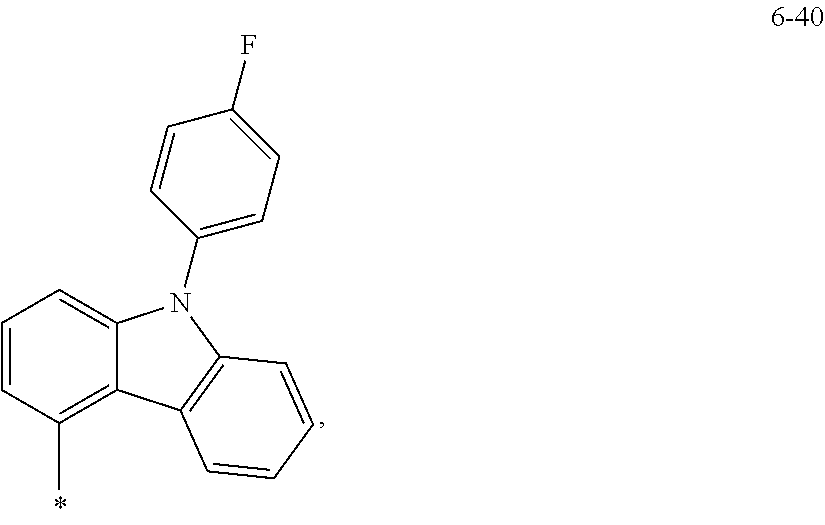















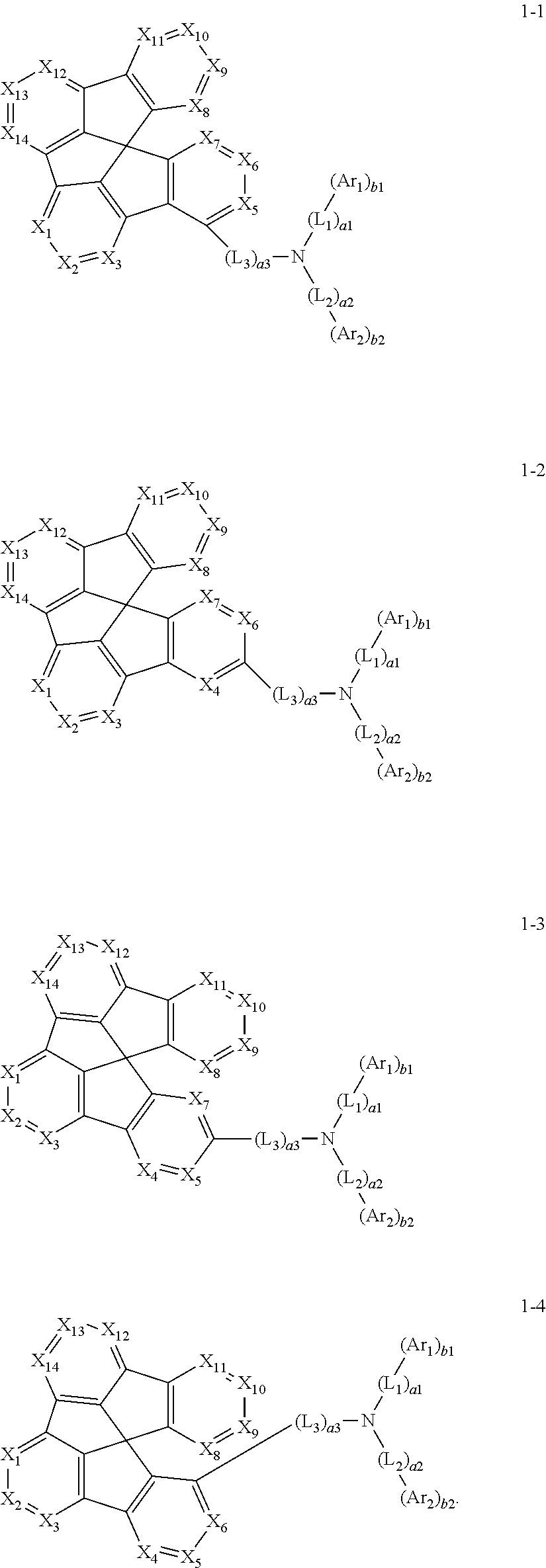









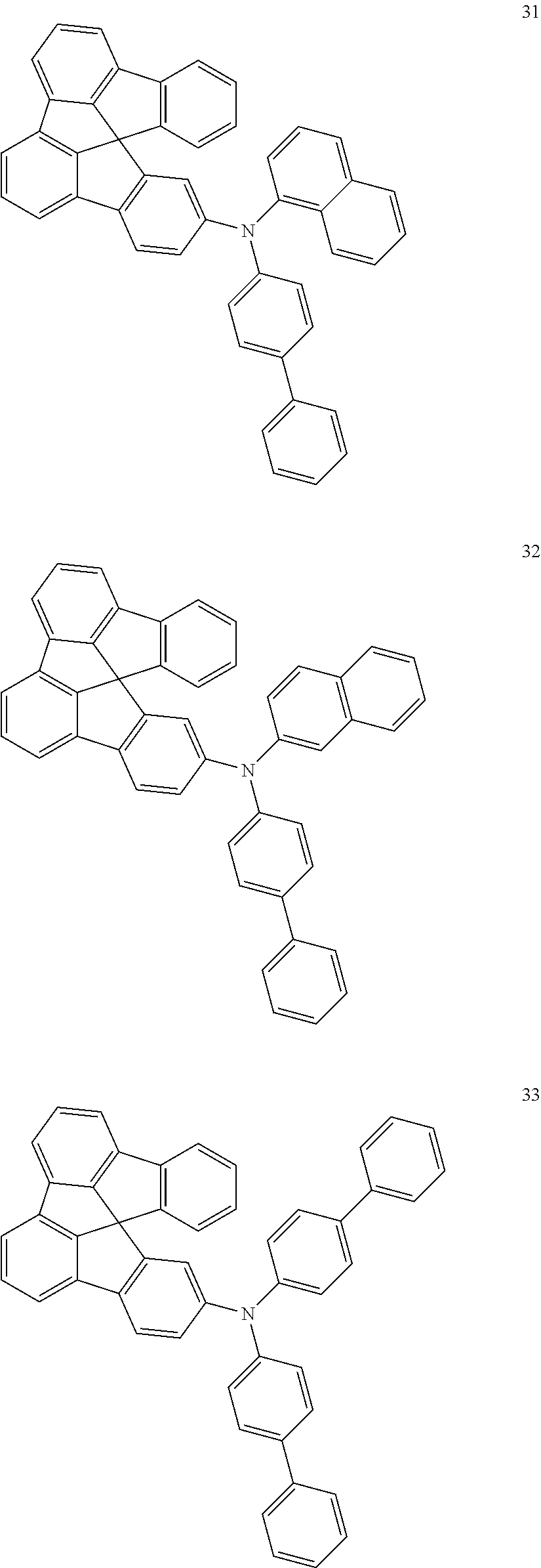




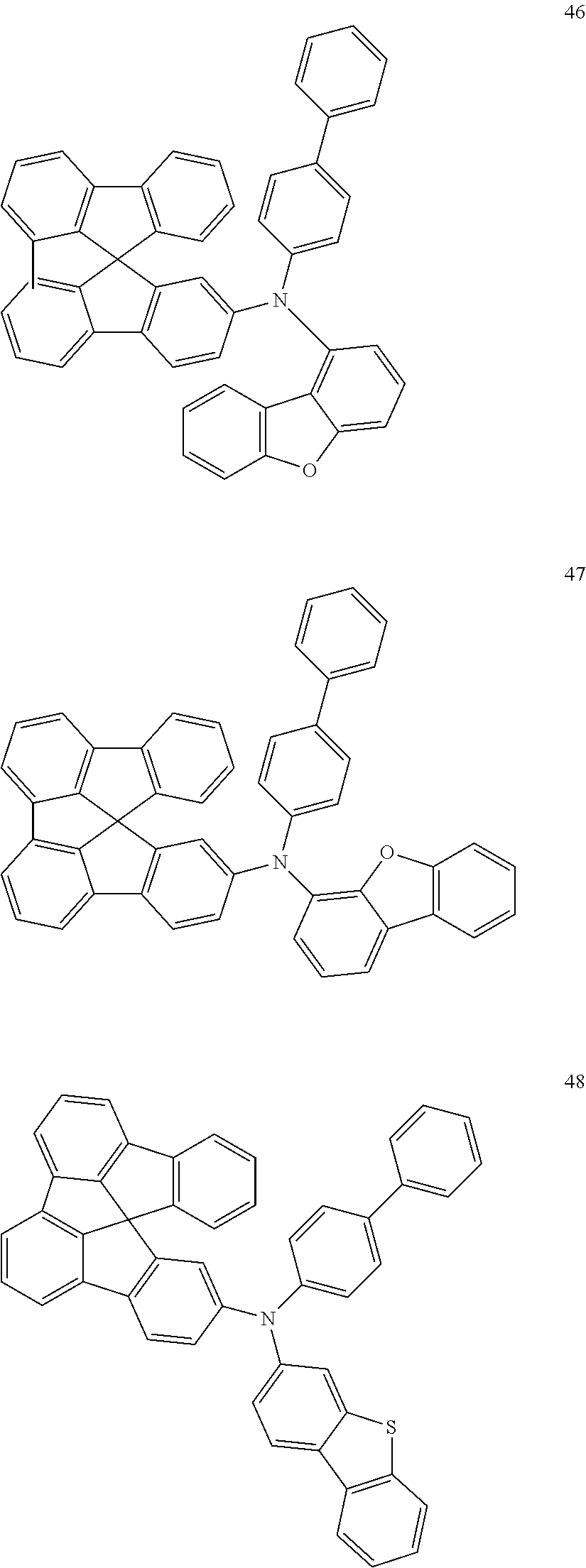









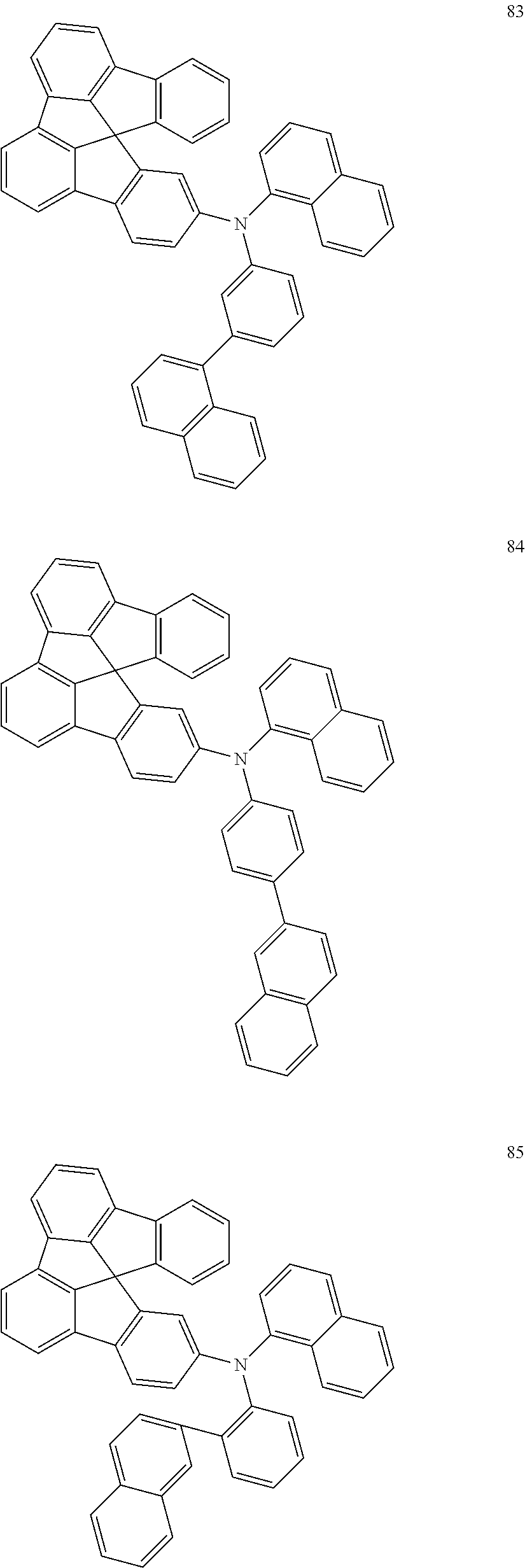












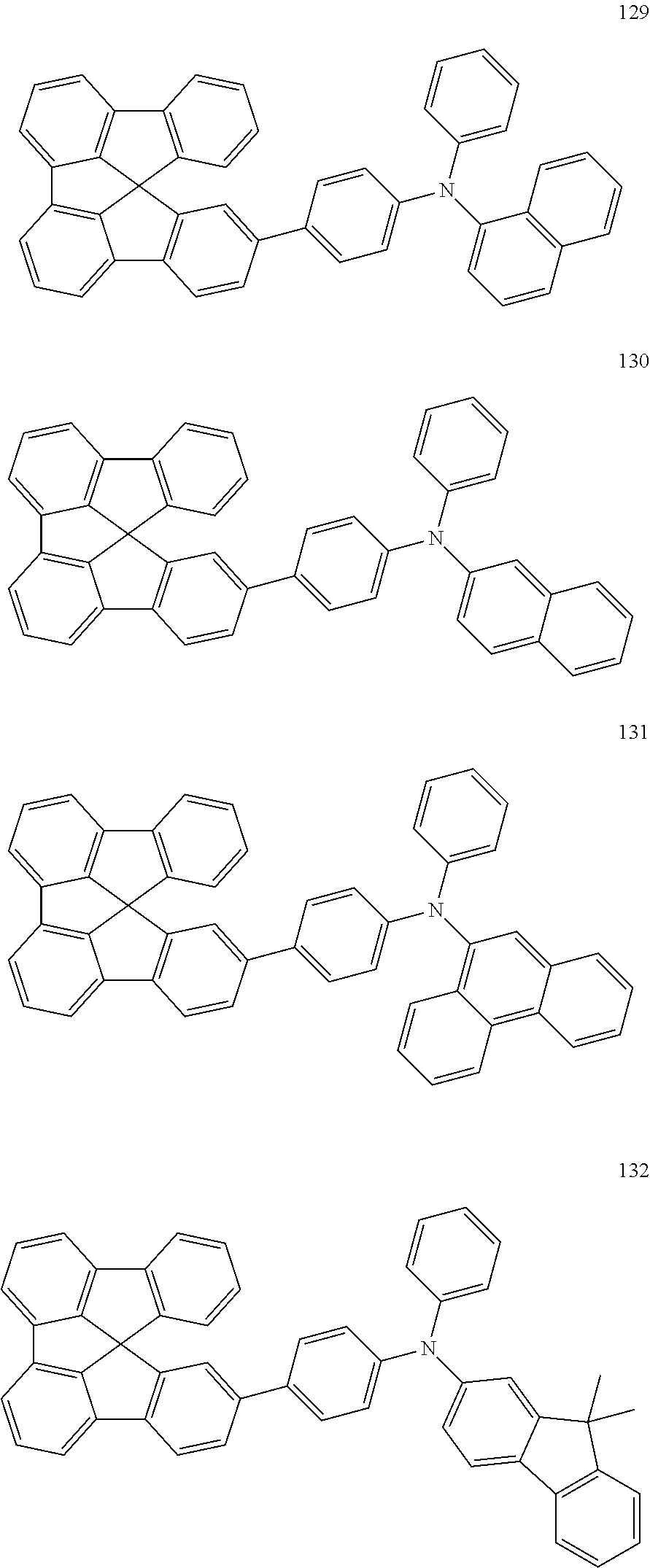



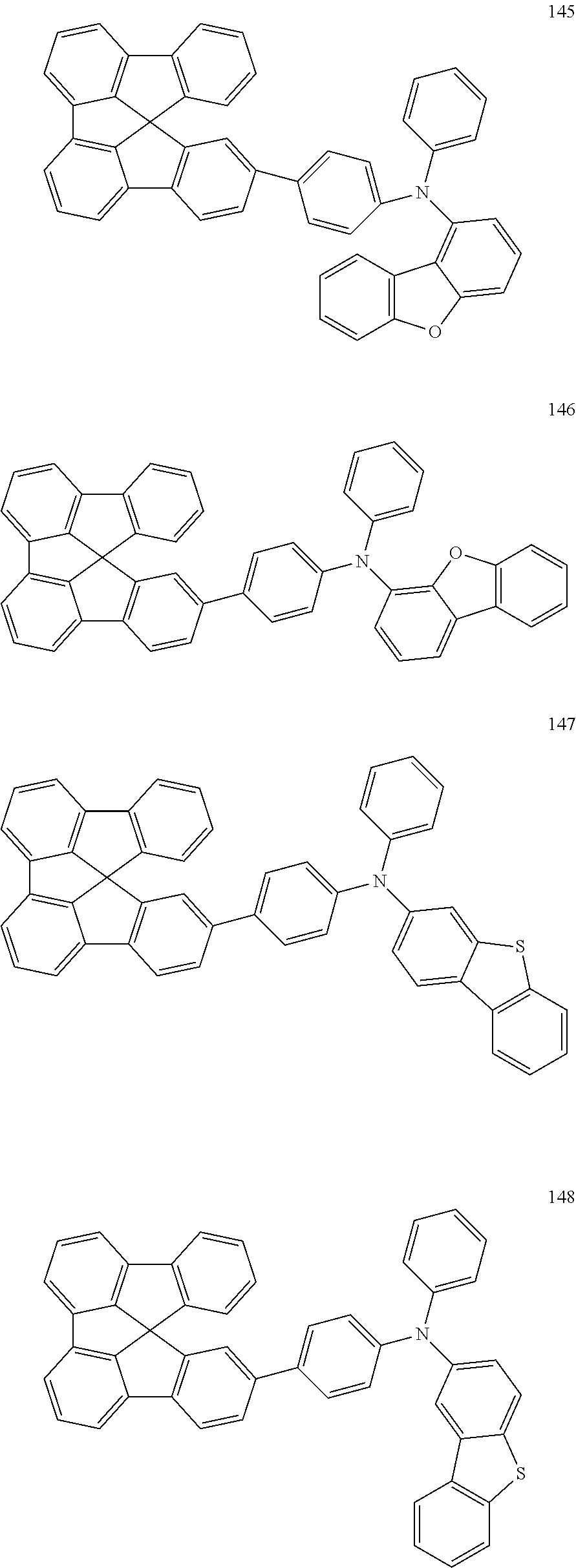
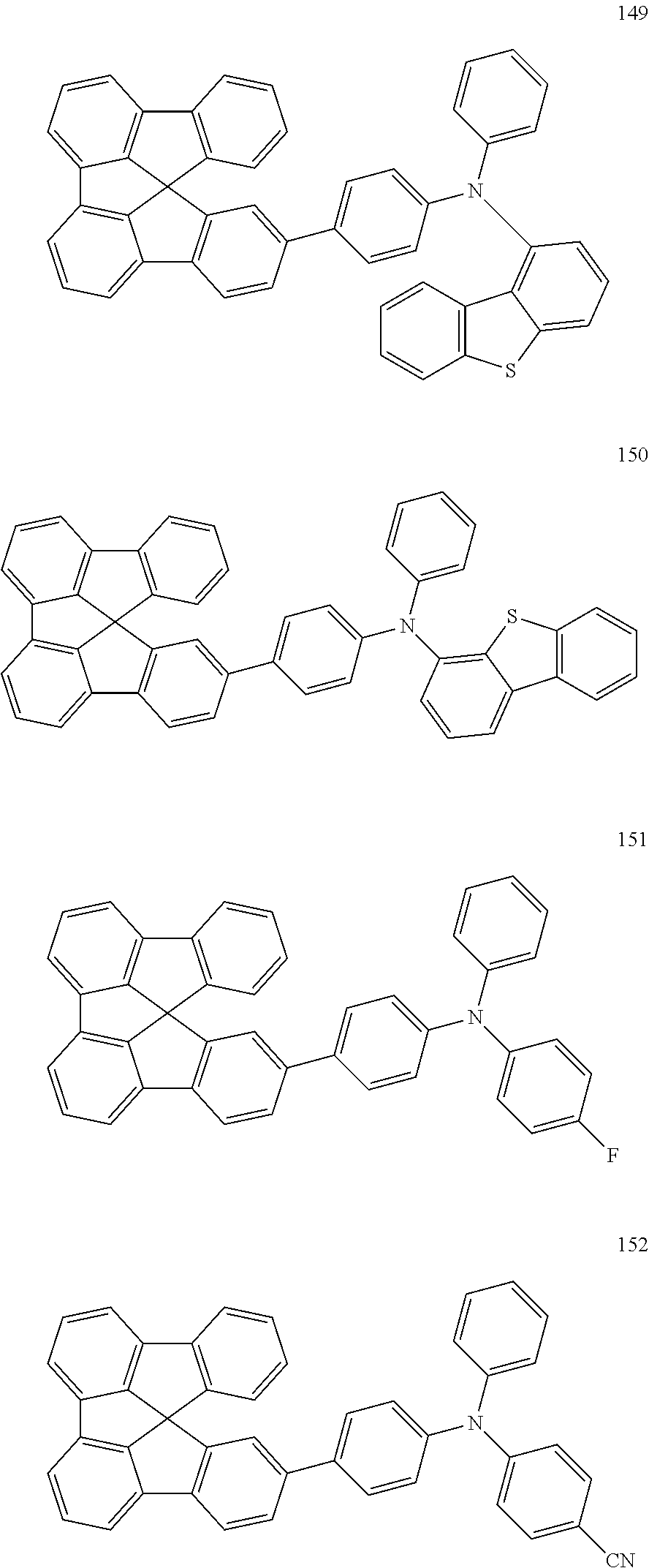

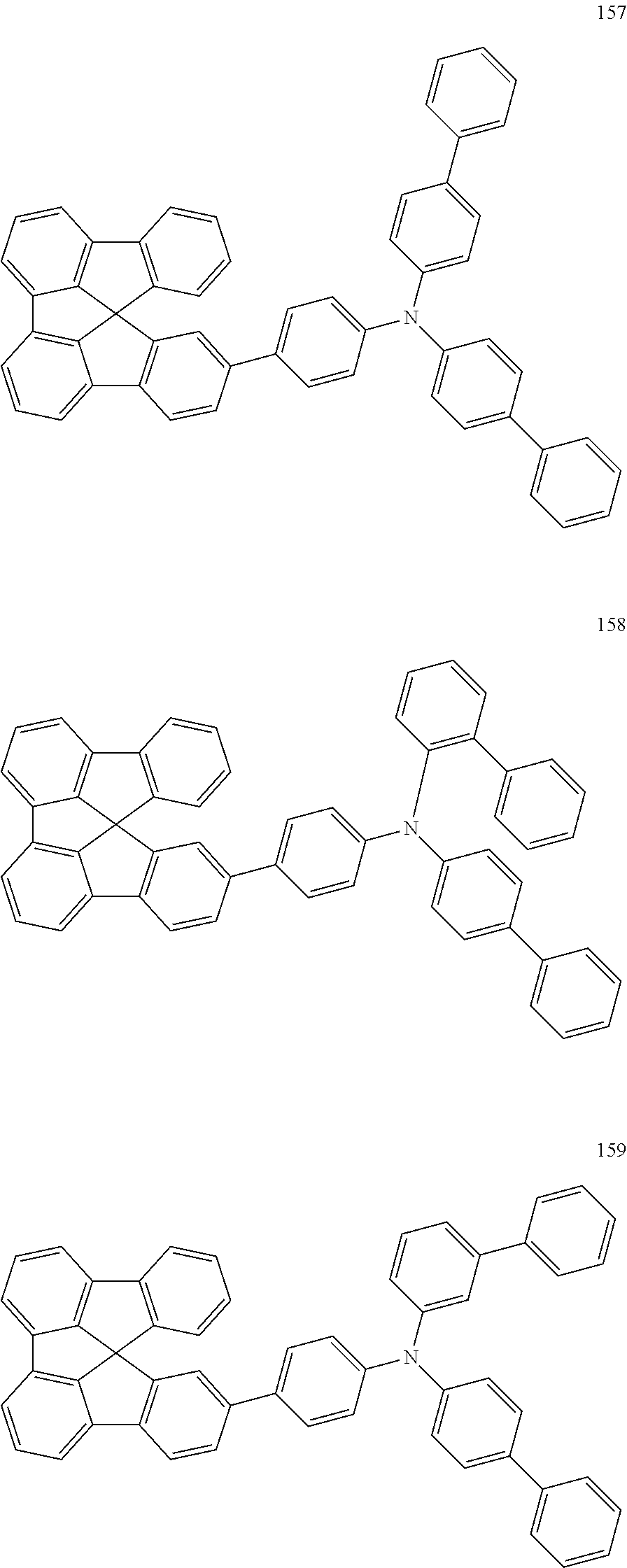


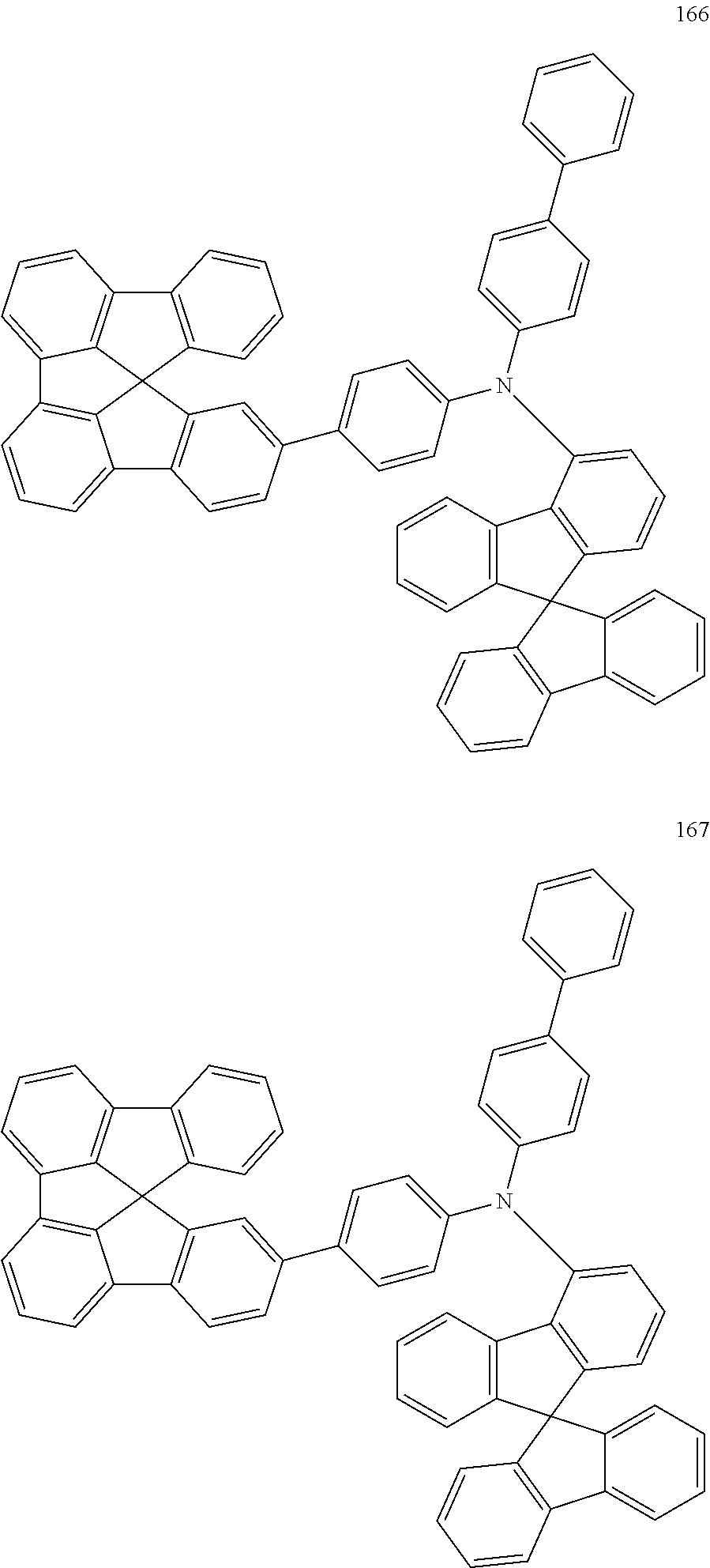









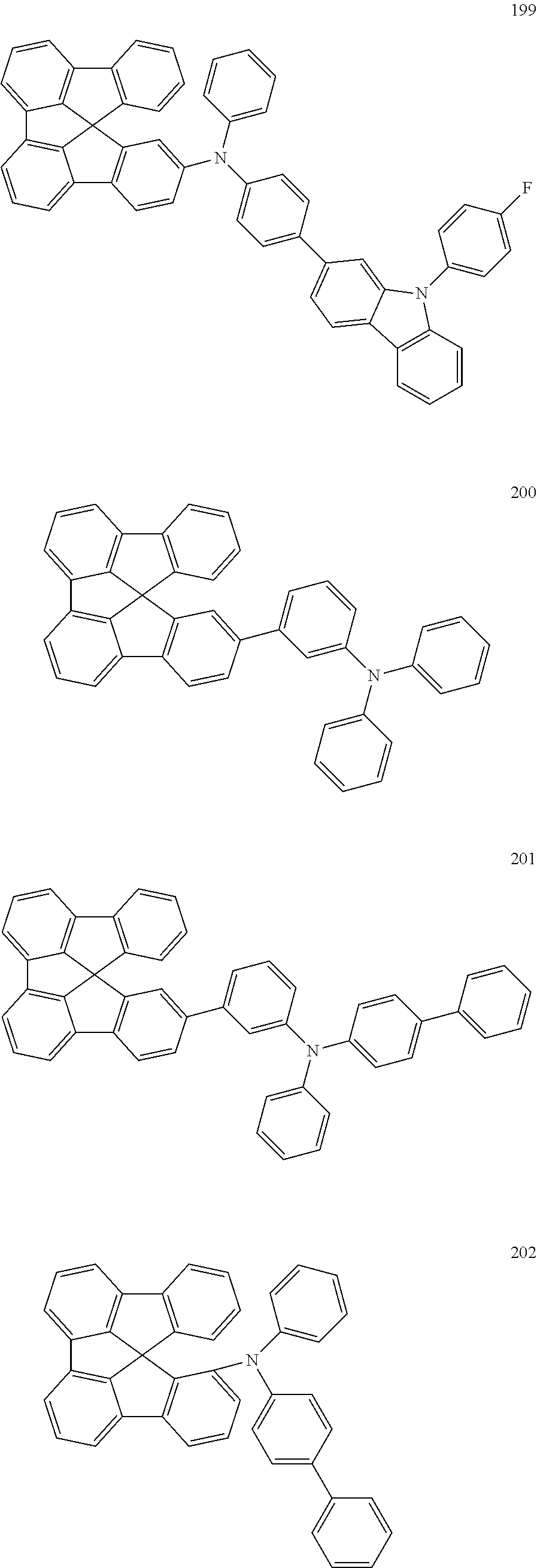


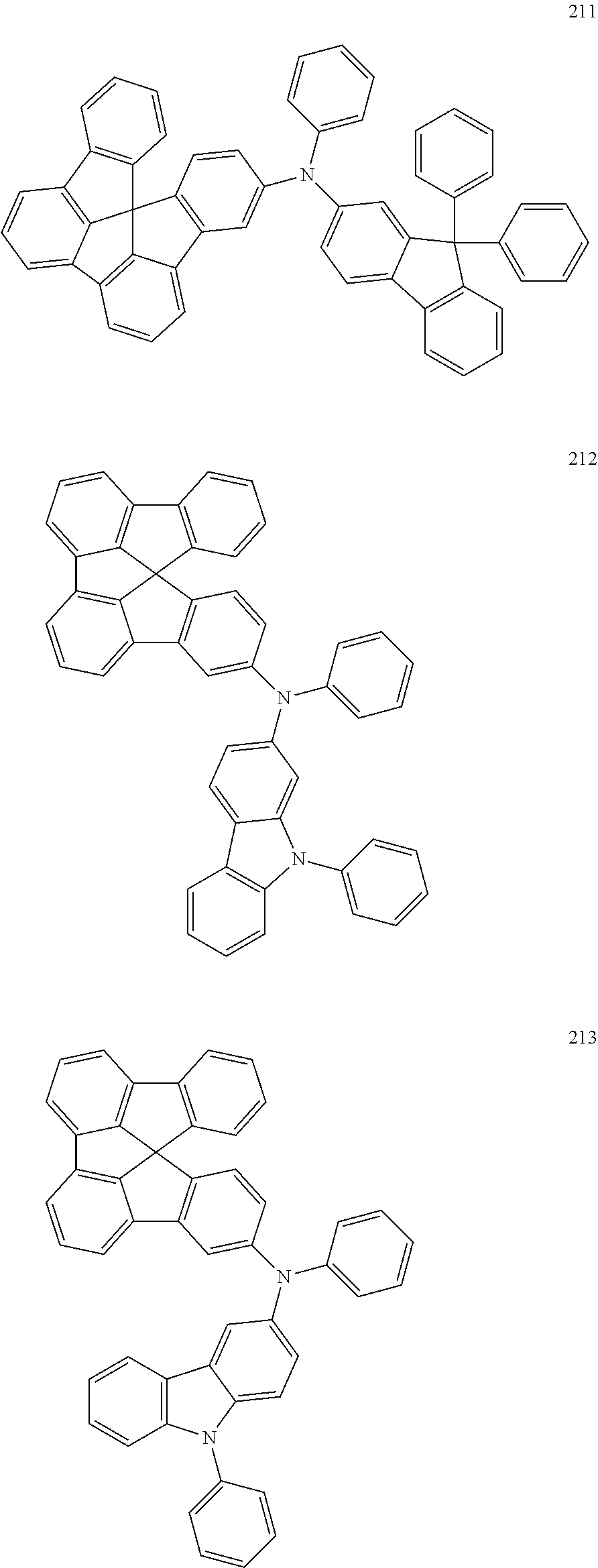
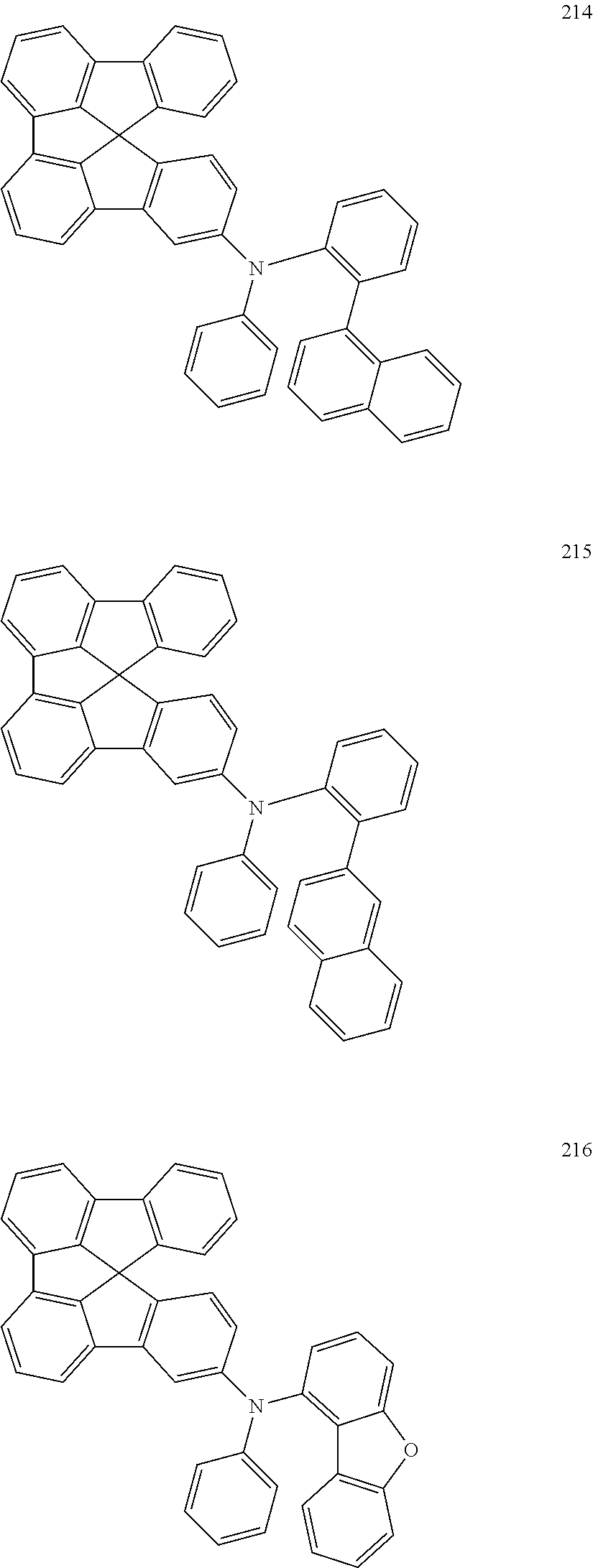
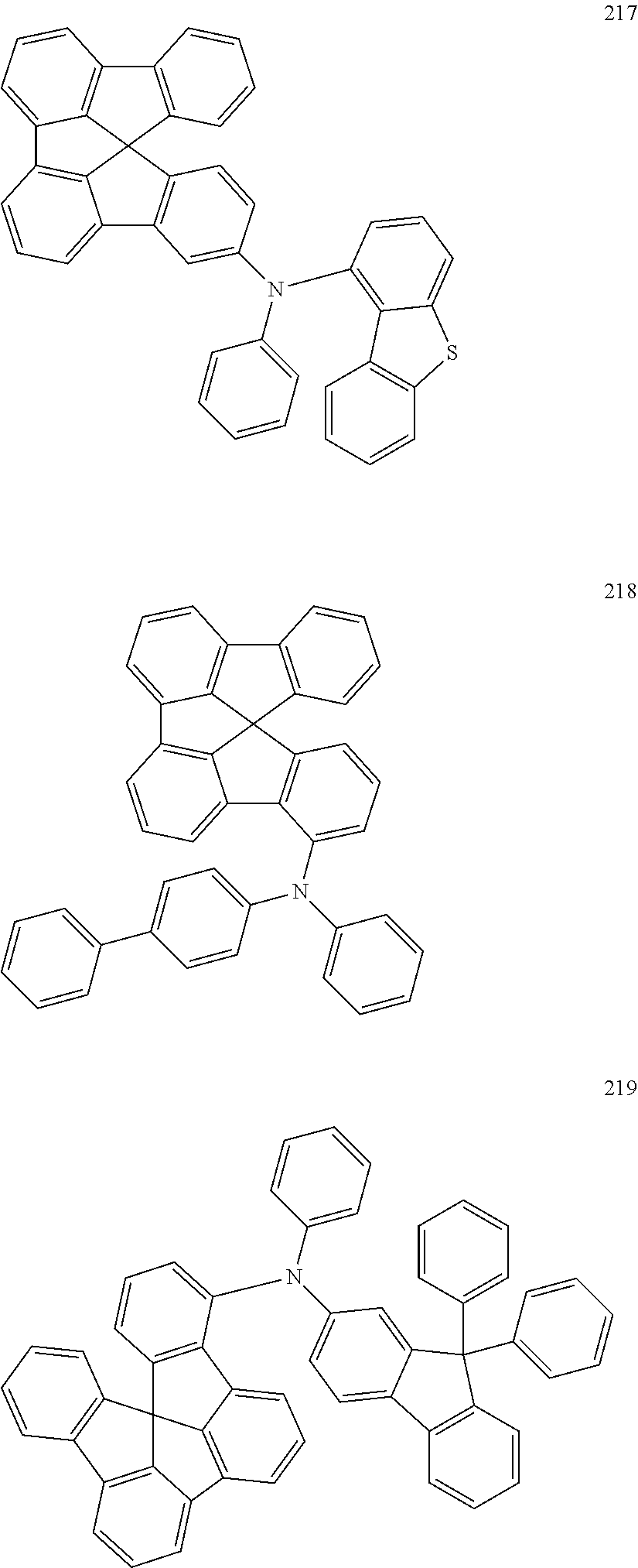
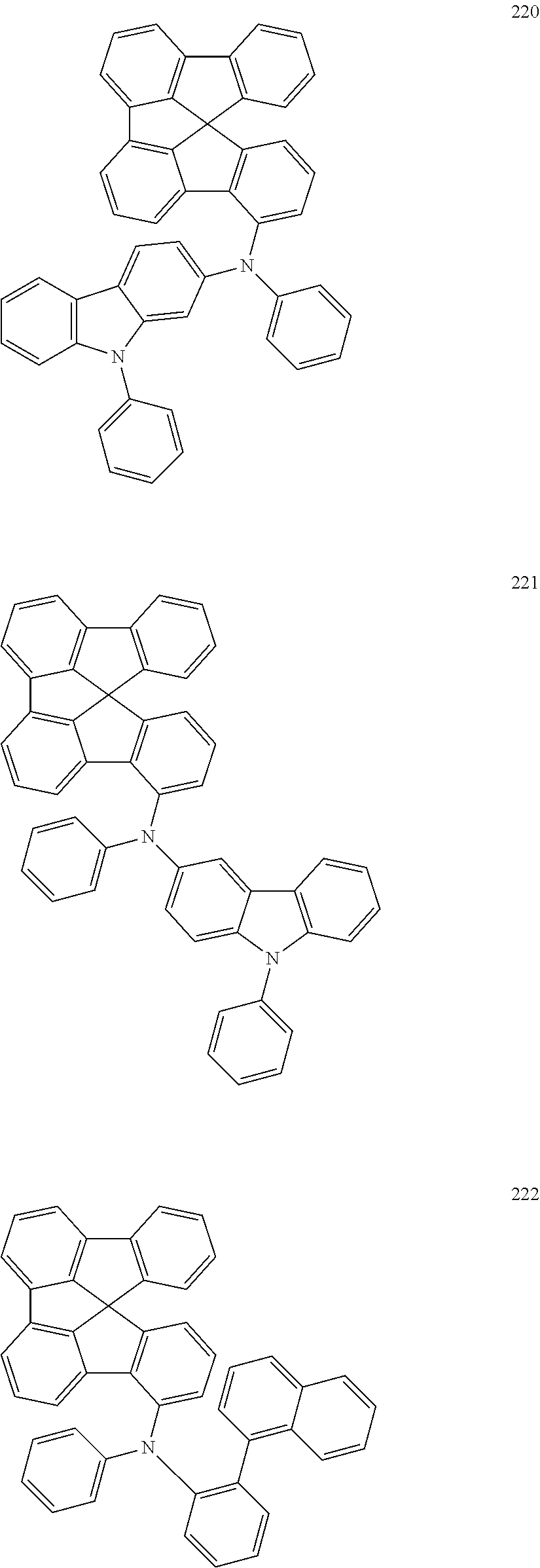








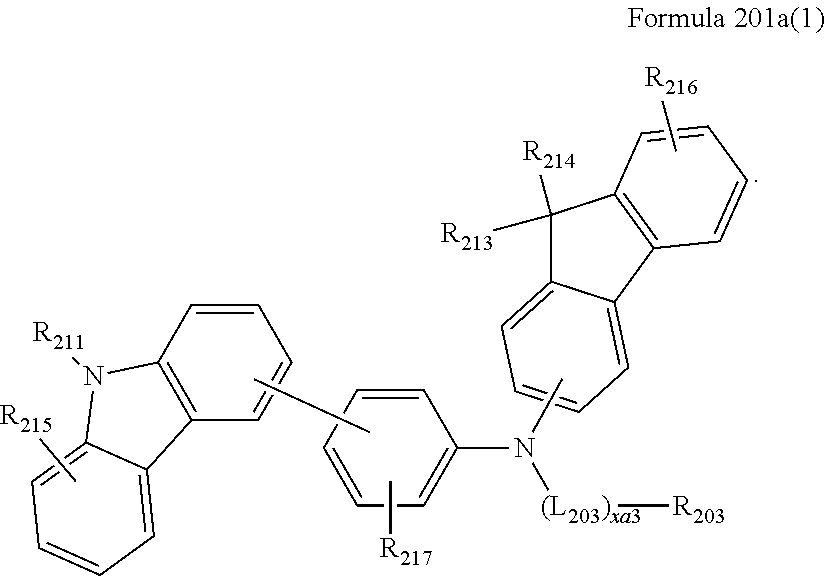
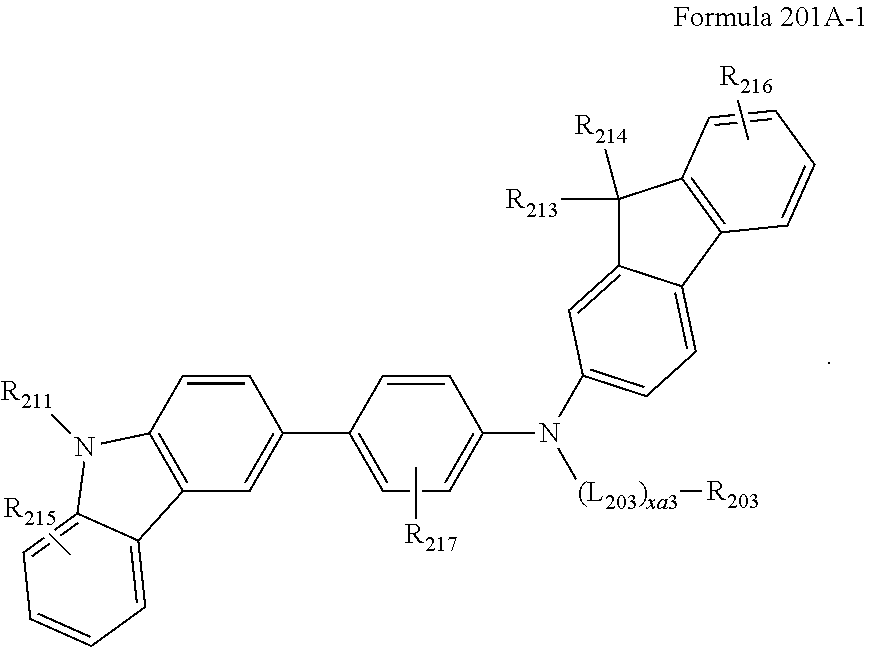

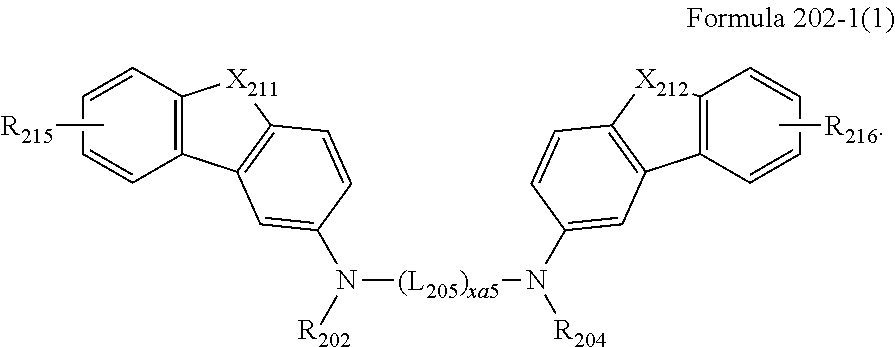

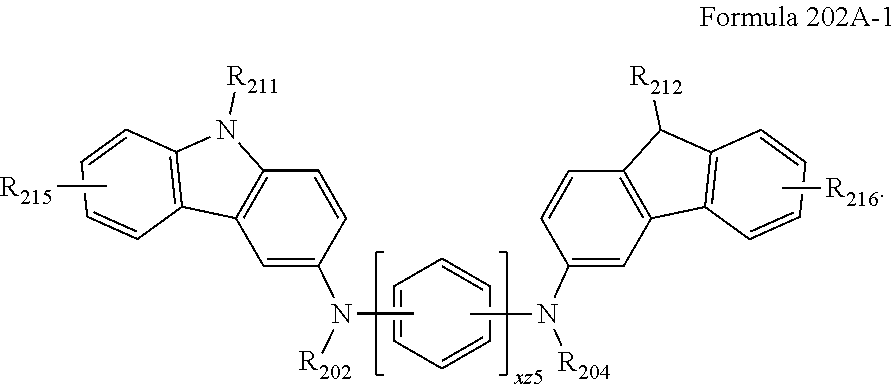


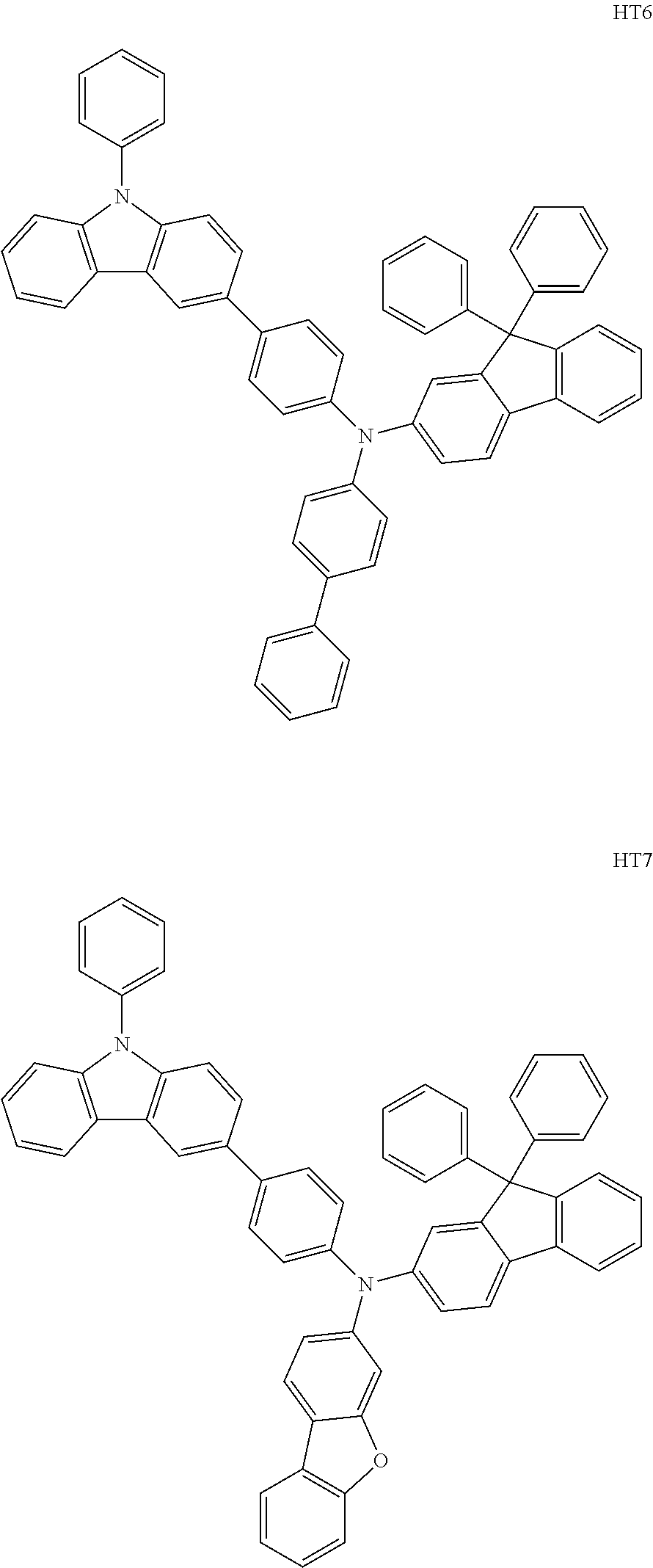
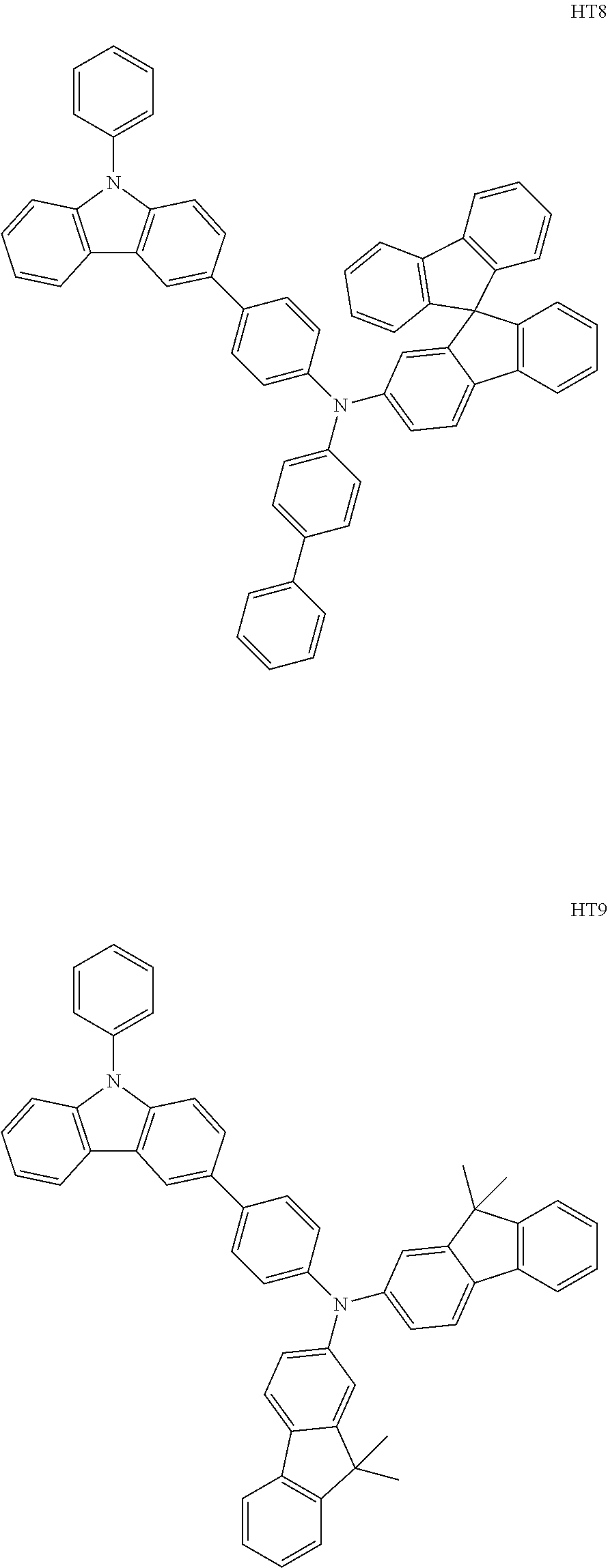



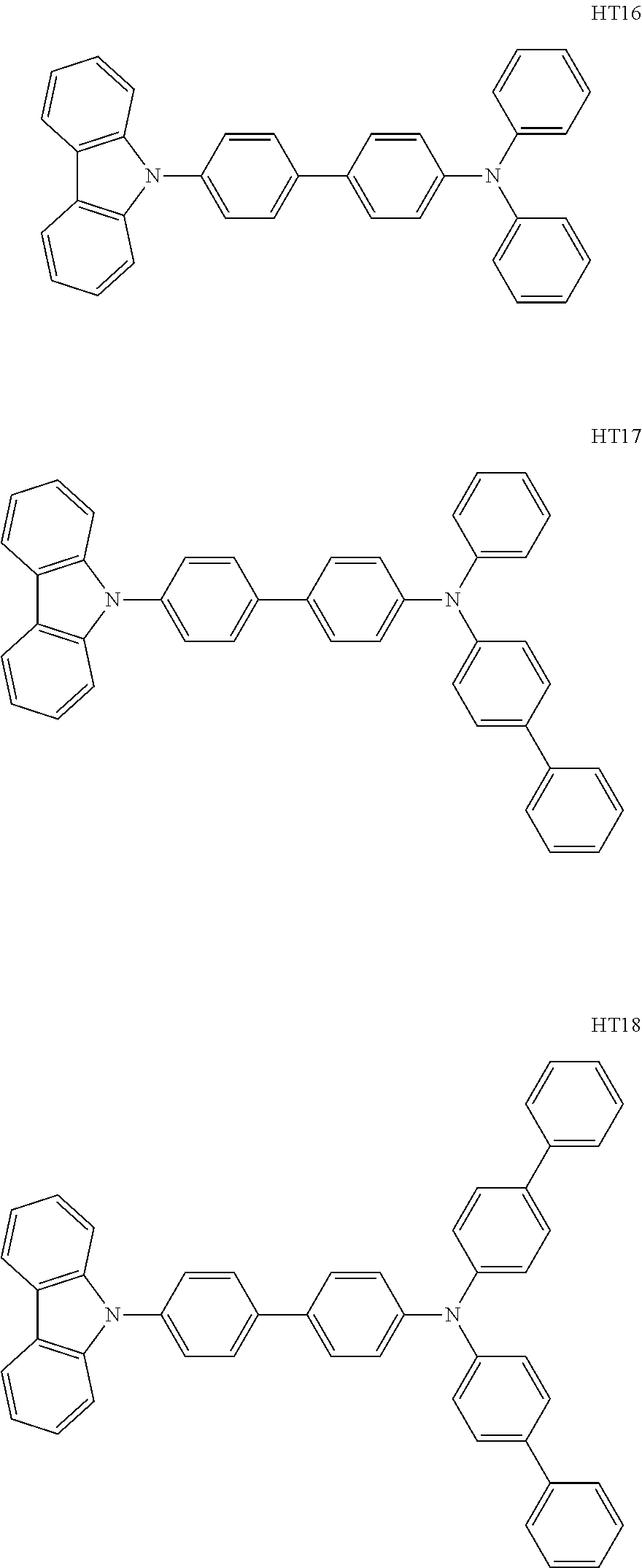

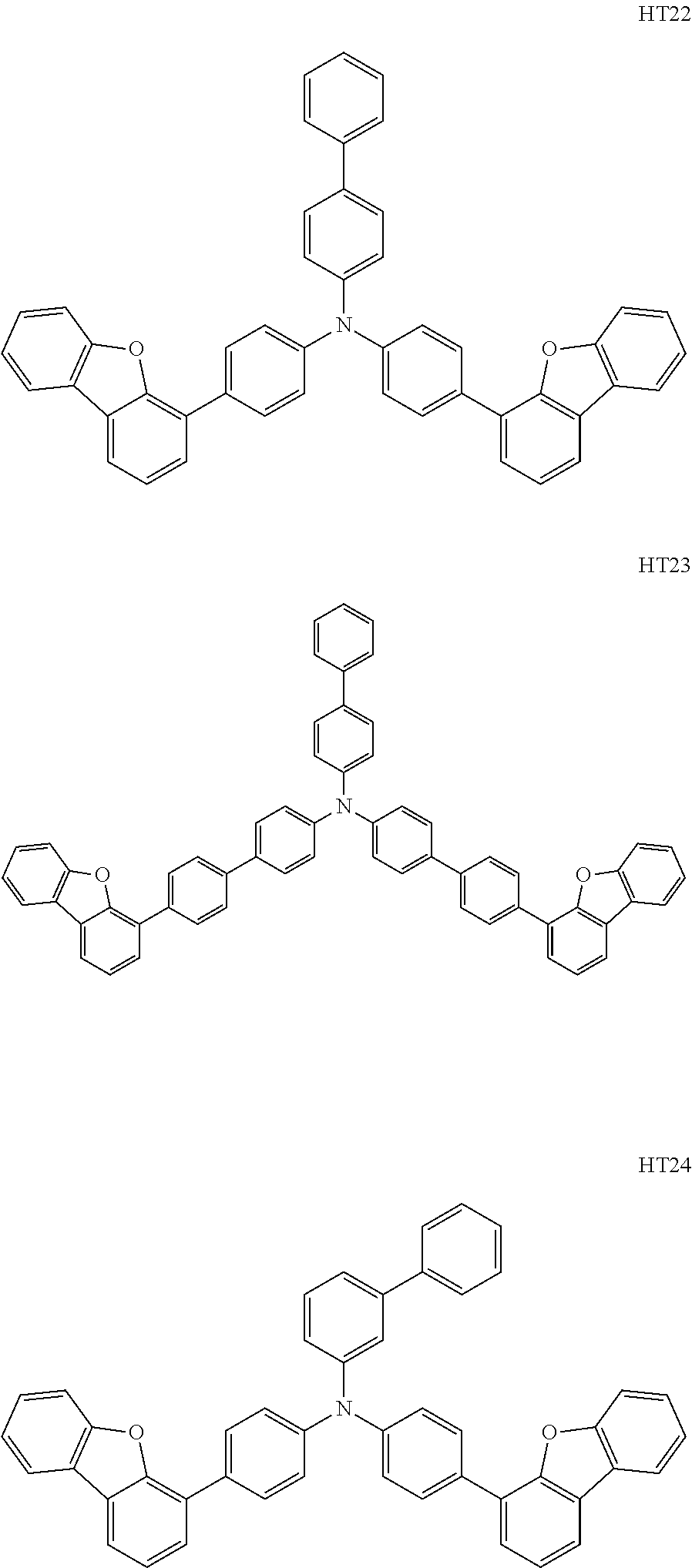

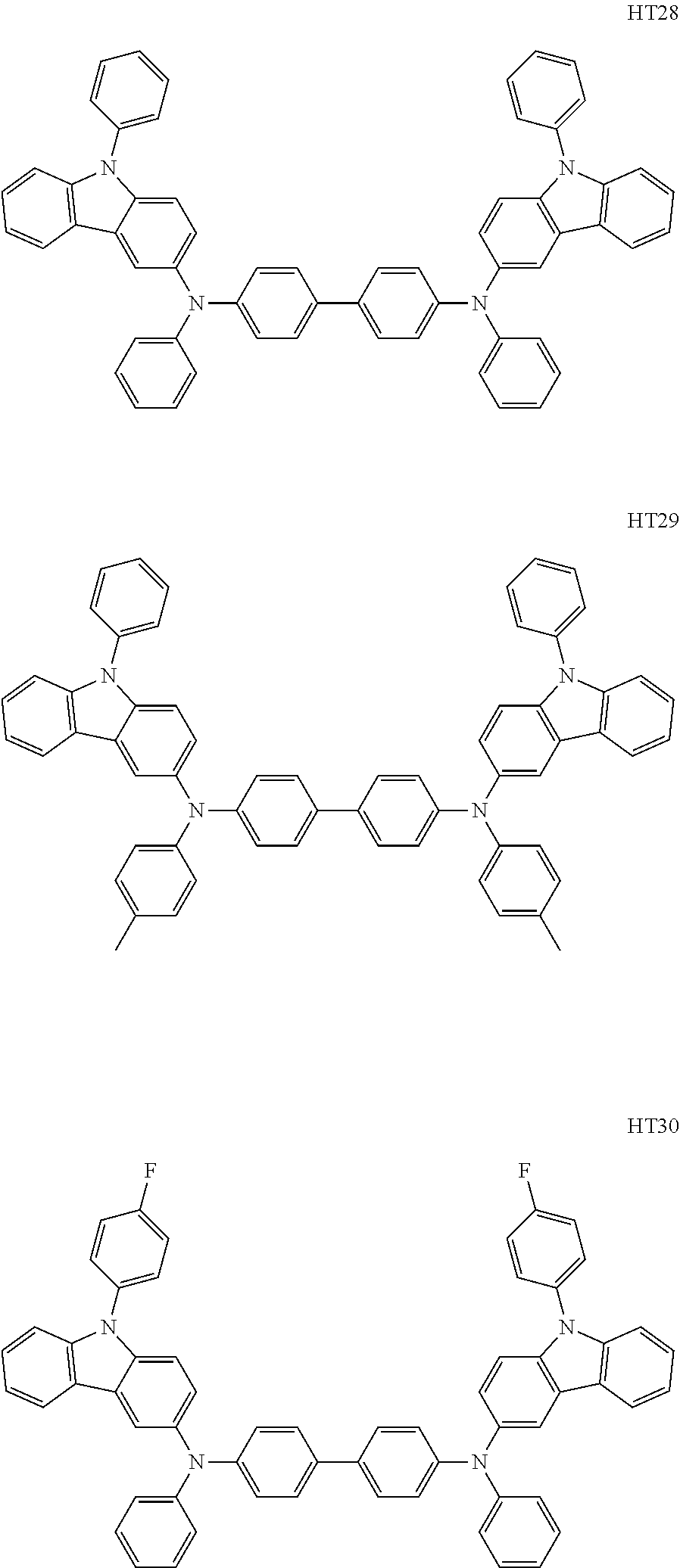



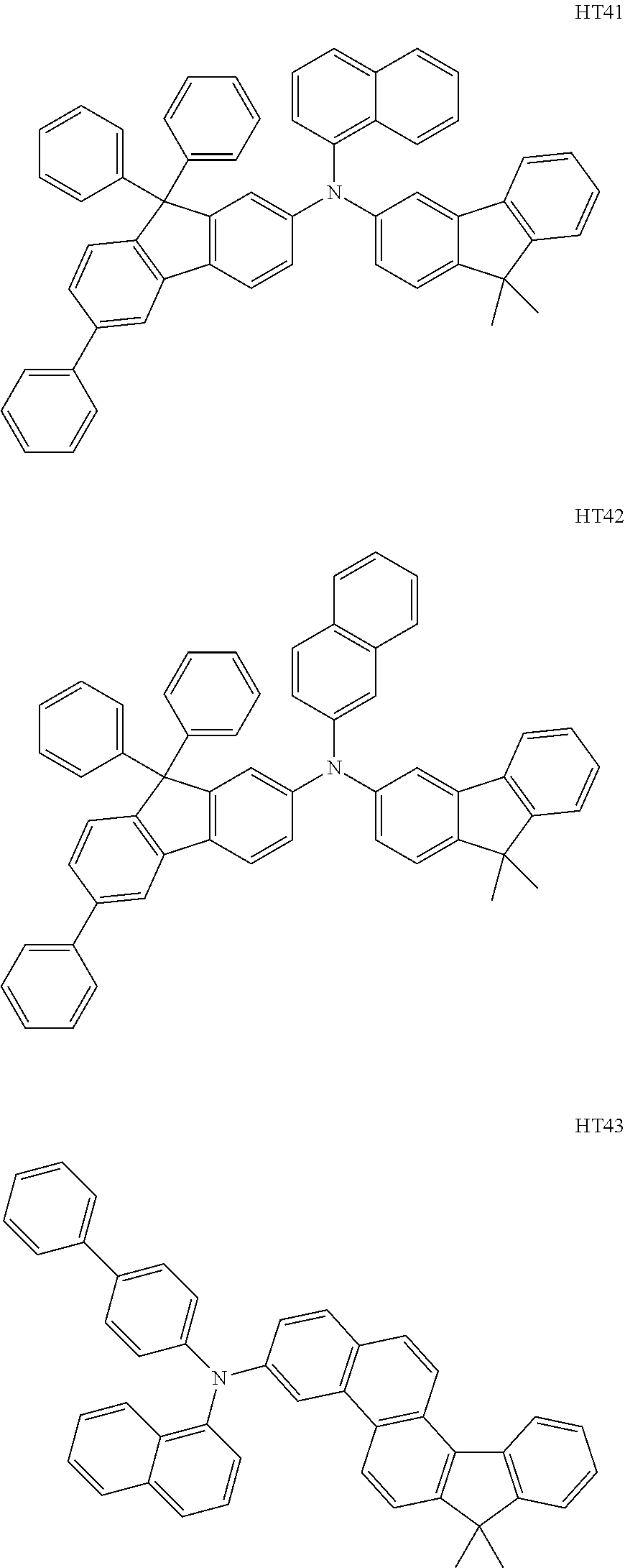
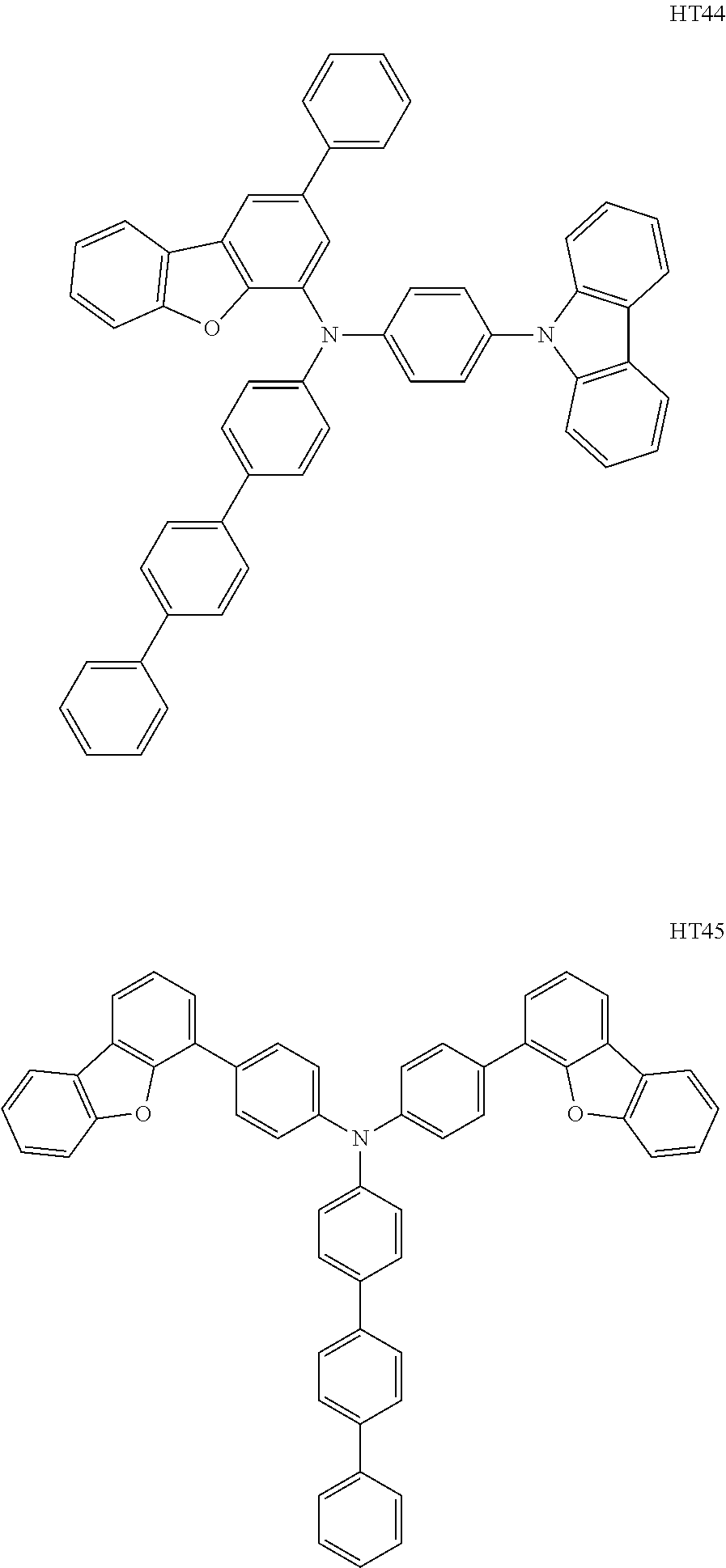











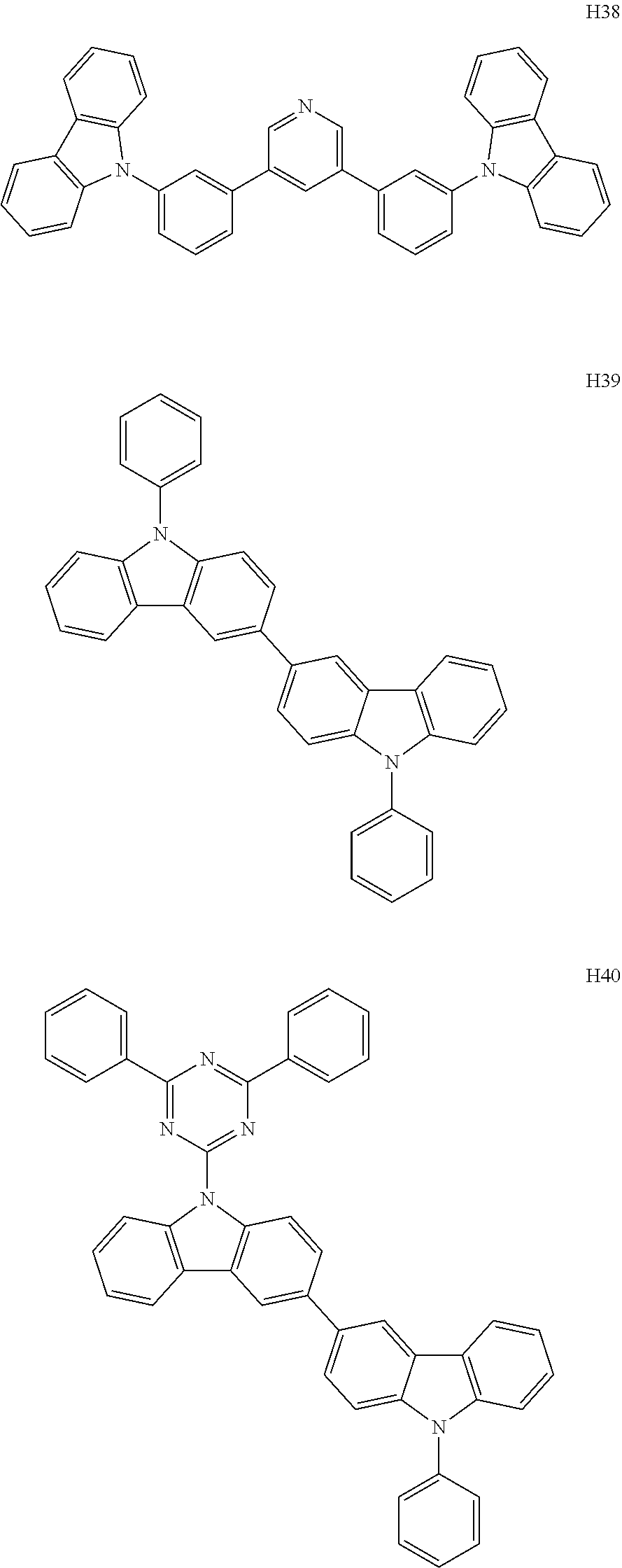


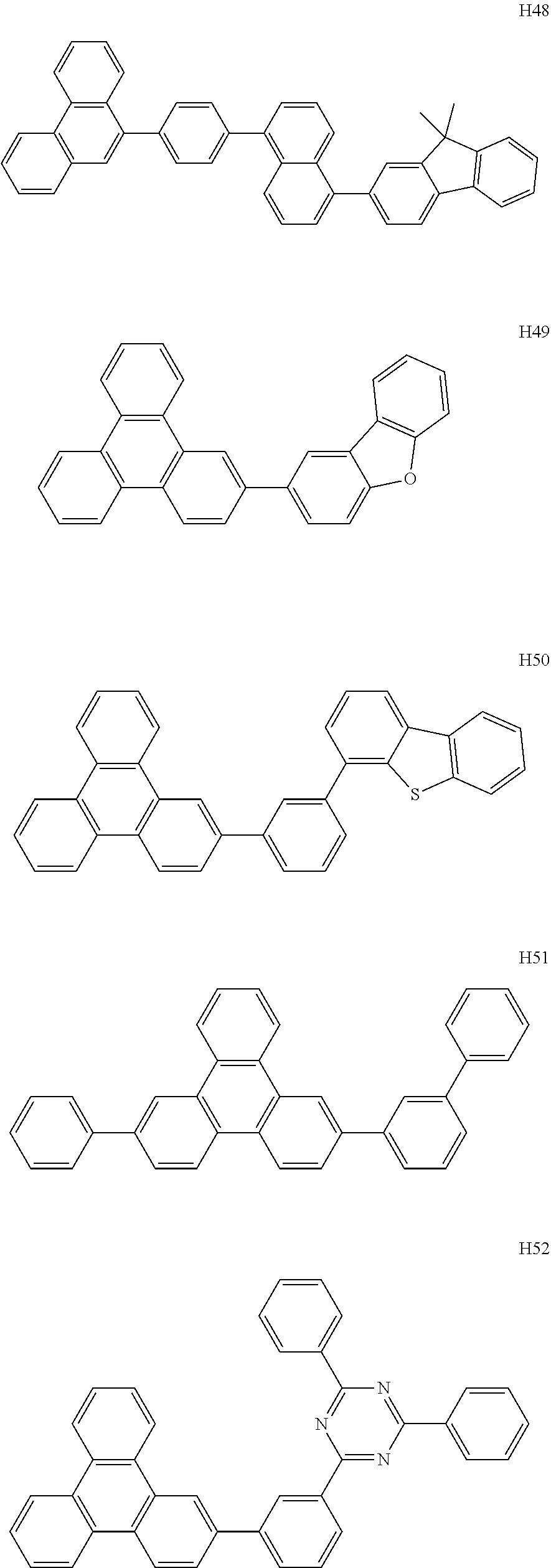
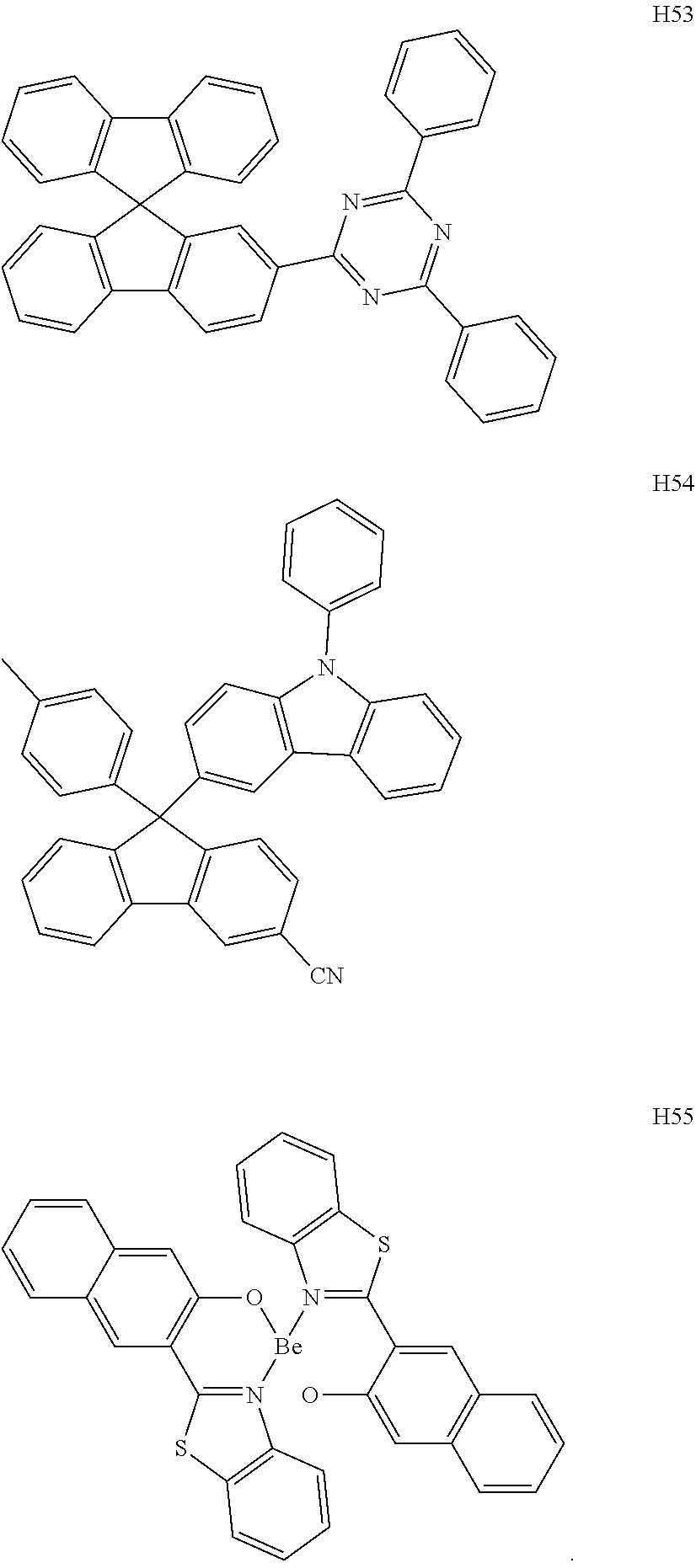














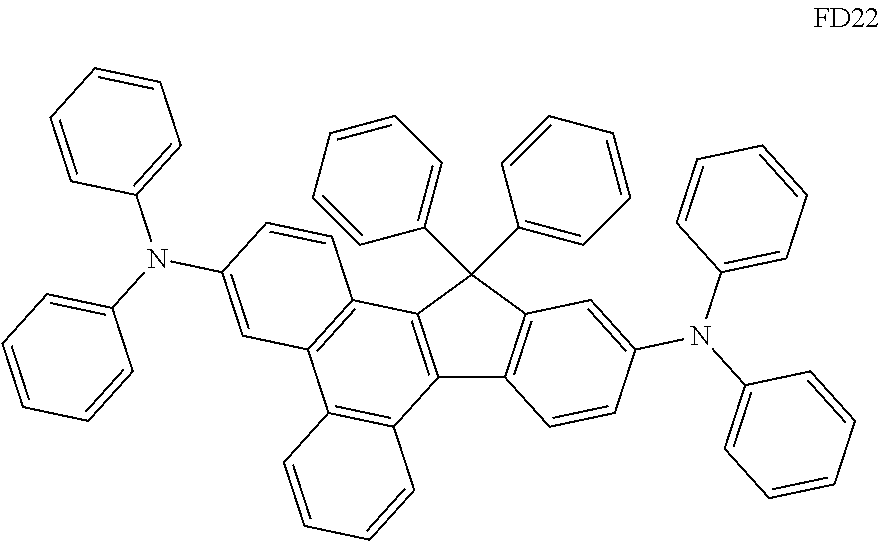
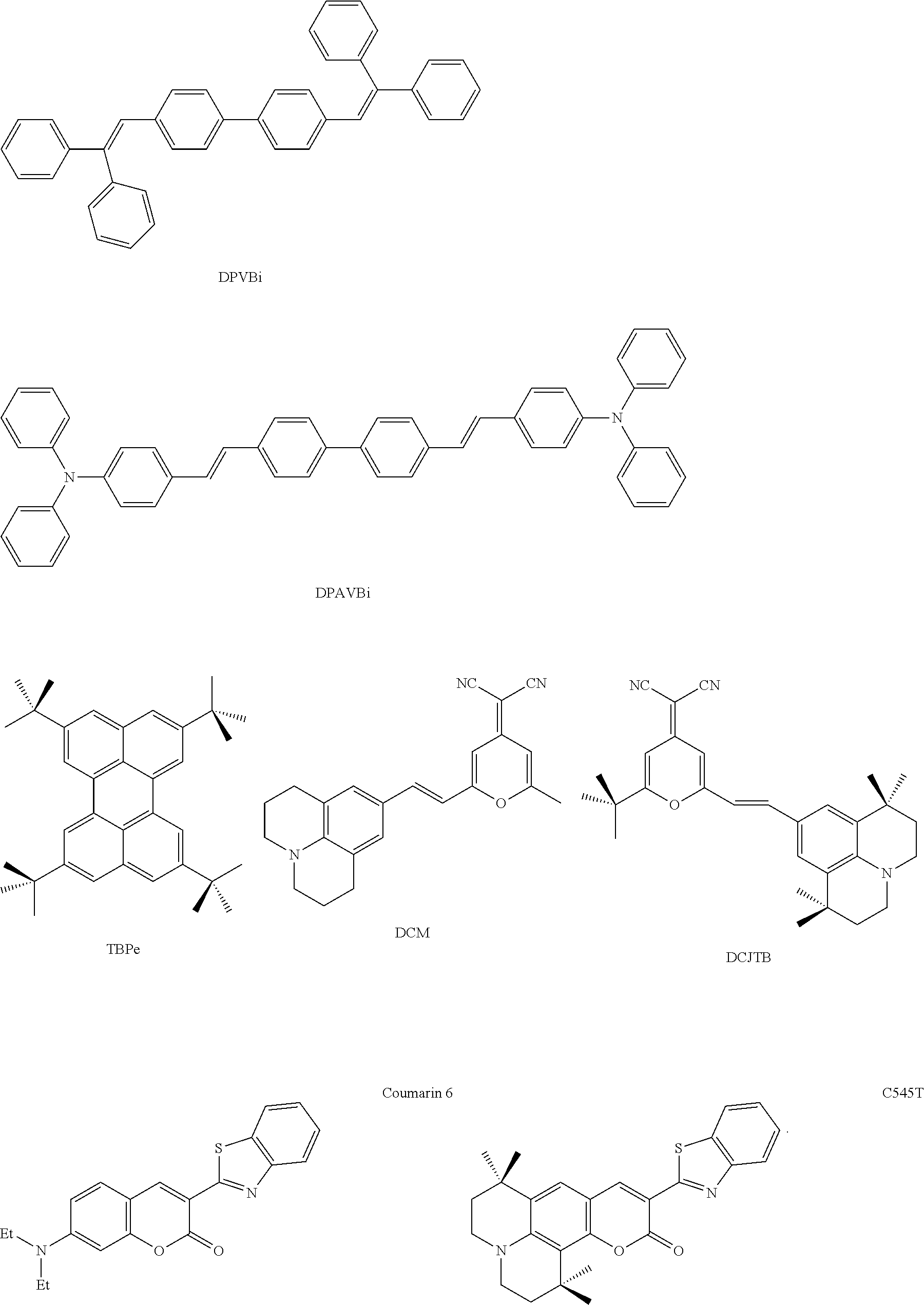
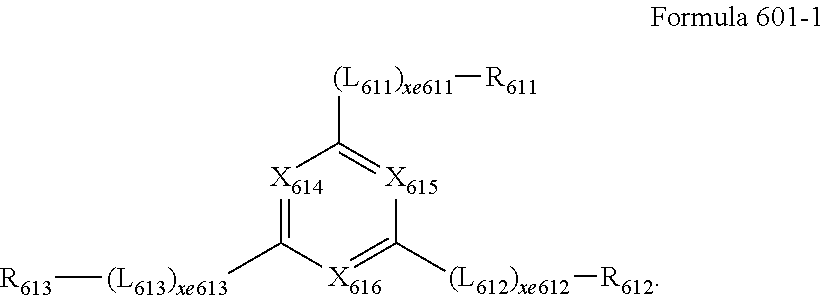







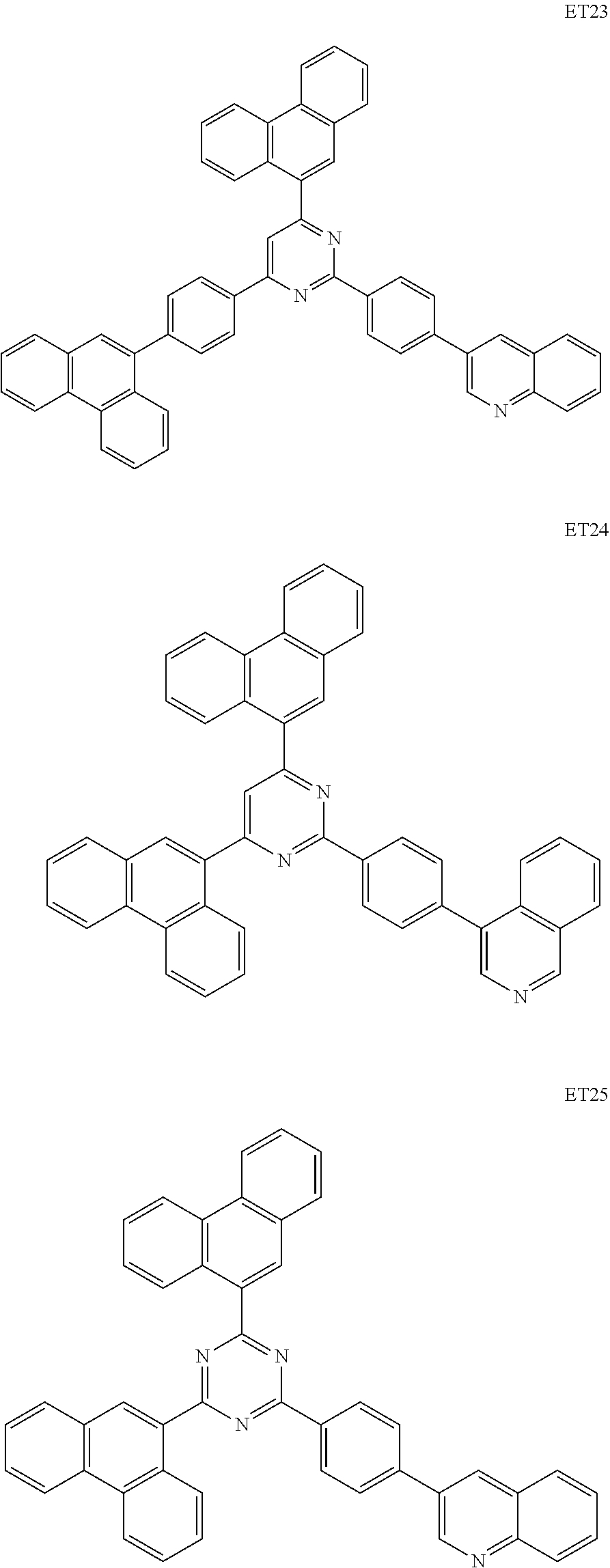






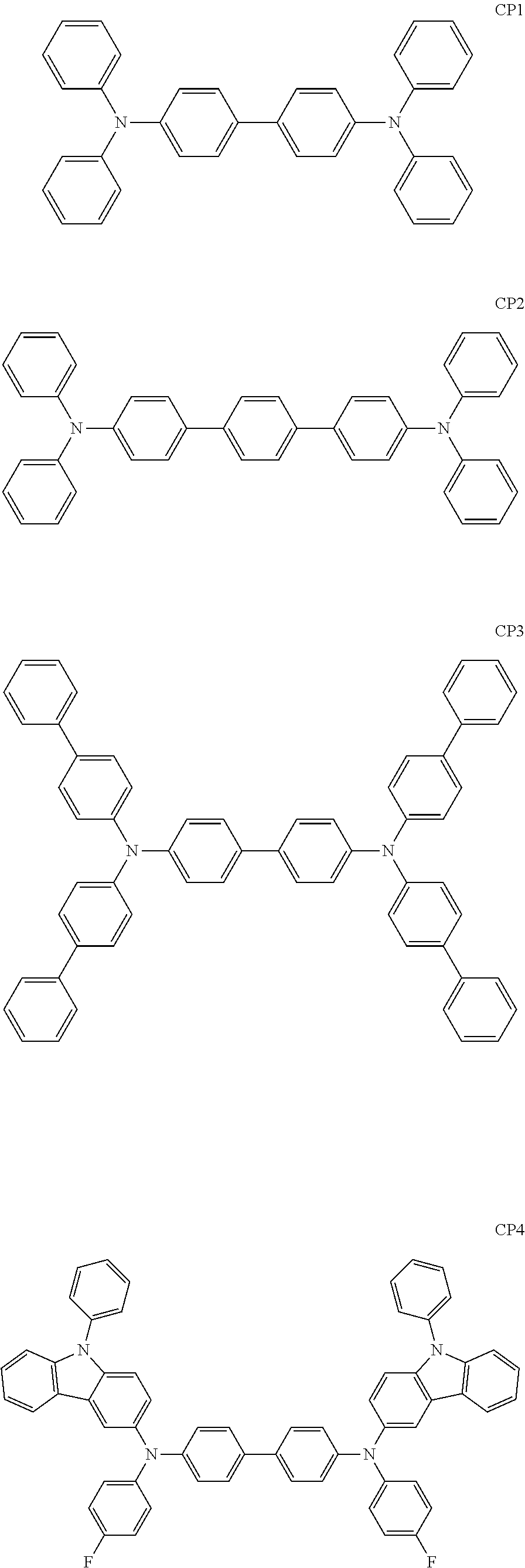
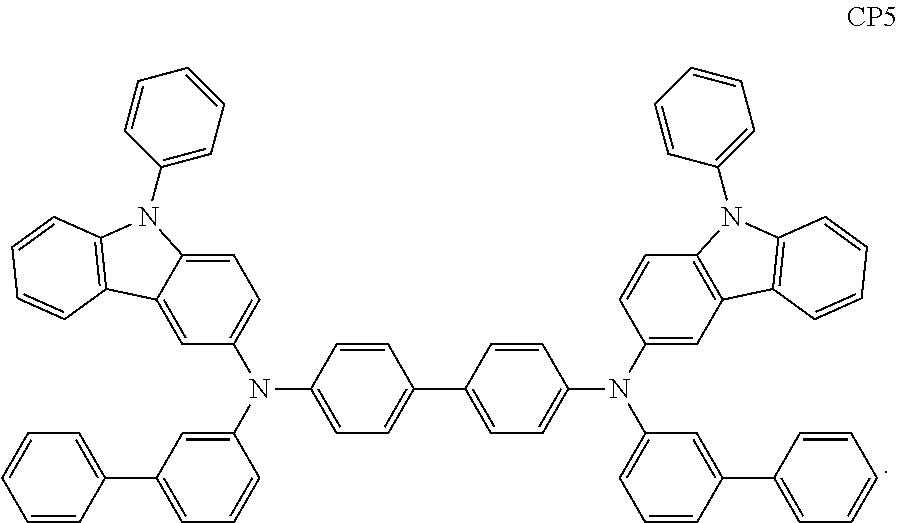




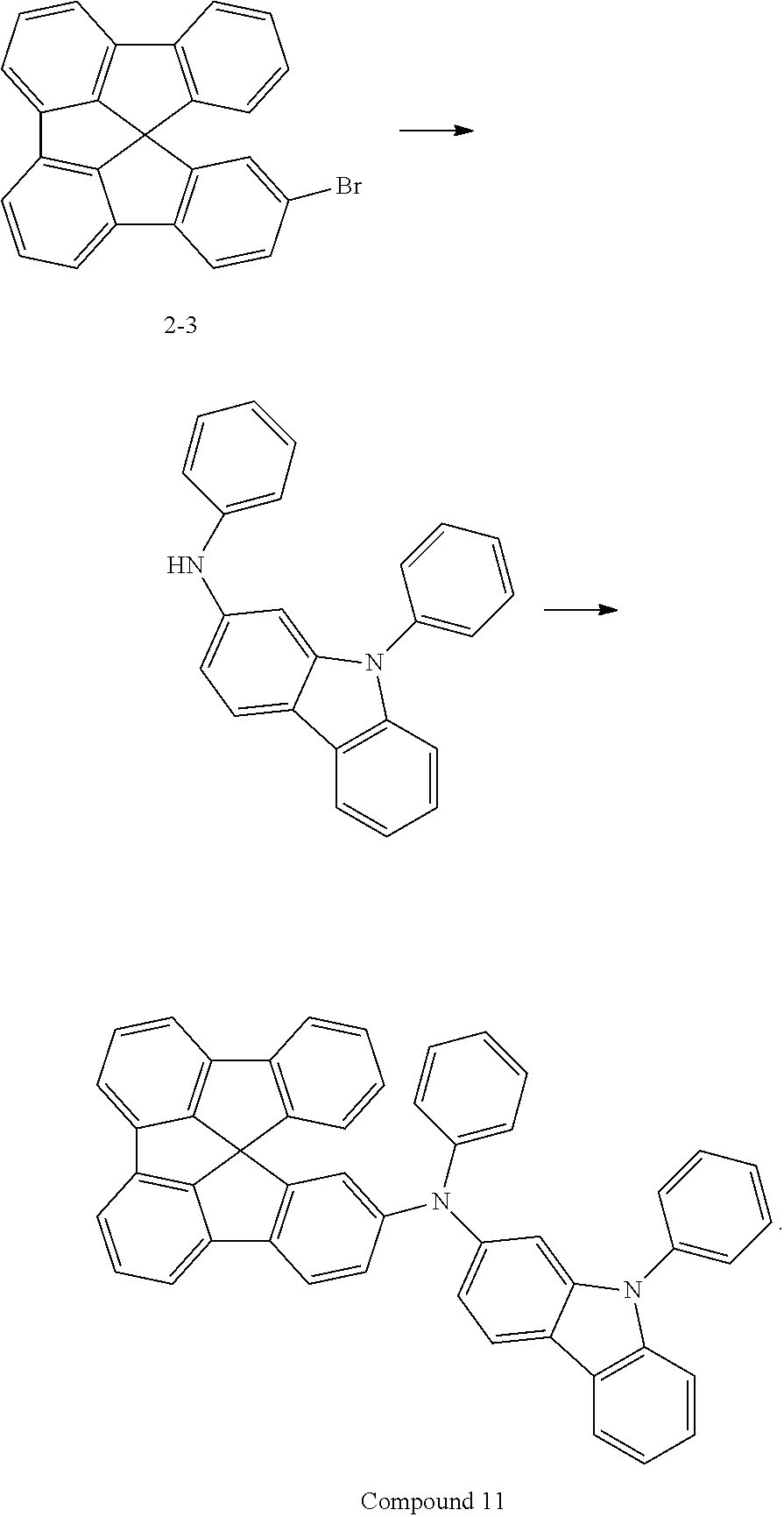



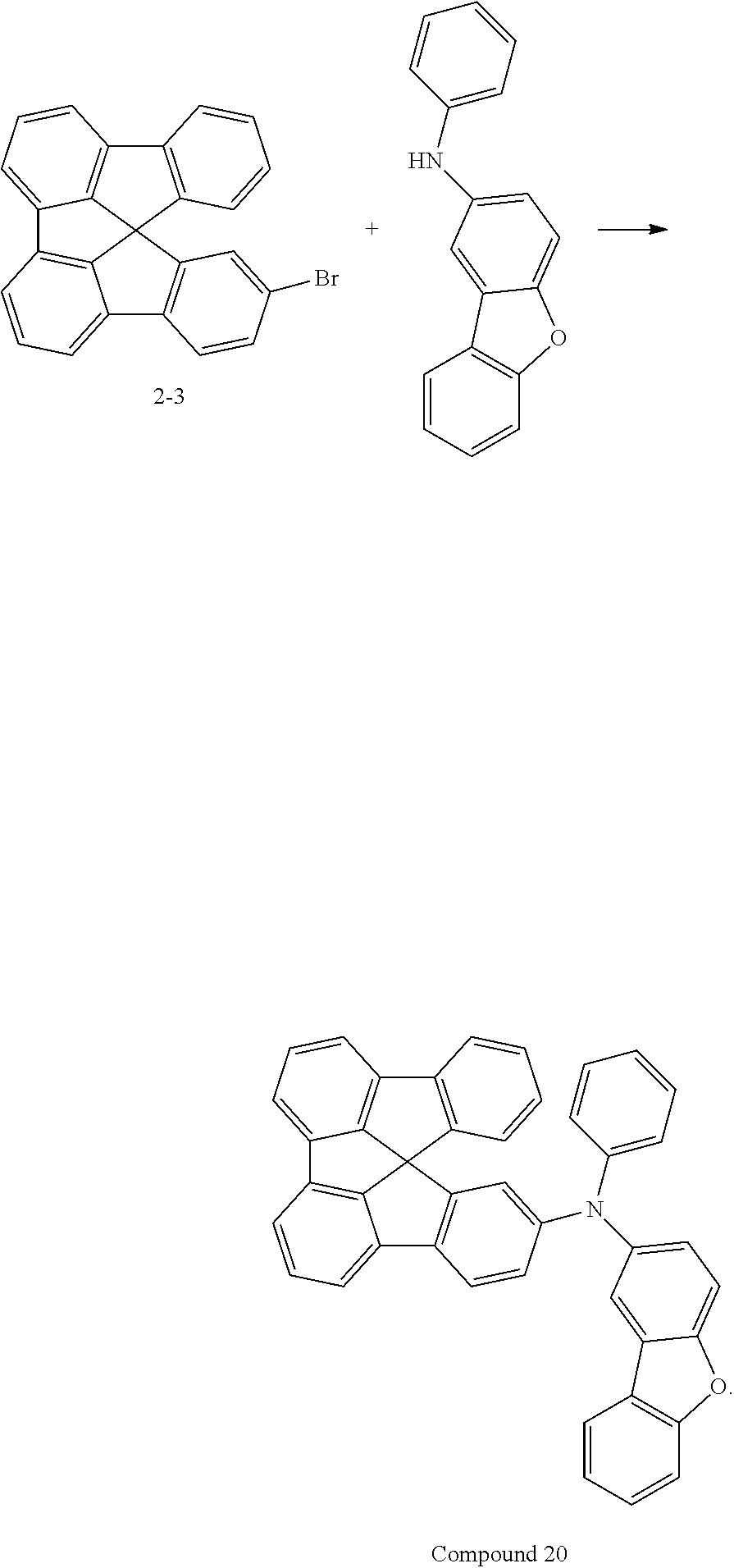
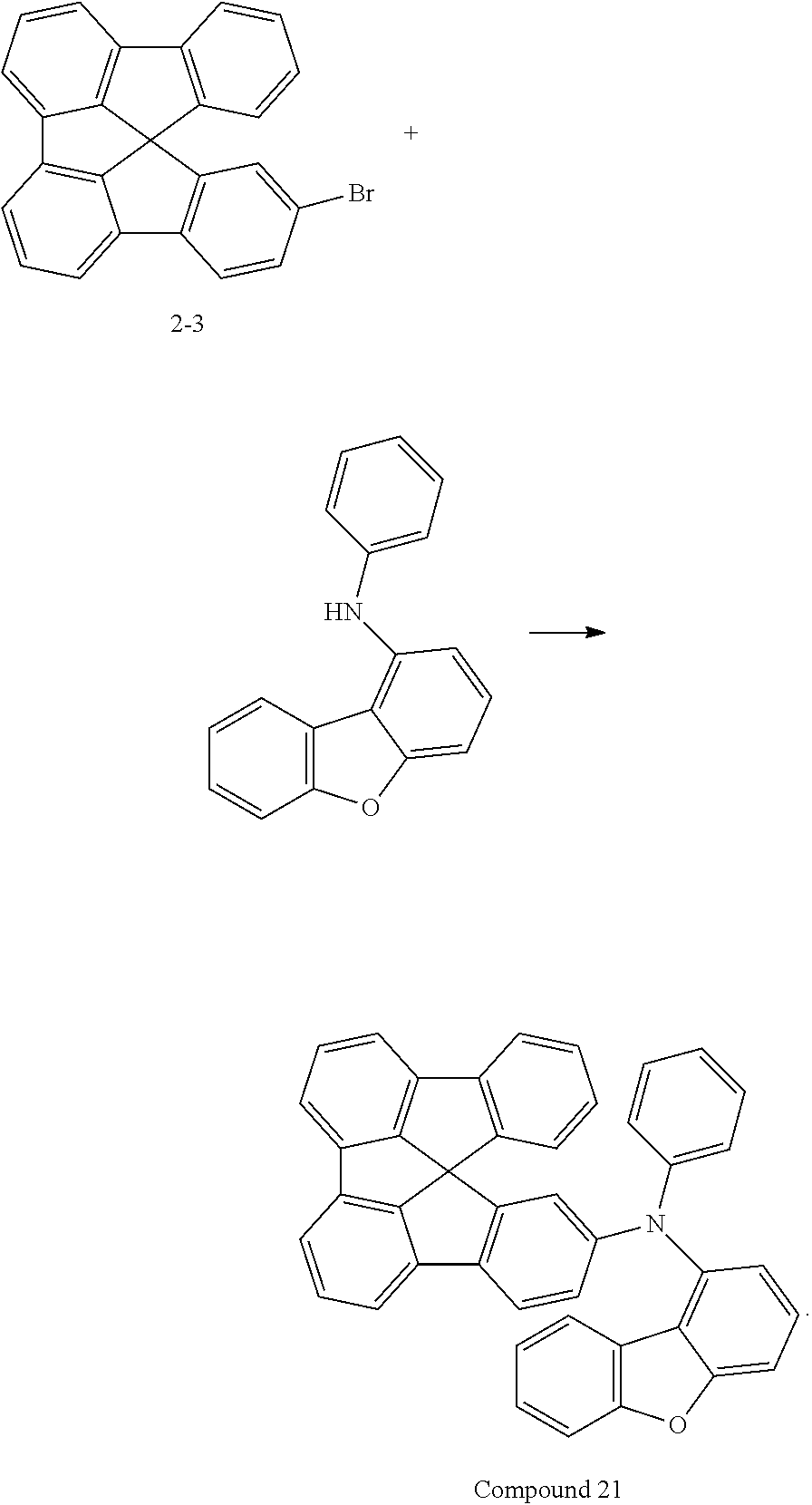
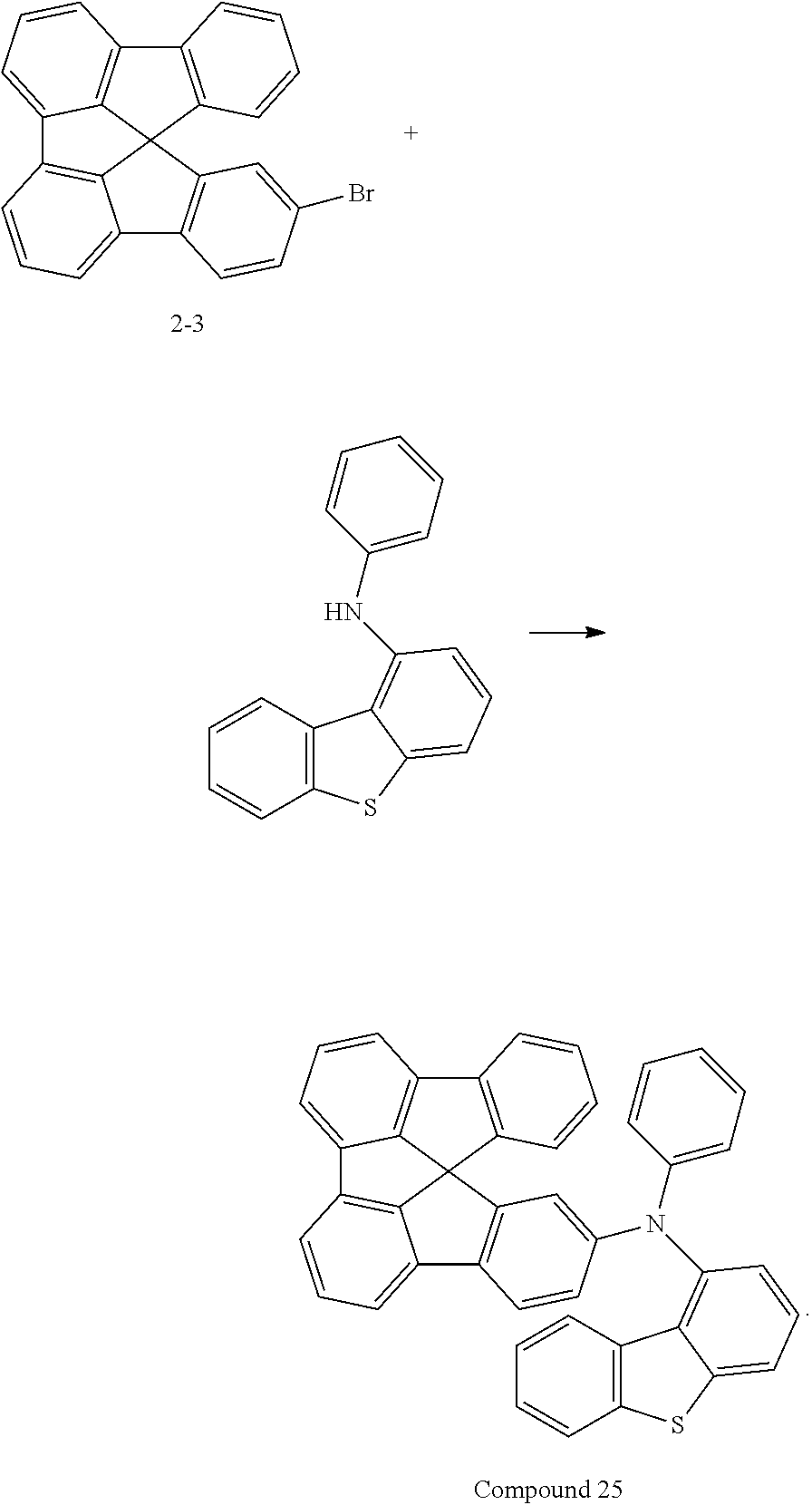


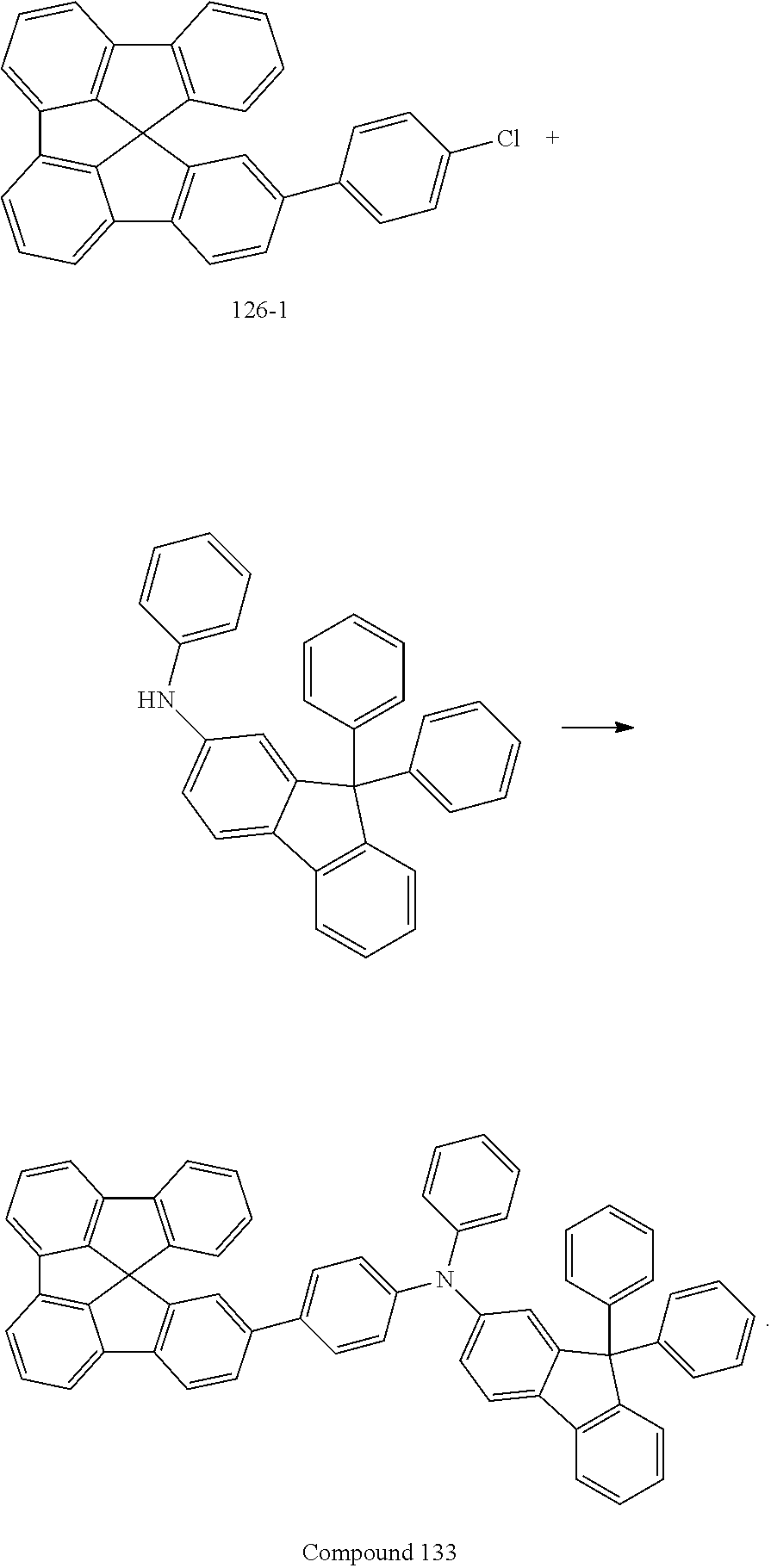
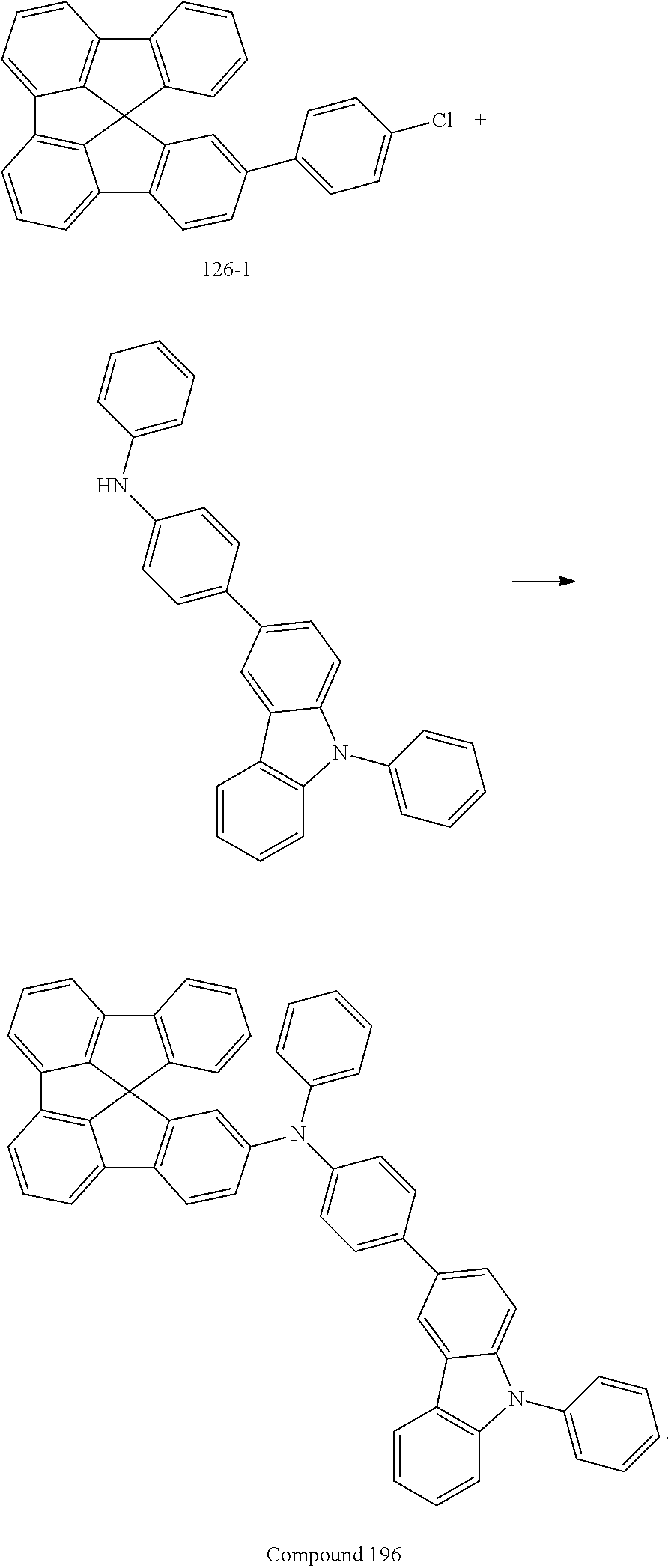
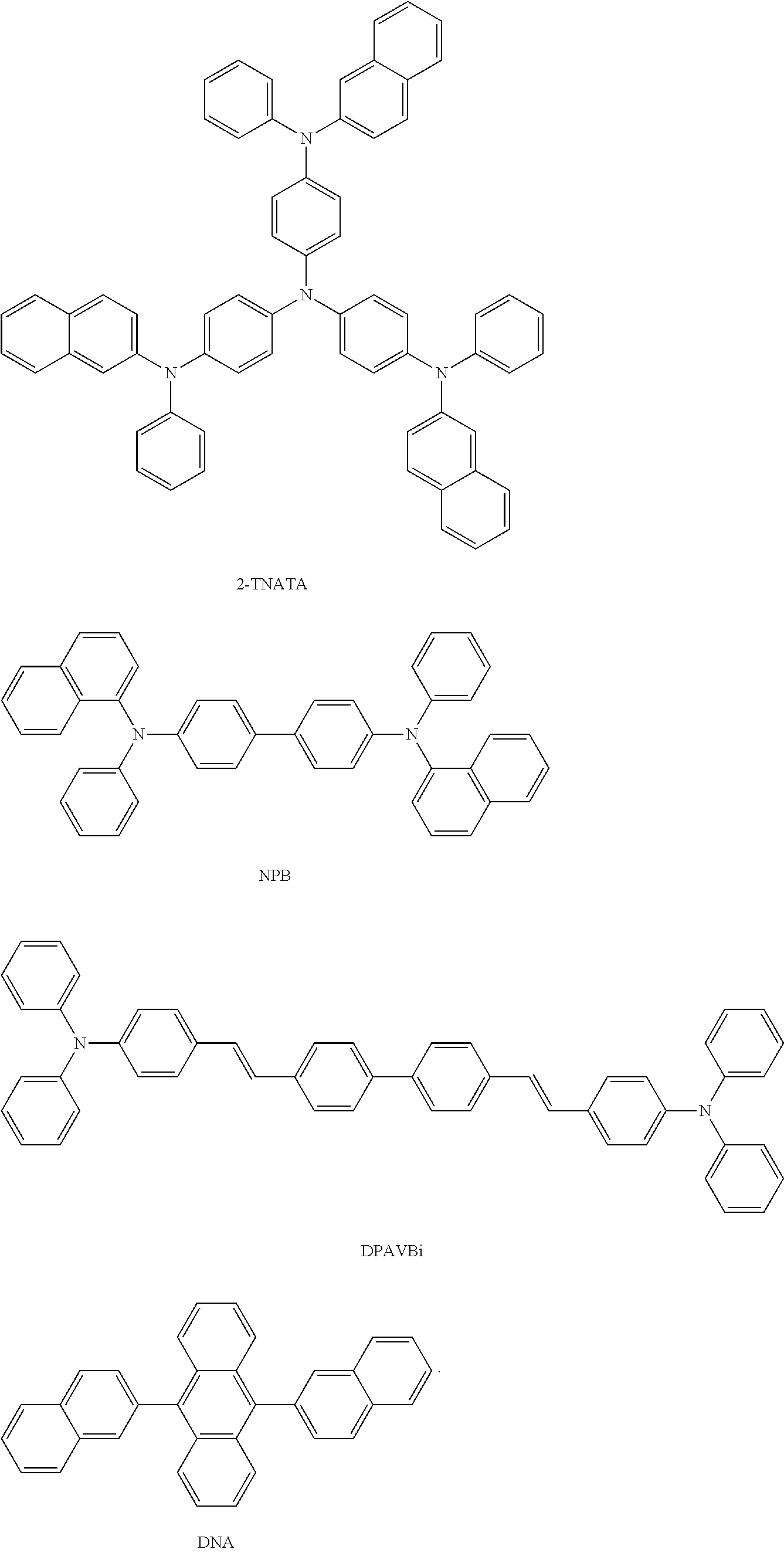


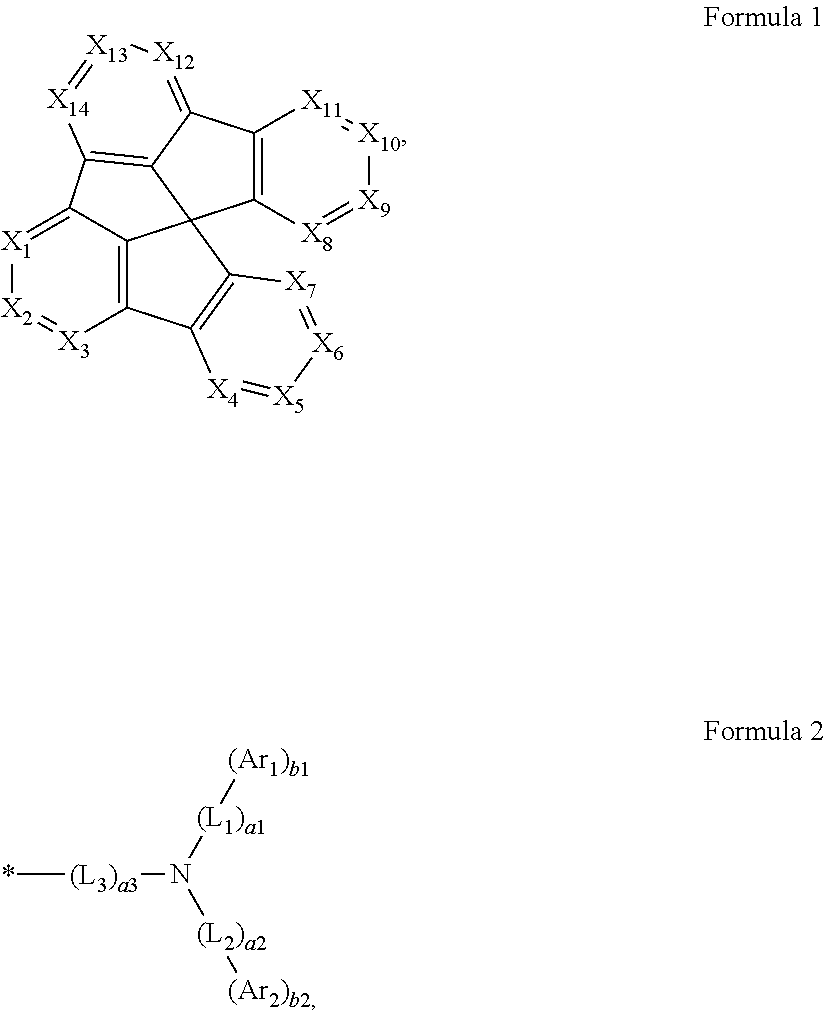

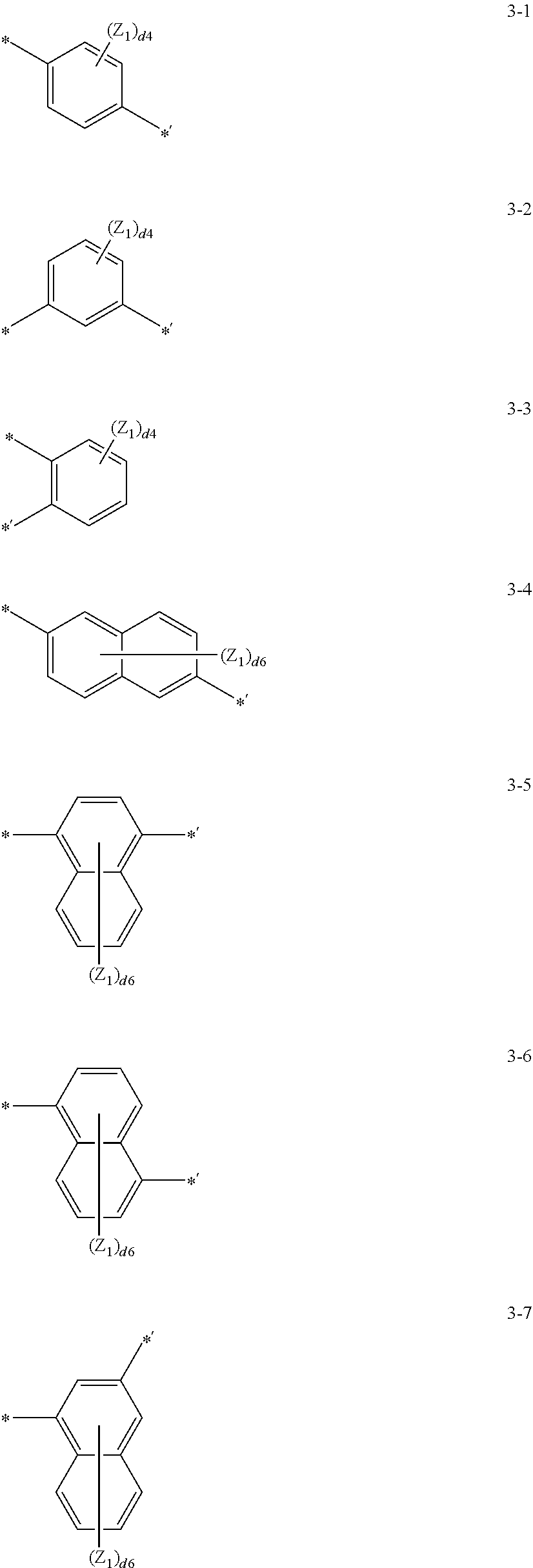




















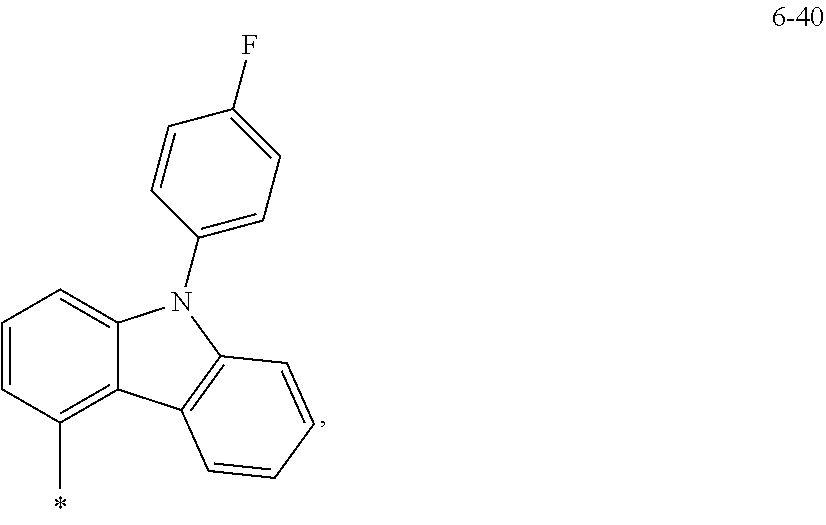















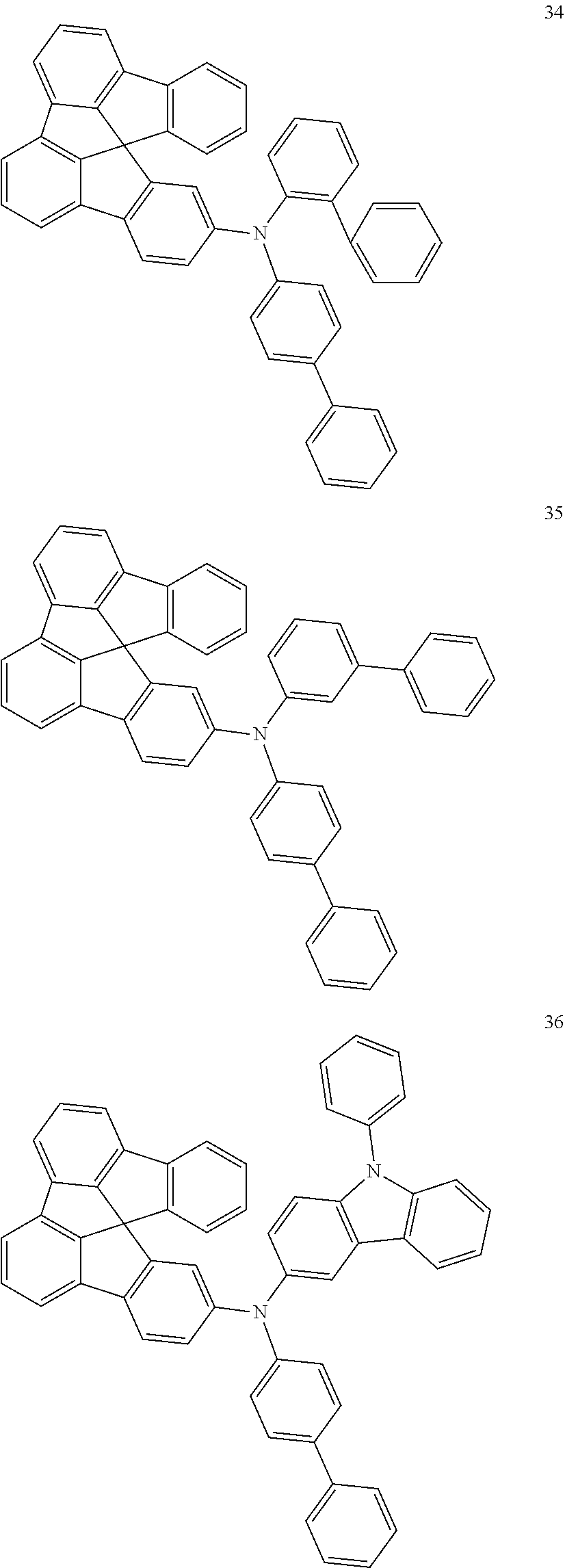




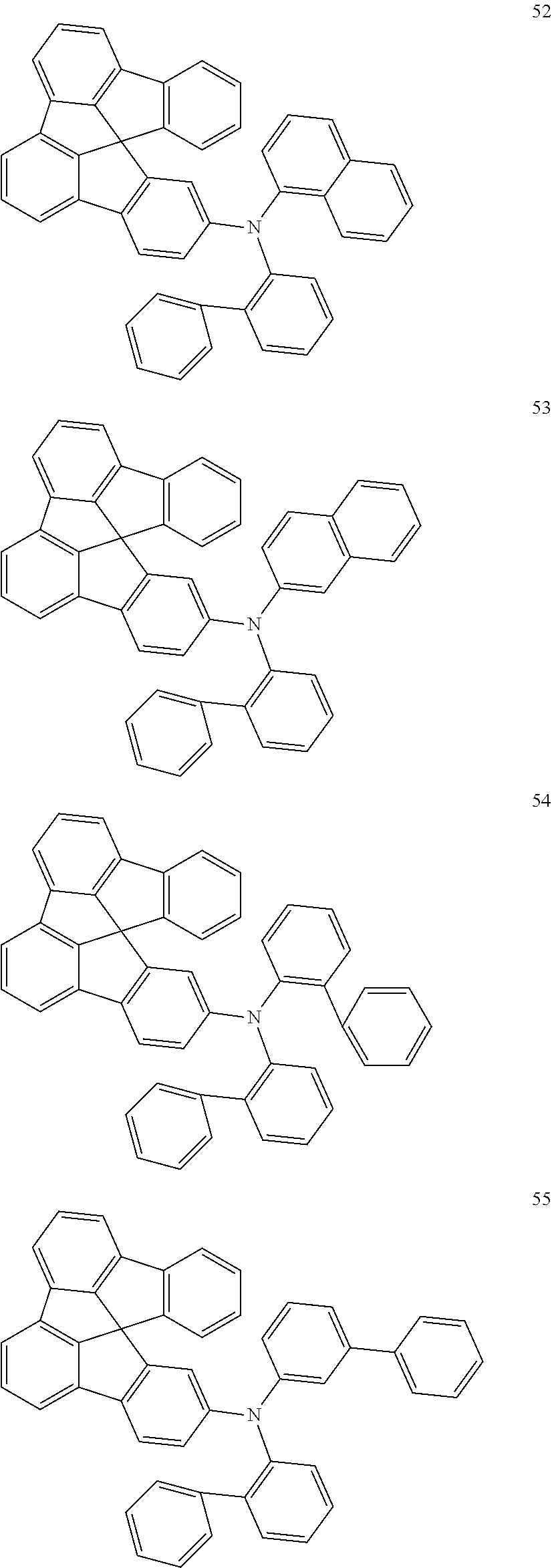













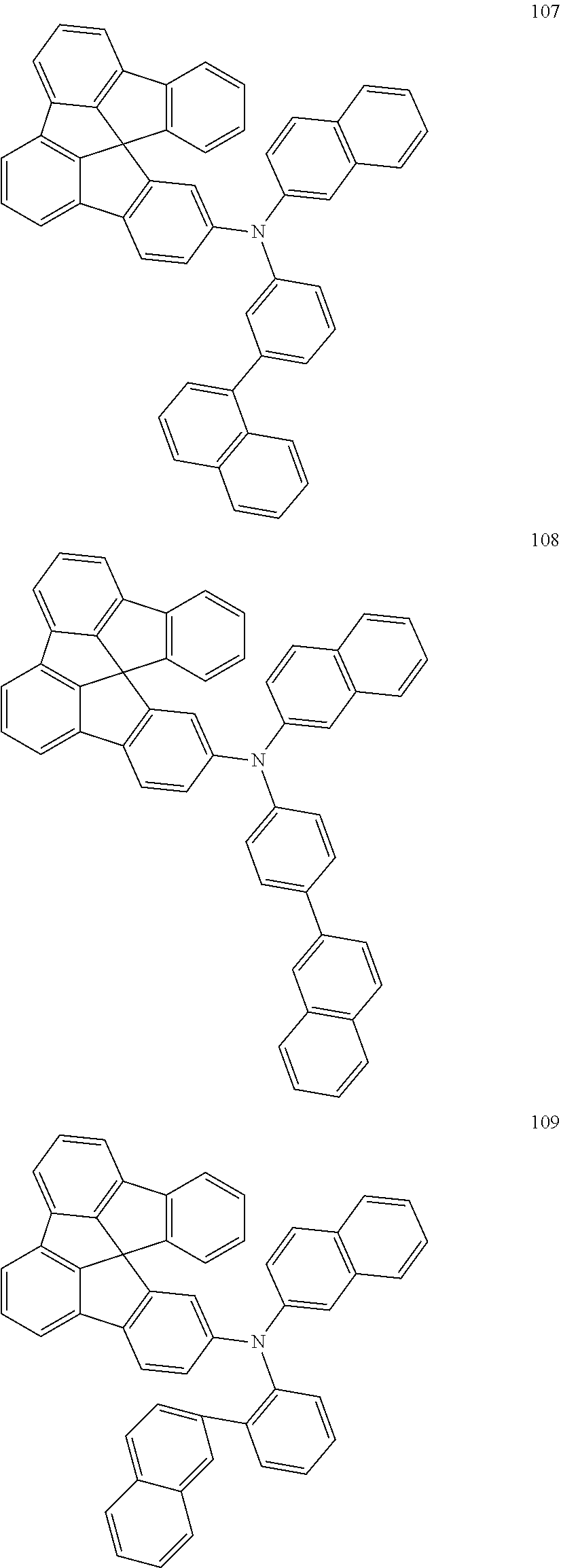











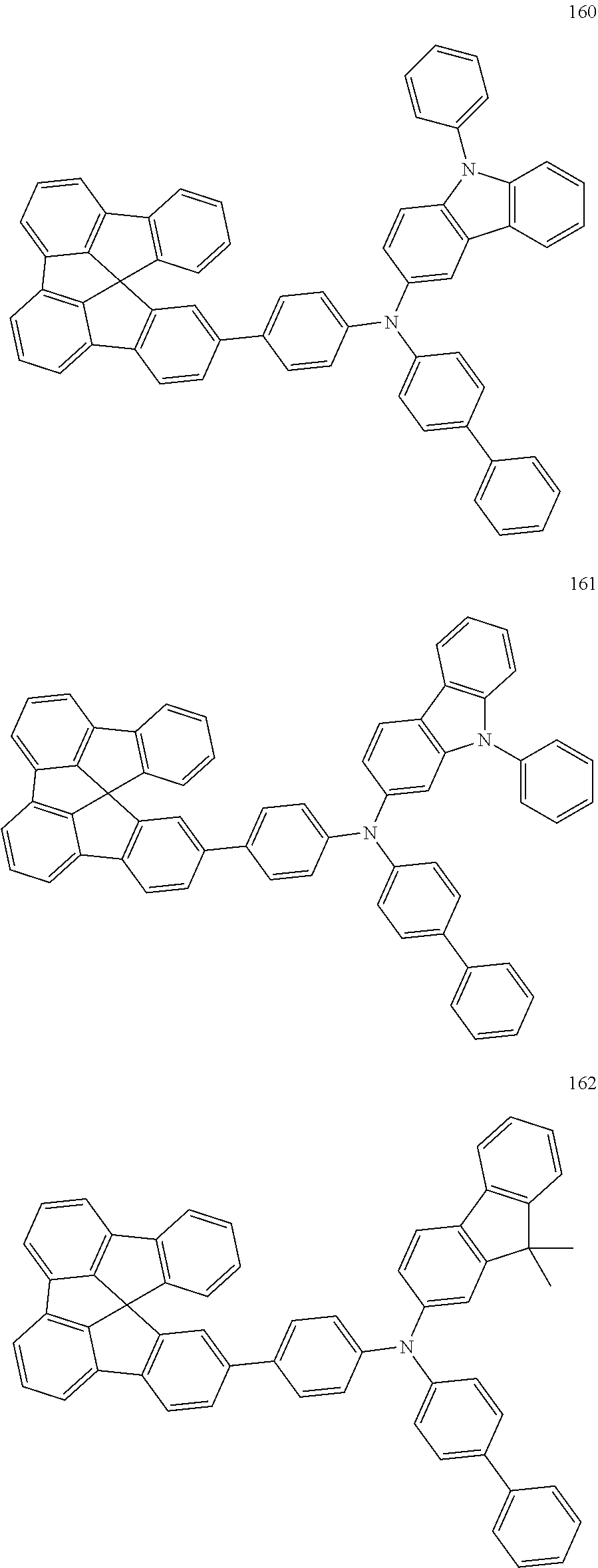

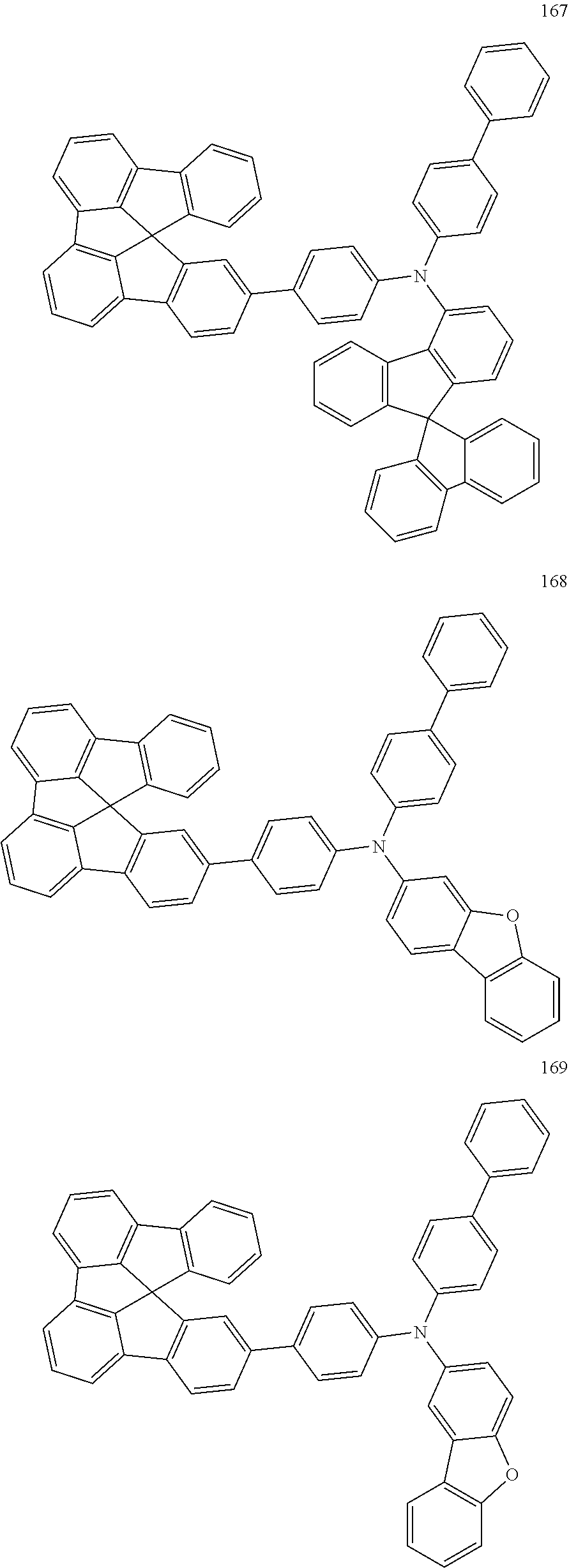




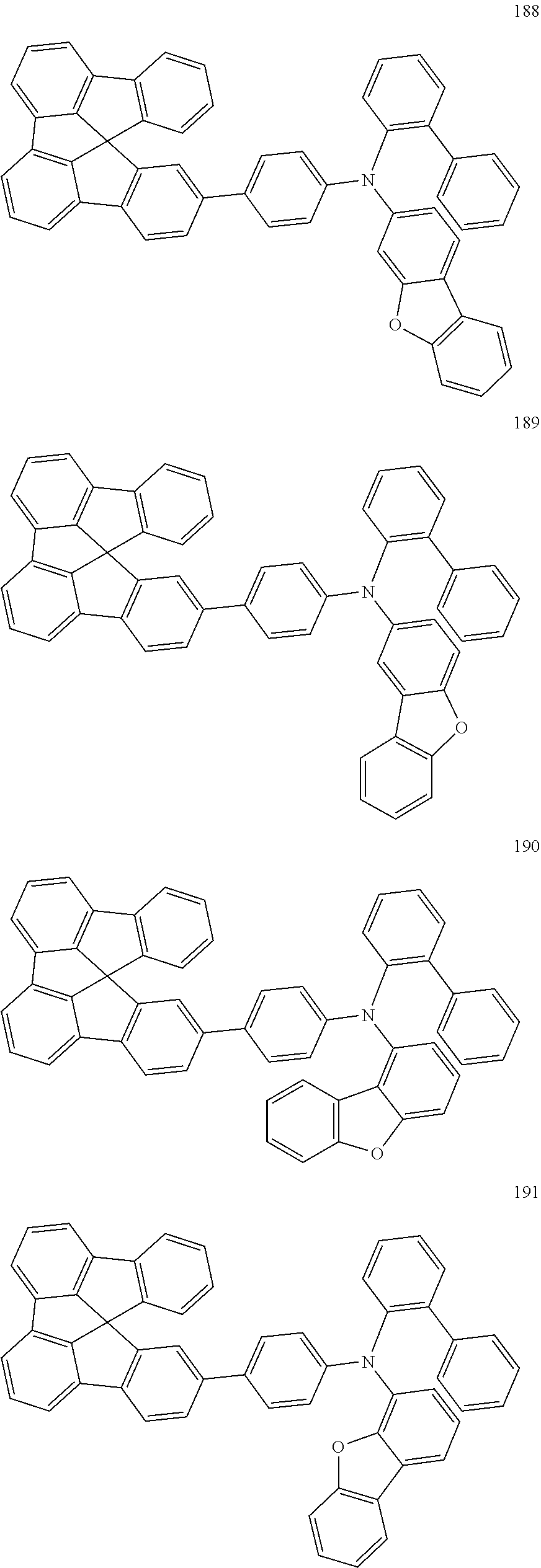








D00000

D00001
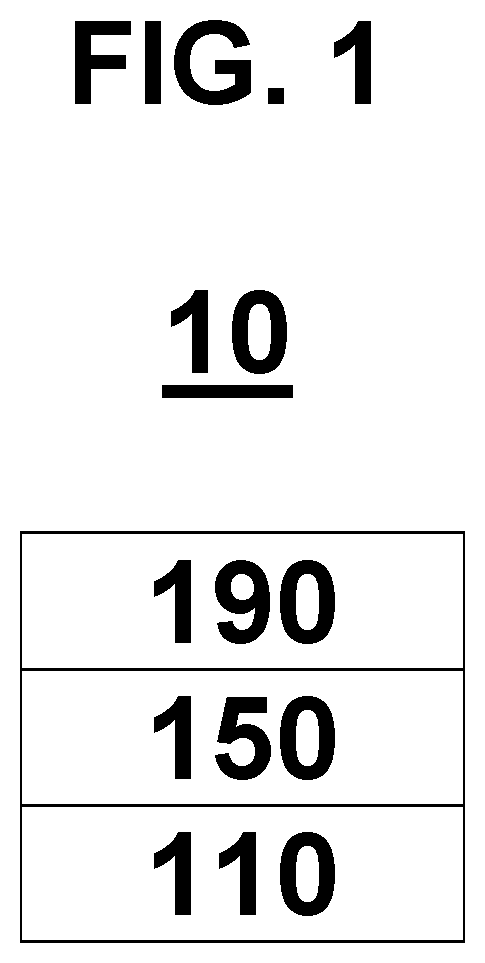
D00002
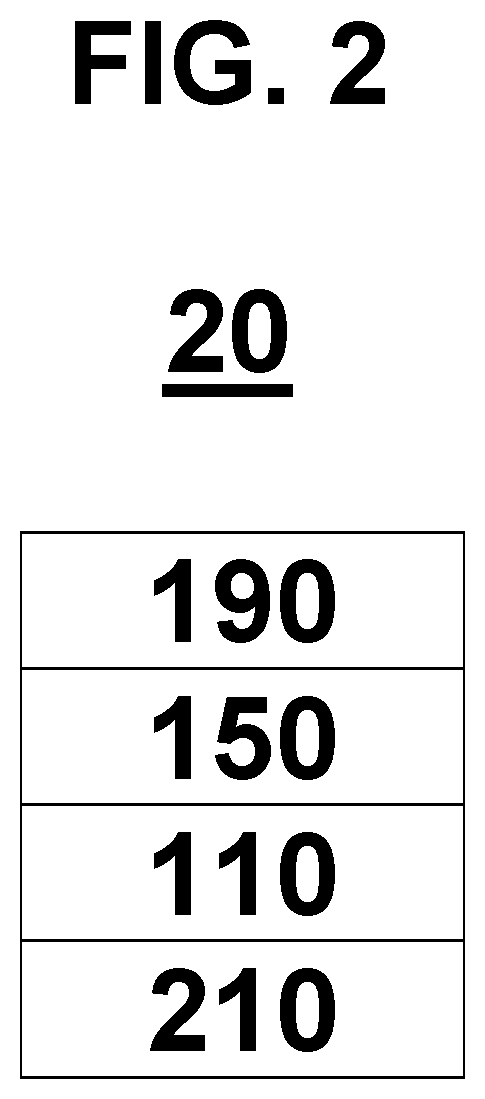
D00003
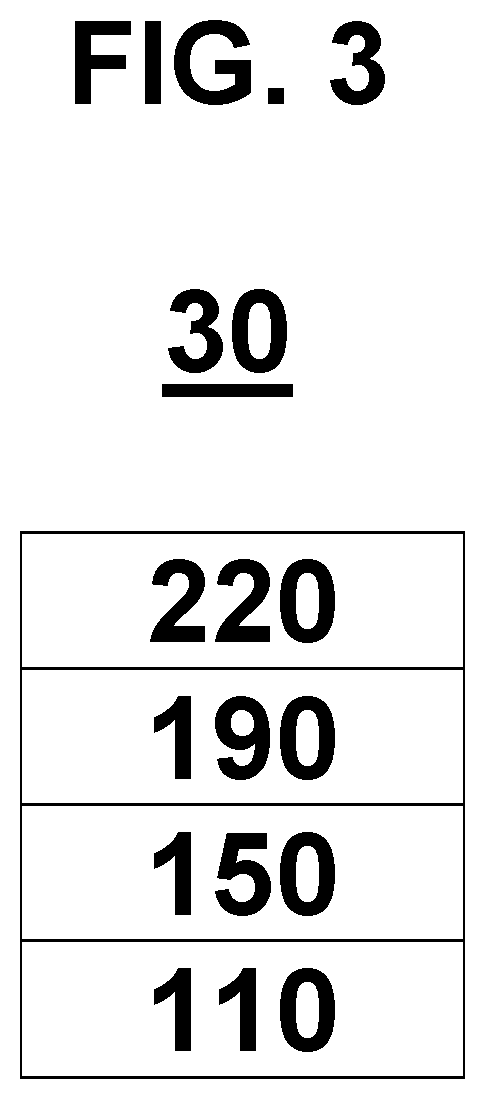
D00004

XML
uspto.report is an independent third-party trademark research tool that is not affiliated, endorsed, or sponsored by the United States Patent and Trademark Office (USPTO) or any other governmental organization. The information provided by uspto.report is based on publicly available data at the time of writing and is intended for informational purposes only.
While we strive to provide accurate and up-to-date information, we do not guarantee the accuracy, completeness, reliability, or suitability of the information displayed on this site. The use of this site is at your own risk. Any reliance you place on such information is therefore strictly at your own risk.
All official trademark data, including owner information, should be verified by visiting the official USPTO website at www.uspto.gov. This site is not intended to replace professional legal advice and should not be used as a substitute for consulting with a legal professional who is knowledgeable about trademark law.